i 2025 RZR 200 Title
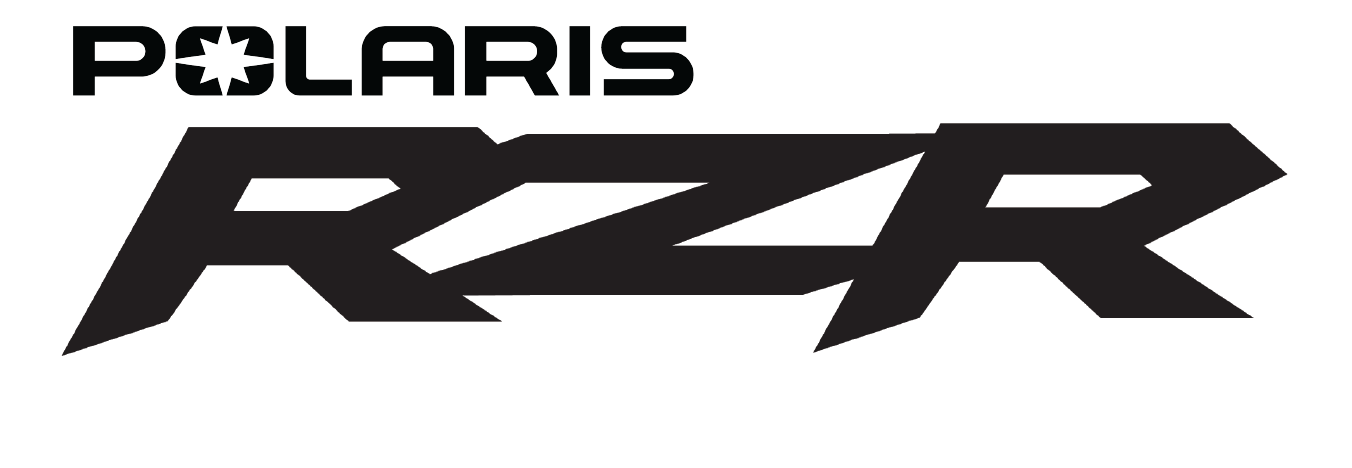
|
| 2025 Owner’s Manual |
| RZR 200 EFI |
The Owner's Manual for this vehicle contains warnings, instructions and other information you must read and fully understand before safely riding or performing maintenance on this vehicle. Always follow the warnings and instructions in Owner's Manual.
Click the link above for the Table Of Contents, or download a full PDF of the Owner Manual in the Owner Support area of Polaris.com.

|
| 2025 Owner’s Manual |
| RZR 200 EFI |
Unless noted, trademarks are the property of Polaris Industries Inc.
Recreational Off-Highway Vehicle Association® and ROHVA® are registered trademarks of the Recreational Off-Highway Vehicle Association. Tread Lightly℠ is a registered trademark of the United States Department of Agriculture. BatteryMINDer® is a registered trademark of VDC Electronics Inc. Loctite® is a registered trademark of Henkel Corporation. NYOGEL® is a registered trademark of Nye Lubricants, Inc. QR Code® is a registered trademark of DENSO WAVE INCORPORATED. Google Play® is a registered trademark of Google, Inc. Apple® is a registered trademark of Apple Inc. NGK® is a registered trademark of NGK Spark Plug Co., Ltd. Bluetooth® is a registered trademark of Bluetooth Sig, Inc. ANSI® is a registered trademark of American National Standards Institute, Inc.
Copyright 2024 Polaris Industries Inc. All information contained within this publication is based on the latest product information at the time of publication. Due to constant improvements in the design and quality of production components, some minor discrepancies may result between the actual vehicle and the information presented in this publication. Depictions and/or procedures in this publication are intended for reference use only. No liability can be accepted for omissions or inaccuracies. Any reprinting or reuse of the depictions and/or procedures contained within, whether whole or in part, is expressly prohibited.
The original instructions for this vehicle are in English. Other languages are provided as translations of the original instructions.
Printed in China
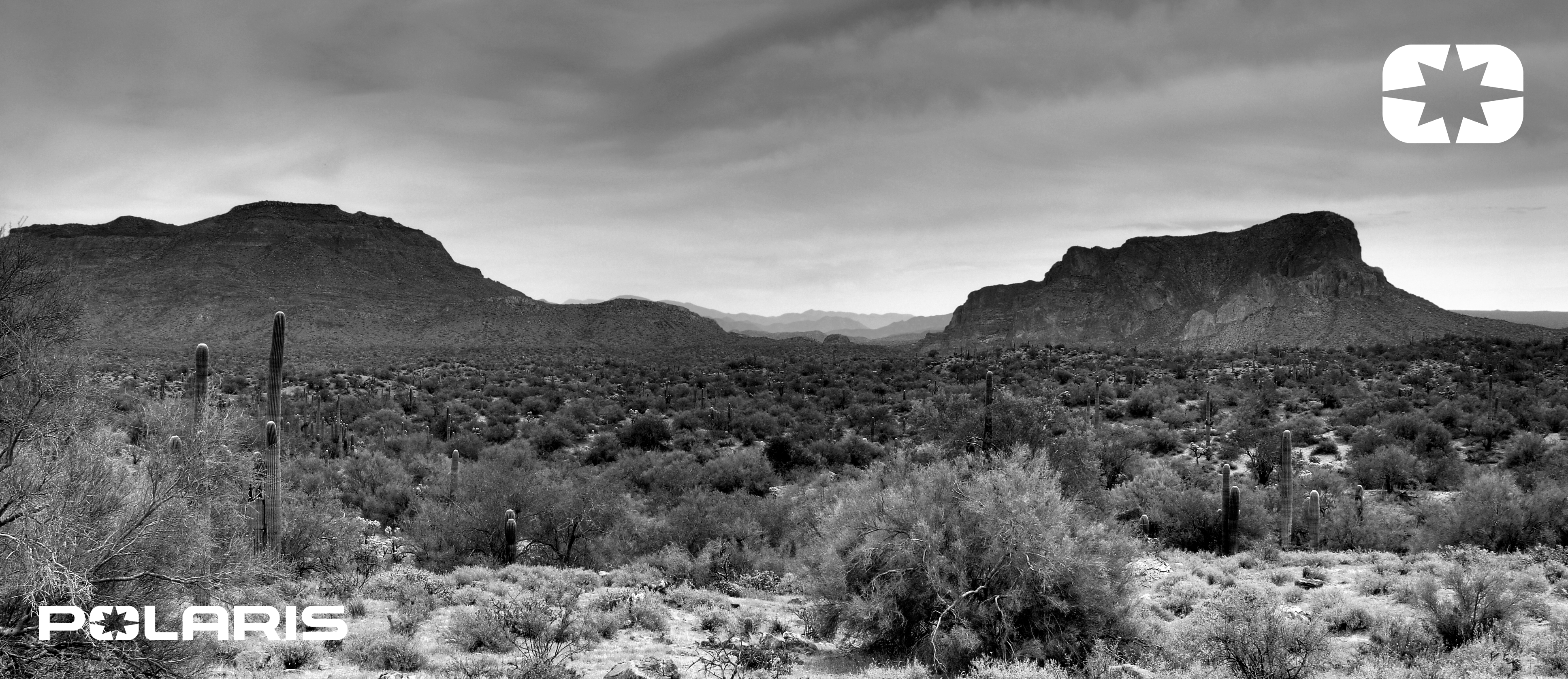
Thank you for purchasing a POLARIS vehicle, and welcome to our world-wide family of POLARIS enthusiasts. Be sure to visit us online at www.polaris.com for the latest news, new product introductions, upcoming events, career opportunities and more.
Here at POLARIS we proudly produce an exciting line of utility and recreational products. We believe POLARIS sets a standard of excellence for all utility and recreational vehicles manufactured in the world today. Many years of experience have gone into the engineering, design, and development of your POLARIS vehicle.
For safe and enjoyable operation of your vehicle, be sure to follow the instructions and recommendations in this owner’s manual. Your manual contains instructions for minor maintenance, but information about major repairs is outlined in the POLARIS Service Manual and can be performed by a POLARIS dealer.
Your POLARIS dealer knows your vehicle best and is interested in your total satisfaction. Your POLARIS dealership can perform all of your service needs during and after the warranty period.
For the most up-to-date owner’s manual visit
https://www.polaris.com/en-us/owners-manuals
.
We believe young operators should have the opportunity to enjoy the Polaris riding experience along with you. We encourage you to teach young operators to ride safely, and to help ensure the future of recreational sports, please teach them to show respect for our environment and for the rights of others while operating the vehicle.
This vehicle is not a toy and can be hazardous to operate. We've provided this owner’s manual and an instructional video to help teach about the safe operation and care of your new Polaris vehicle. Prior to driving or riding in the vehicle, please read and make sure they read this owner’s manual. Watch the instructional video with them. Make sure all operators and passengers understand and follow all of the instructions and warnings contained in this owner’s manual and video. Make sure they understand that the vehicle must be used under adult supervision at all times.
After reading this owner’s manual and watching the video, help all young operators practice the New Operator Driving Procedures outlined in this manual.
Never allow a child under age 10 to operate or ride as a passenger in this vehicle. Young operators differ in skills, physical abilities and judgement. Please supervise the use of the vehicle at all times. Permit continued use only if you determine that the young operator has the ability and maturity to operate safely.
For the young operator’s safety, be sure they can reach and operate all RZR 200 controls, including steering wheel, accelerator and brake pedals, and ignition switch. Make sure the young operator is not too tall to ride safely in this vehicle. See Rider Height.
The vehicle’s speed control system allows a parent or supervising adult to limit vehicle speed for new and inexperienced operators. Please see Max Speed for more information.
The preventive maintenance program outlined in this manual is designed to ensure that all critical components on your vehicle are thoroughly inspected at specific intervals. Always follow all of the instructions and recommendations in this manual to ensure the vehicle remains in safe operating condition at all times.
This Polaris vehicle is not designed for adult use. Serious damage may occur if the maximum weight capacity is exceeded. Refer to vehicle labels and to the Specifications chapter for the maximum weight capacity.
Before you ride your new POLARIS vehicle, there are some important things that you need to know. You must learn how to keep yourself and those around you safe while you're riding.
Your parent or supervising adult and POLARIS want you to be safe while you enjoy riding your new vehicle, and that's why it’s very important that you read this owner’s manual and watch the instructional video. Make sure you understand and follow all of the instructions and warnings in this owner’s manual and video. Ask a parent or supervising adult to explain anything you don't understand.
Your safety and the safety of others is the most important thing to think about at all times. Pay attention when you see this symbol:
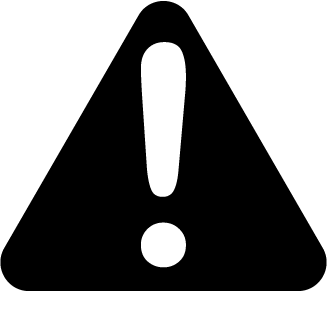
|
This is the safety alert symbol. When you see this symbol on your vehicle or in this manual it means PAY ATTENTION because you could die or be seriously injured if you don't follow the instructions.
After reading this owner’s manual and watching the video, complete the New Operator Driving Procedures. Show your parent or supervising adult that you understand how to drive safely.
Enjoy riding your new Polaris vehicle!
The following signal words and symbols appear throughout this manual and on your vehicle. Your safety is involved when these words and symbols are used. Become familiar with their meanings before reading the manual.
DANGER indicates a hazardous situation which, if not avoided, WILL result in death or serious injury.
WARNING indicates a hazardous situation which, if not avoided, COULD result in death or serious injury.
CAUTION indicates a hazardous situation which, if not avoided, COULD result in minor to moderate injury.
NOTICE provides key information by clarifying instructions.
IMPORTANT provides key reminders during disassembly, assembly, and inspection of components.
The Prohibition Safety Sign indicates an action NOT to take in order to avoid a hazard.
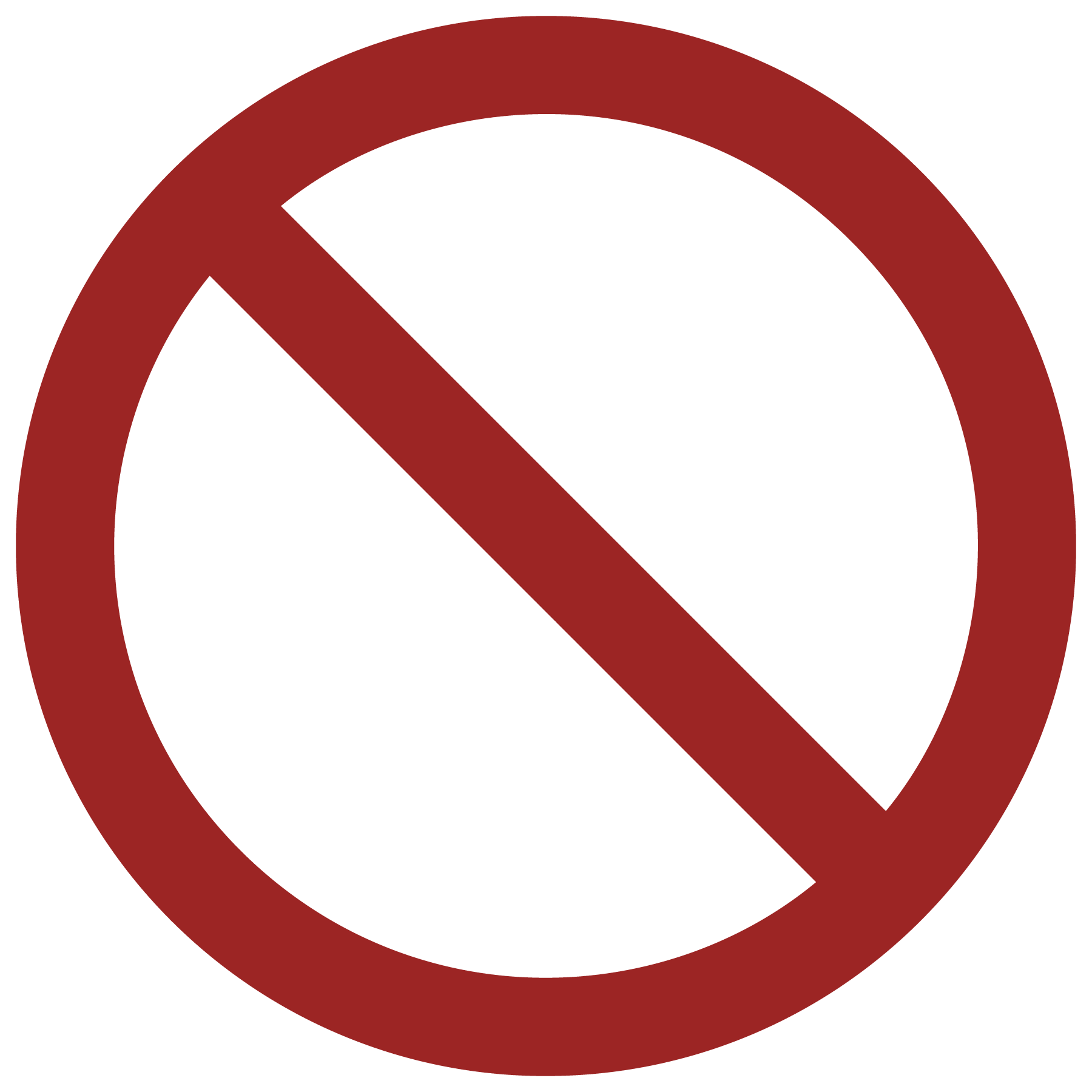
The Mandatory Action Sign indicates an action that NEEDS to be taken to avoid a hazard.

Record your vehicle's identification numbers and key number in the spaces provided. Remove the spare key and store it in a safe place. An ignition key can be duplicated only by ordering a POLARIS key blank (using your key number) and mating it with one of your existing keys. The ignition switch must be replaced if all keys are lost.
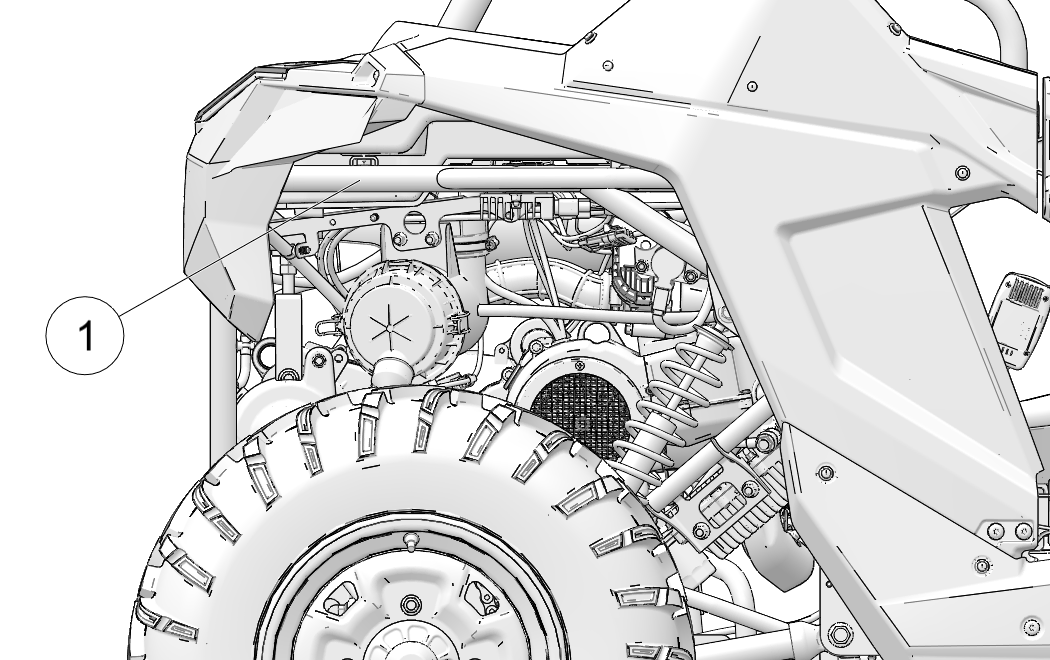
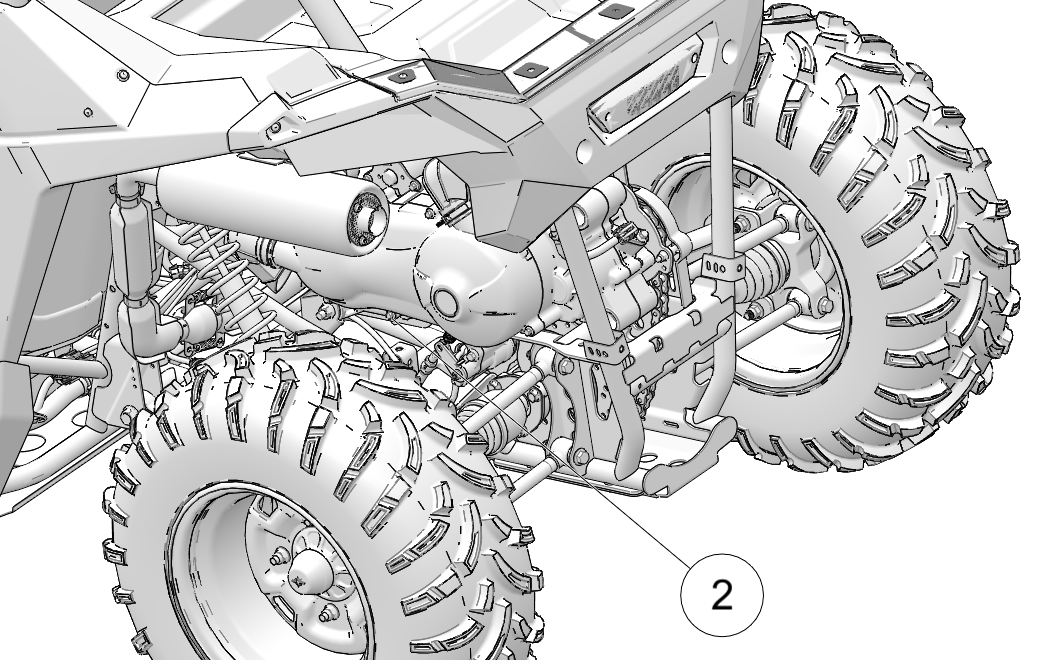
The VIN can be found stamped on a plate 1 riveted to the right rail on the right wheel well of the ORV.
The engine serial number 2 can be found on the clutch-side of the engine case.
| Vehicle Model Number: | |
| Vehicle Identification Number (VIN): | |
| Engine Serial Number: | |
| Key Number |
This vehicle contains the following radio equipment or components that contain radio equipment:
|
COMPONENT |
COMPONENT ID |
MANUFACTURER |
|---|---|---|
|
B1 Gauge Bluetooth® LE |
CYBLE-222014–01 |
Cypress® Semiconductor |
|
Helmet Aware Beacon |
E8 |
Minew® Technologies |
This device complies with part 15 of the FCC Rules. Operation is subject to the following two conditions: (1) This device may not cause harmful interference, and (2) this device must accept any interference received, including interference that may cause undesired operation.
Changes or modifications not expressly approved by the party responsible for compliance could void the user’s authority to operate the equipment.
This vehicle contains the following radio equipment or components that contain radio equipment:
|
COMPONENT |
COMPONENT ID |
MANUFACTURER |
|---|---|---|
|
B1 Gauge Bluetooth® LE |
CYBLE-222014–01 |
Cypress® Semiconductor |
|
Helmet Aware Beacon |
E8 |
Minew® Technologies |
This device contains license-exempt transmitter(s)/receiver(s) that comply with Innovation, Science and Economic Development Canada’s license-exempt RSS(s). Operation is subject to the following two conditions:
This device may not cause interference.
This device must accept any interference, including interference that may cause undesired operation of the device.
This vehicle contains the following radio equipment or components that contain radio equipment:
|
COMPONENT |
B1 Gauge Bluetooth® LE |
Helmet Aware Beacon |
|
COMPONENT ID |
CYBLE-222014–01 |
E8 |
|
MANUFACTURER |
Cypress® Semiconductor |
Minew® Technologies |
|
TRANSMITTING FREQUENCY |
2402–2480 MHz |
2402–2480 MHz |
|
MAX RF TRANSMITTING PWR |
0.00078 W |
0.00116 W |
Hereby, Polaris Industries Inc. declares that the above radio equipment is in compliance with Directive 2014/53/EU.
The full text of the EU declaration of conformity is available at the following internet address:
https://www.polaris.com/en-us/radio-conformity/
Your POLARIS vehicle is designed to provide safe operation when used as directed.
The POLARIS limited warranty on your POLARIS vehicle will be terminated if any non-POLARIS-approved equipment and/or modifications have been added to the vehicle that increase speed or power.
Protective gear reduces the chance of injury.
The driver and passenger must wear:
1 Helmet
2 Eye Protection
3 Long-Sleeve Shirt
4 Gloves
5 Long Pants
6 Over-the-Ankle Boots
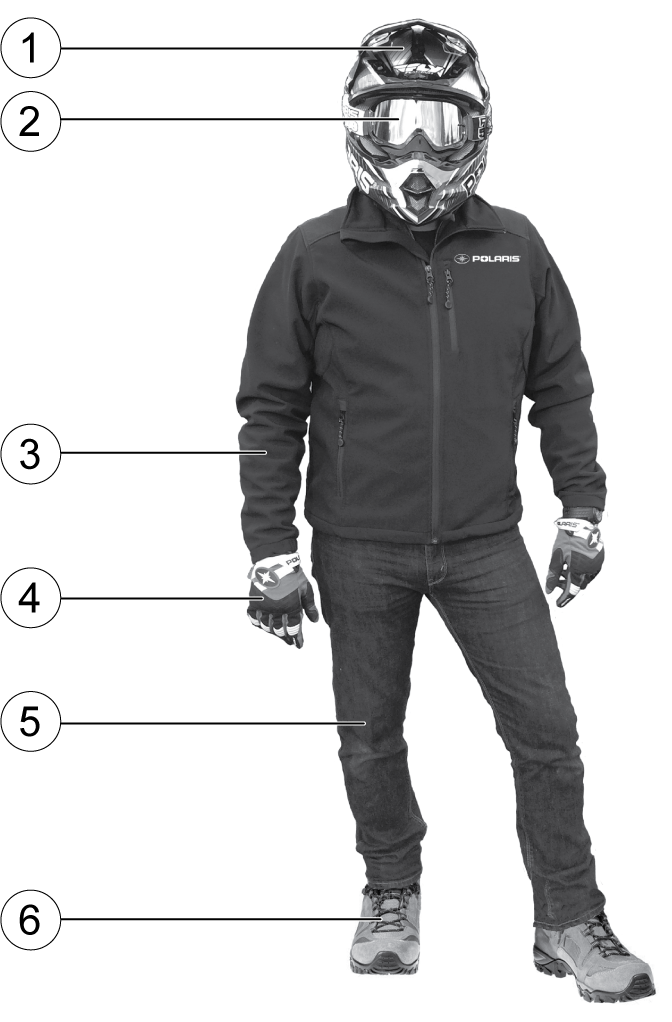
Wearing a helmet can prevent a severe head injury. Whenever riding this POLARIS vehicle, always wear a helmet that meets or exceeds established safety standards. Always buckle and pull straps tight to ensure the helmet is secured.
Parents and supervising adults should verify a helmet fits properly. If a helmet doesn't fit, a new one should be obtained in the proper size.
Approved helmets in the USA and Canada bear a U.S. Department of Transportation (DOT) label.
Approved helmets in Europe, Asia and Oceania bear the ECE 22.05 (or newer) label. The ECE mark consists of a circle surrounding the letter E, followed by the distinguishing number of the country which has granted approval. The approval number and serial number will also be displayed on the label.
Do not depend on eyeglasses or sunglasses for eye protection. Whenever riding this POLARIS vehicle, always wear shatterproof goggles or use a shatterproof helmet face shield. POLARIS recommends wearing approved Personal Protective Equipment (PPE) bearing markings such as VESC 8, V-8, Z87.1, or CE. Make sure protective eye wear is kept clean.
Wear long sleeves and long pants to protect arms and legs.
Wear gloves for comfort and for protection from sun, cold weather and other elements.
Wear sturdy over-the-ankle boots for support and protection. Never ride a POLARIS vehicle with bare feet or sandals.
Under certain operating conditions, heat generated by the engine and exhaust system can elevate temperatures in the driver and passenger cab area. The condition occurs most frequently when a vehicle is being operated in high ambient temperatures at low speeds and/or high load conditions for an extended period of time. The use of certain windshield, roof and/or cab systems may contribute to this condition by restricting airflow. Any discomfort due to heat buildup in this area can be minimized by wearing proper riding apparel and by varying speeds to increase airflow.
Failure to operate this vehicle properly can result in a collision, loss of control, accident or rollover, which may result in serious injury or death. Heed all safety warnings outlined in this section of the owner’s manual.
Be sure to read all of the following warnings about driving hazards and how to avoid them. These warnings are provided for your child's safety. Be sure to explain to your young driver that the hazards outlined in this section of this owner’s manual MUST be avoided at all times. See the OPERATION section of this owner’s manual for proper operating procedures.
FOR MORE INFORMATION ABOUT SAFETY call POLARIS at 1–800–342–3764.
Operating this vehicle without proper
instruction increases the risk of an accident. The operator must
understand how to operate the vehicle properly in different situations
and on different types of terrain. Take a training course and complete
the steps outlined in the New Operator Driving Procedures section.
All operators must read and understand the
owner's manual and all warning and instruction labels before operating
the vehicle.

Never allow a guest to operate this vehicle until the guest has completed the steps outlined in the New Operator Driving Procedures section.
This vehicle is for recreational
use by young operators under adult supervision ONLY.
Operation is prohibited for anyone under 10 years of age. Never
operate with a passenger under age 10.
All operators and riders must be able to sit with backs against
the seat, both feet flat on the floor and both hands on the steering
wheel (if driving) or on a passenger hand hold.
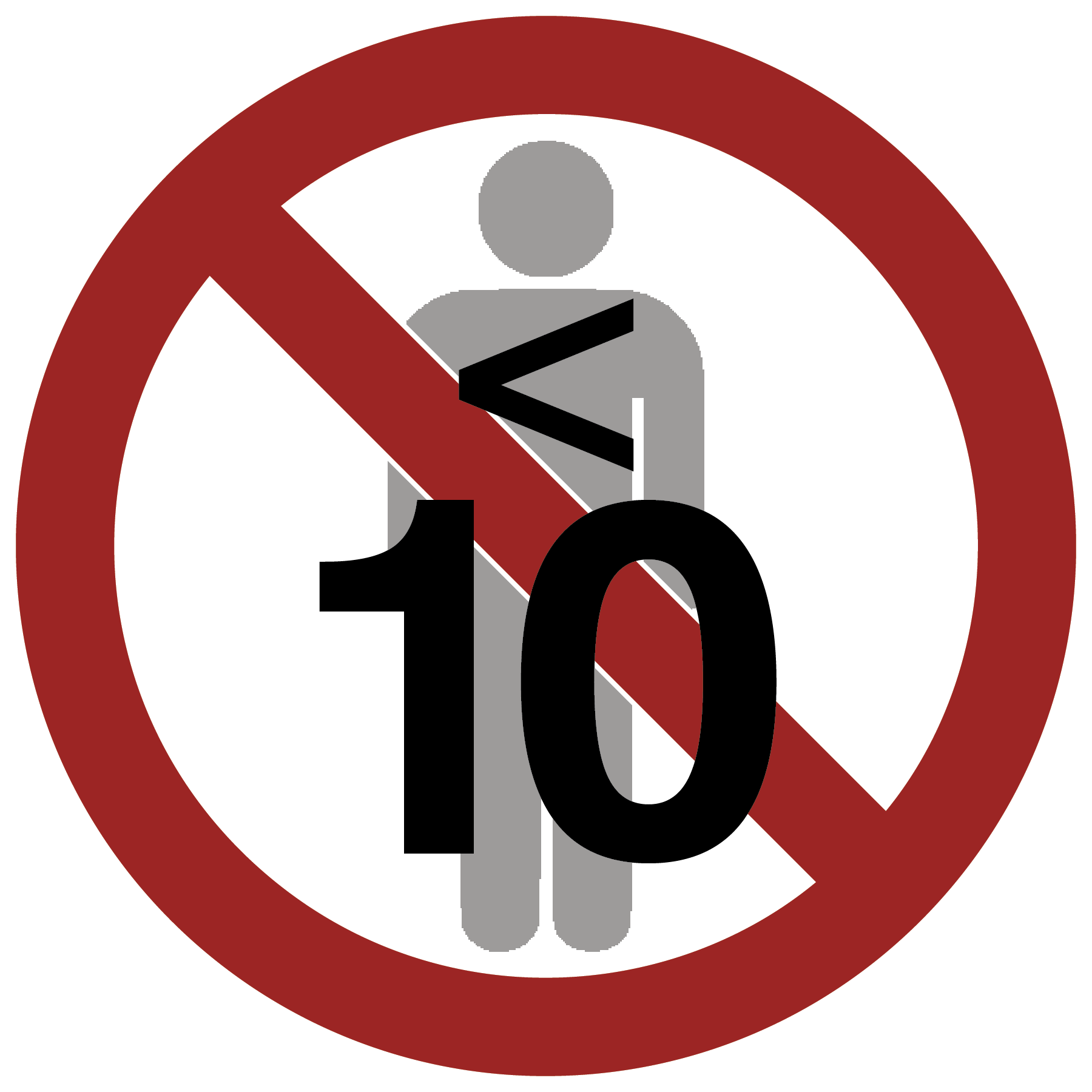
Some riders may be too tall to ride safely in this vehicle. Do not operate or ride in this vehicle if the clearance between the top of your helmet and the overhead cab frame is less than 2 inches (5 cm).
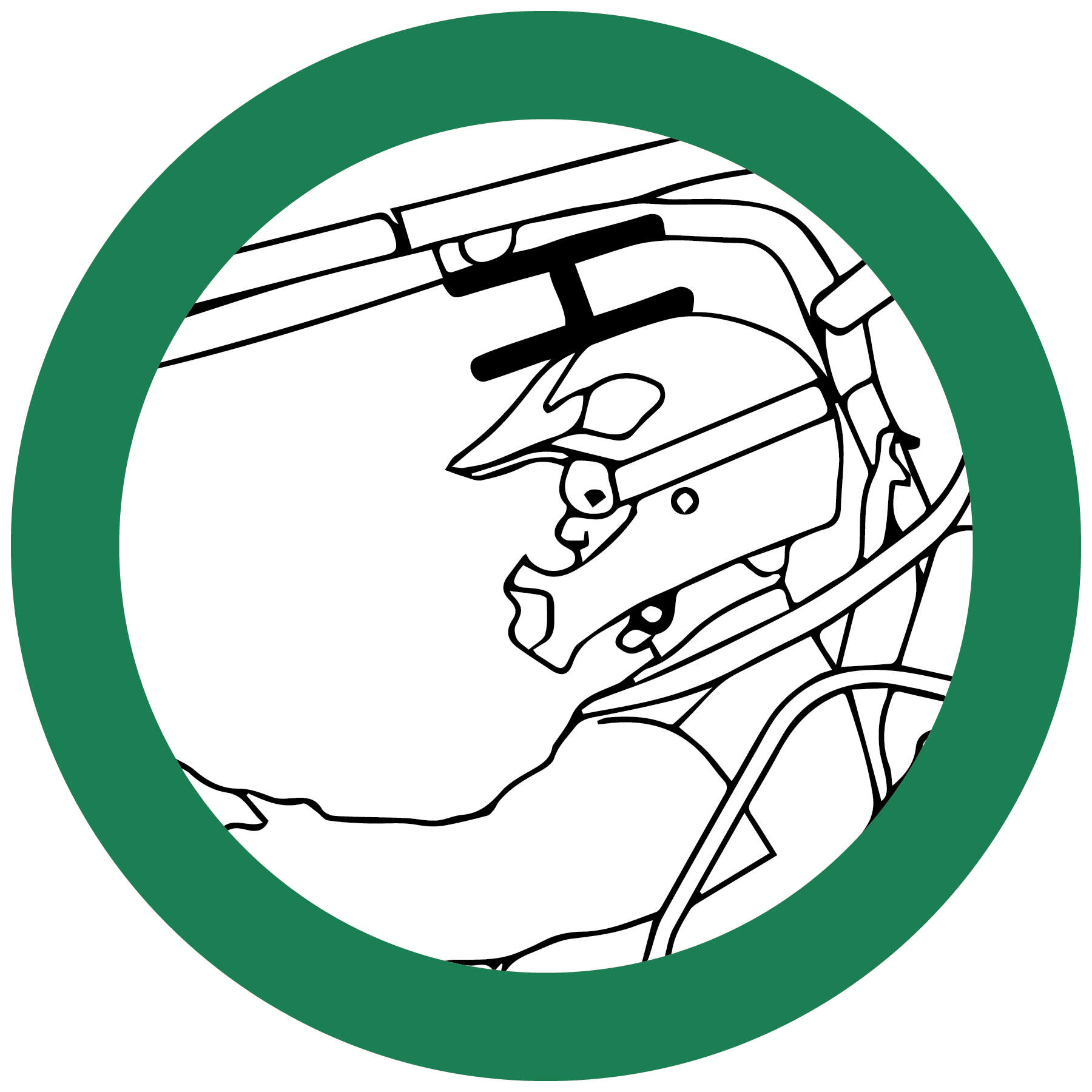
Never consume alcohol or drugs before
or while operating this vehicle.
Operating
this vehicle after consuming alcohol or drugs could adversely affect
operator judgment, reaction time, balance and perception.
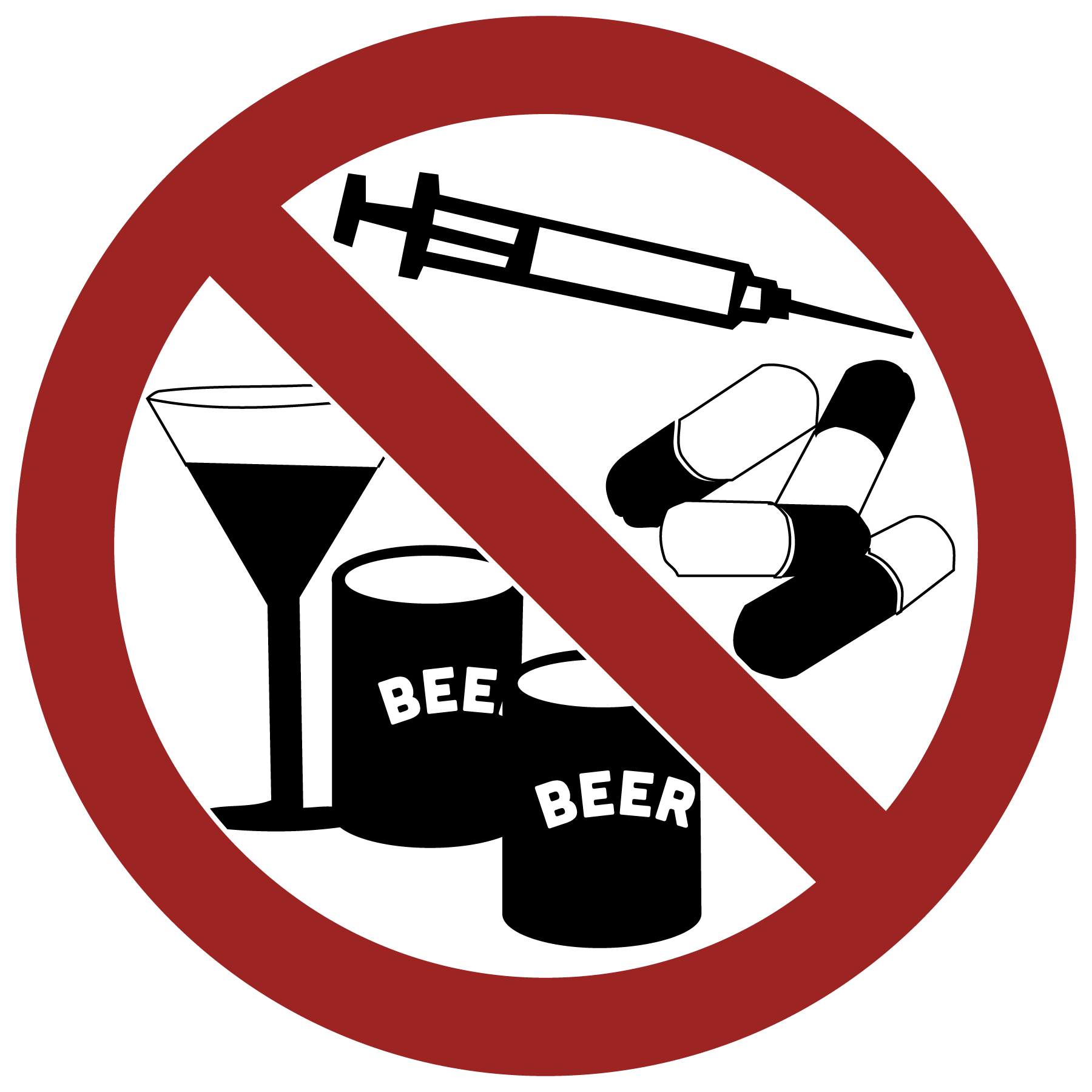
Riding in this vehicle without wearing
an approved helmet and protective eyewear increases the risk of a
serious injuries in the event of an accident.
Operator and all passengers must always wear a helmet, eye protection,
gloves, long-sleeve shirt, long pants and over-the-ankle boots.
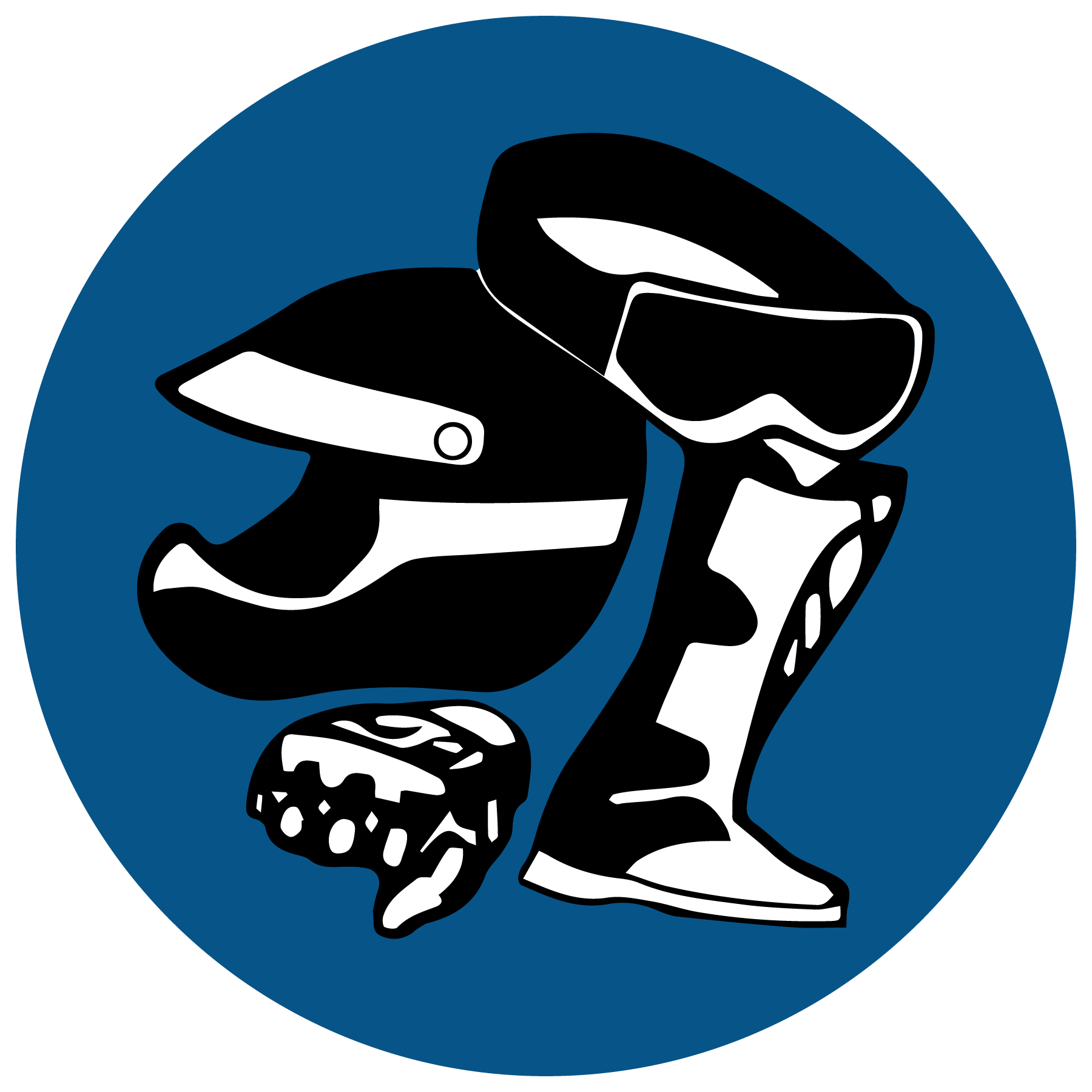
Riding in this vehicle without wearing the seat belt increases the risk of serious injury in the event of rollover, loss of control, other accident or sudden stop. Seat belts may reduce the severity of injury in these circumstances.
All riders must wear seat belts at all times.
Riding in this vehicle without using the cab nets (or doors, if equipped) increases the risk of serious injury or death in the event of an accident or rollover. Always use the cab nets (or doors) while riding in this vehicle. Always keep hands and feet inside the vehicle at all times.
Never carry a passenger until you
have operated this vehicle for at least four hours and have completed
the steps in the New Operator Driving Procedures section.
A passenger must always be seated in a passenger seat with seat
belt secured. Carrying more than one passenger in a 2-seat vehicle
can affect the operator’s ability to steer and operate the
controls, which increases the risk of loss of control and accident
or rollover.
Never carry more than one passenger in
a 2-seat vehicle.
The weight of both cargo and vehicle occupants impacts vehicle operation and stability. For your safety and the safety of others, carefully consider how your vehicle is loaded and how to safely operate the vehicle. Follow the instructions in this manual for loading, tire pressure, gear selection and speed.
Do not exceed vehicle weight capacities. The vehicle’s maximum weight capacity is listed in the specifications section of this manual and on a label on the vehicle. When more passenger weight is added, cargo weight may need to be reduced accordingly.
The recommended tire pressures are listed in the specifications section of this manual and on a label on the vehicle.
Always follow these guidelines:
| Under ANY of these conditions: | Do ALL of these steps: |
| Passenger and/or cargo exceeds half the maximum weight capacity |
|
| Operating in rough terrain | |
| Operating over obstacles | |
| Climbing an incline |
Carrying a passenger in the cargo box could result in a fall from the vehicle or contact with moving components. Never allow a passenger to ride in the cargo box. A passenger must always be seated in a passenger seat with seat belt secured.
This vehicle's tires are designed for off-road use, not for use on pavement. Operating this vehicle on paved surfaces (including sidewalks, paths, parking lots and driveways) may adversely affect the handling of the vehicle and may increase the risk of loss of control and accident or rollover. Avoid operating the vehicle on pavement. If it's unavoidable, travel slowly, travel short distances and avoid sudden turns or stops.
Operating this vehicle on public streets, roads or highways could result in a collision with another vehicle. Never operate this vehicle on any public street, road or highway, including dirt and gravel roads (unless designated for off-highway use).
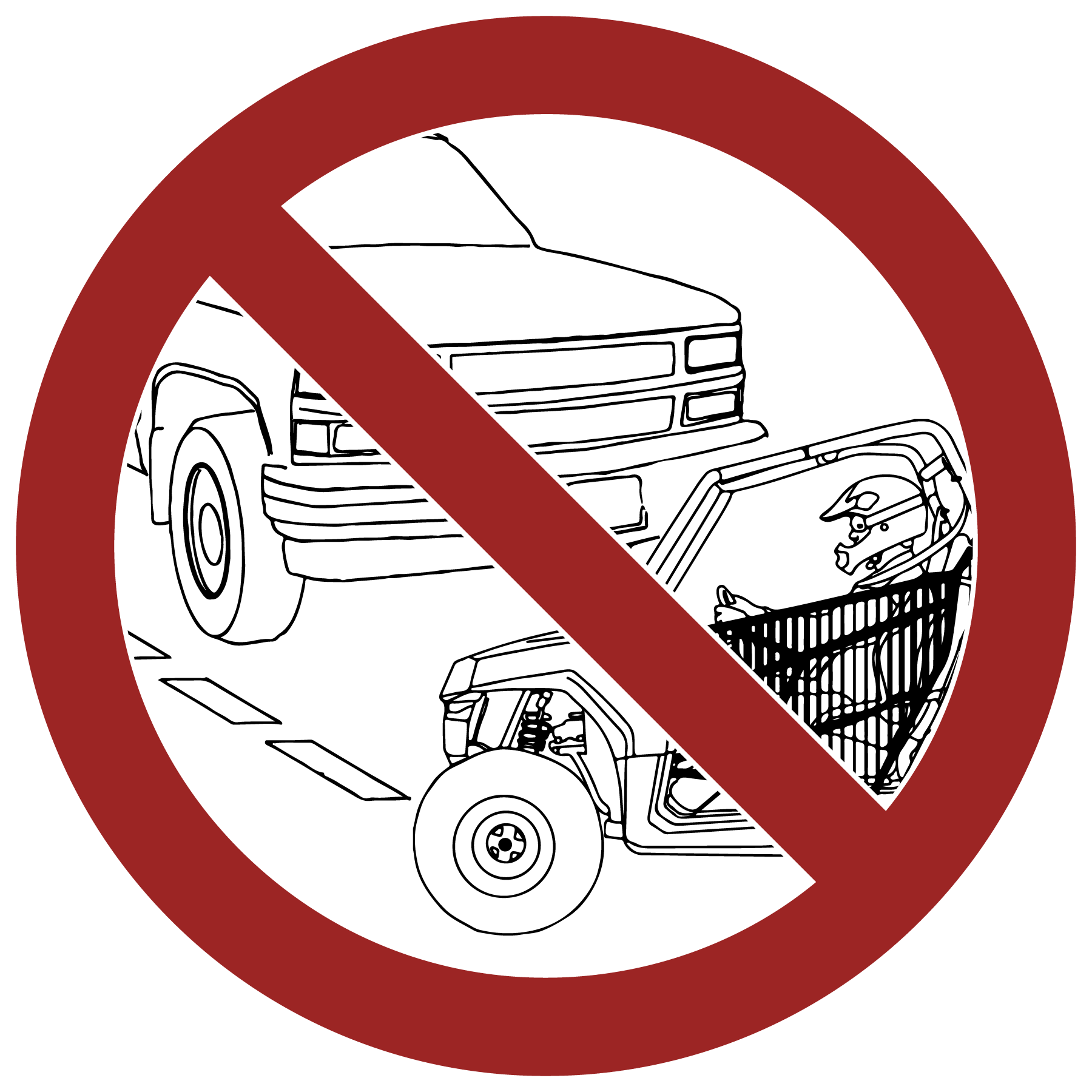
Exhibition driving increases the risk of an accident or rollover. DO NOT do power slides, “donuts”, jumps or other driving stunts. Avoid exhibition driving.
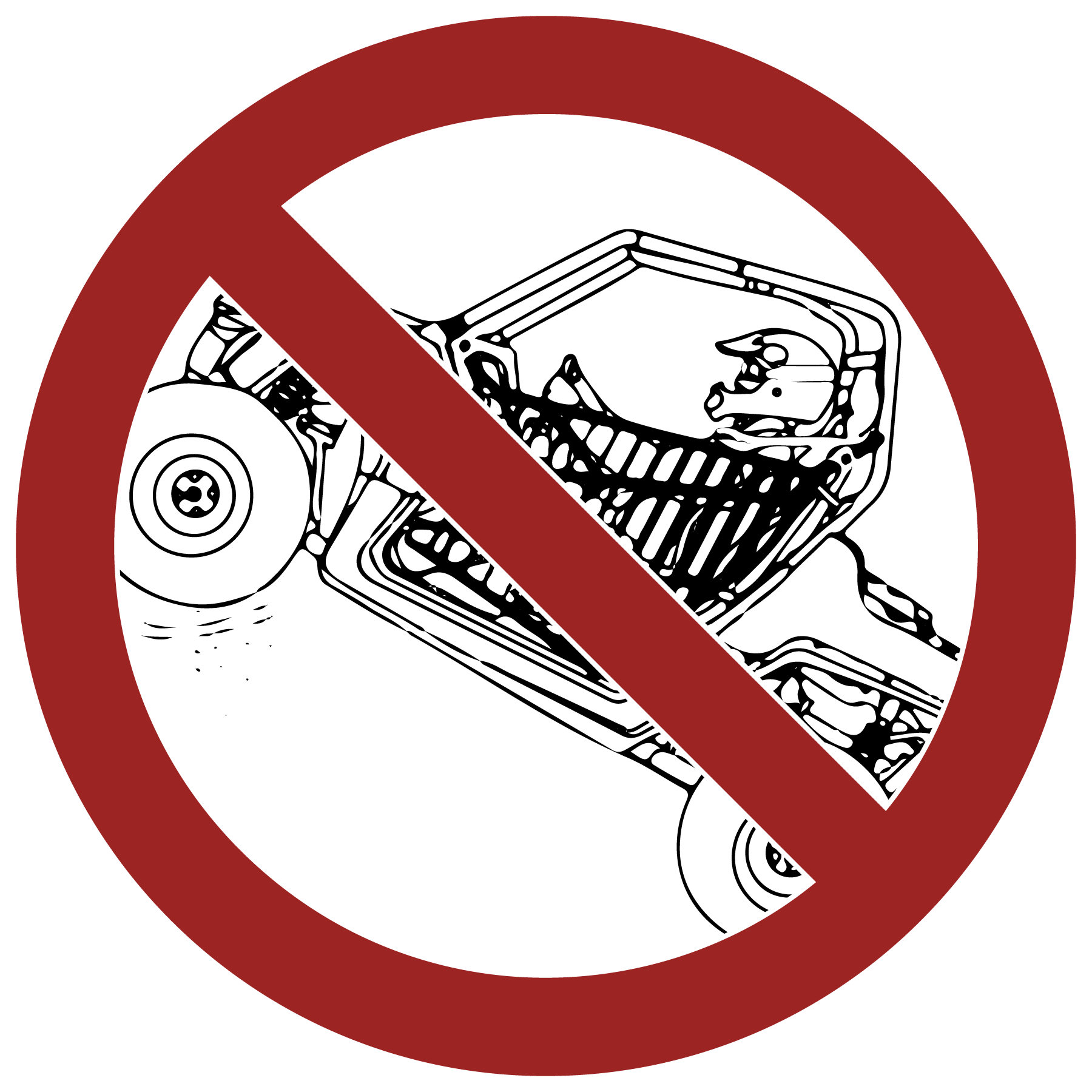
Operating this vehicle at excessive speeds increases the operator's risk of losing control. Always operate at a speed that's appropriate for the terrain, the visibility and operating conditions, your skills and experience and any passenger’s skills and experience.
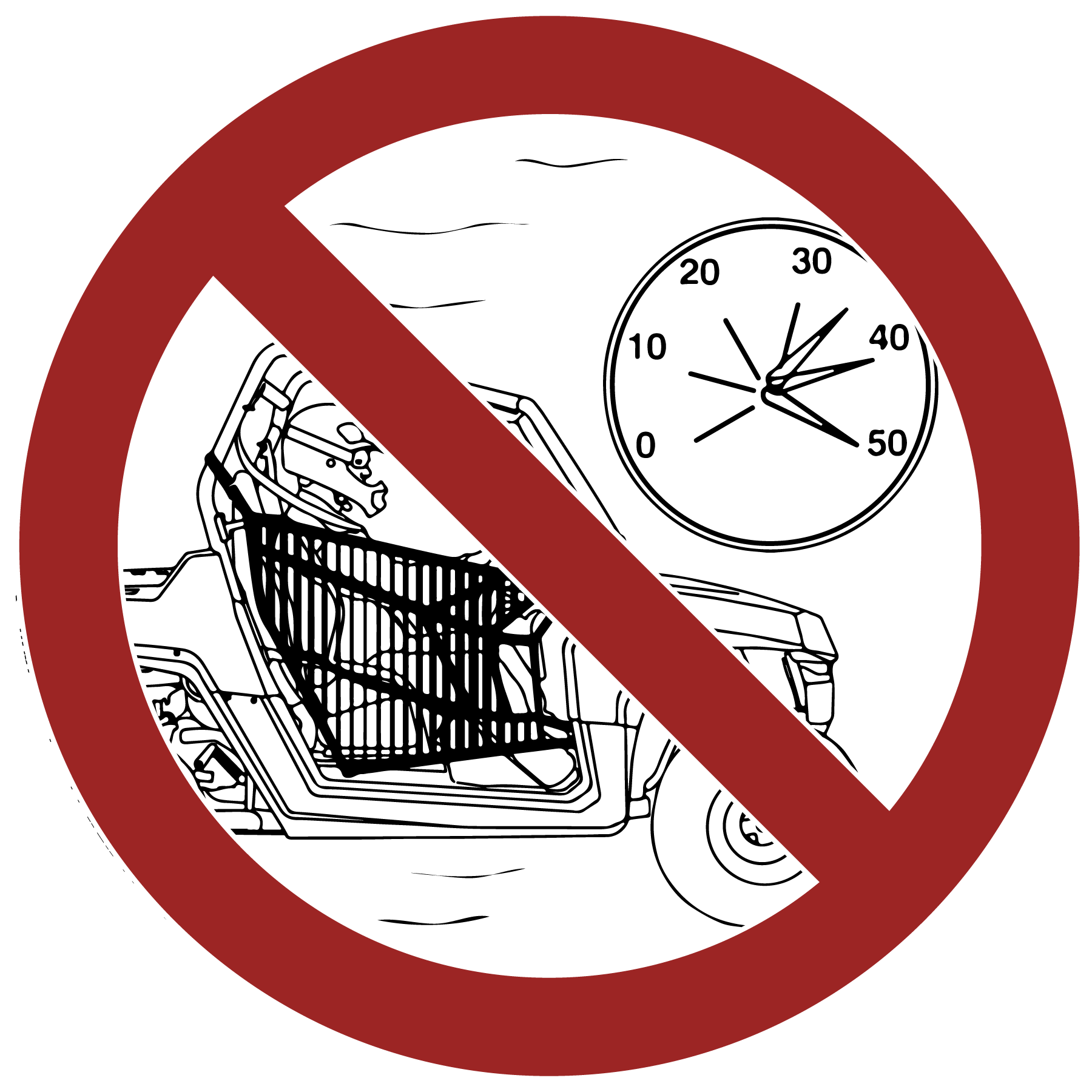
Removing hands from the steering wheel or hand holds or removing feet from the floor while riding increases the risk of loss of control and accident or rollover.
The operator should always keep both hands on the steering wheel during operation. A passenger should always be seated in the passenger seat with both feet on the floor and with both hands securely grasping the hand holds.
Always keep hands and feet inside the vehicle at all times.
Turning improperly could cause loss of traction, loss of control, accident or rollover. Always follow proper procedures for turning as described in this owner's manual.
Avoid sharp turns. Never turn while applying heavy throttle. Never make abrupt steering maneuvers. Practice turning at slow speeds before attempting to turn at faster speeds.
Improper hill climbing could cause loss of control or rollover. Use extreme caution when operating on hills. Always follow proper procedures for hill climbing as described in this owner's manual. See the Driving Uphill section for details.
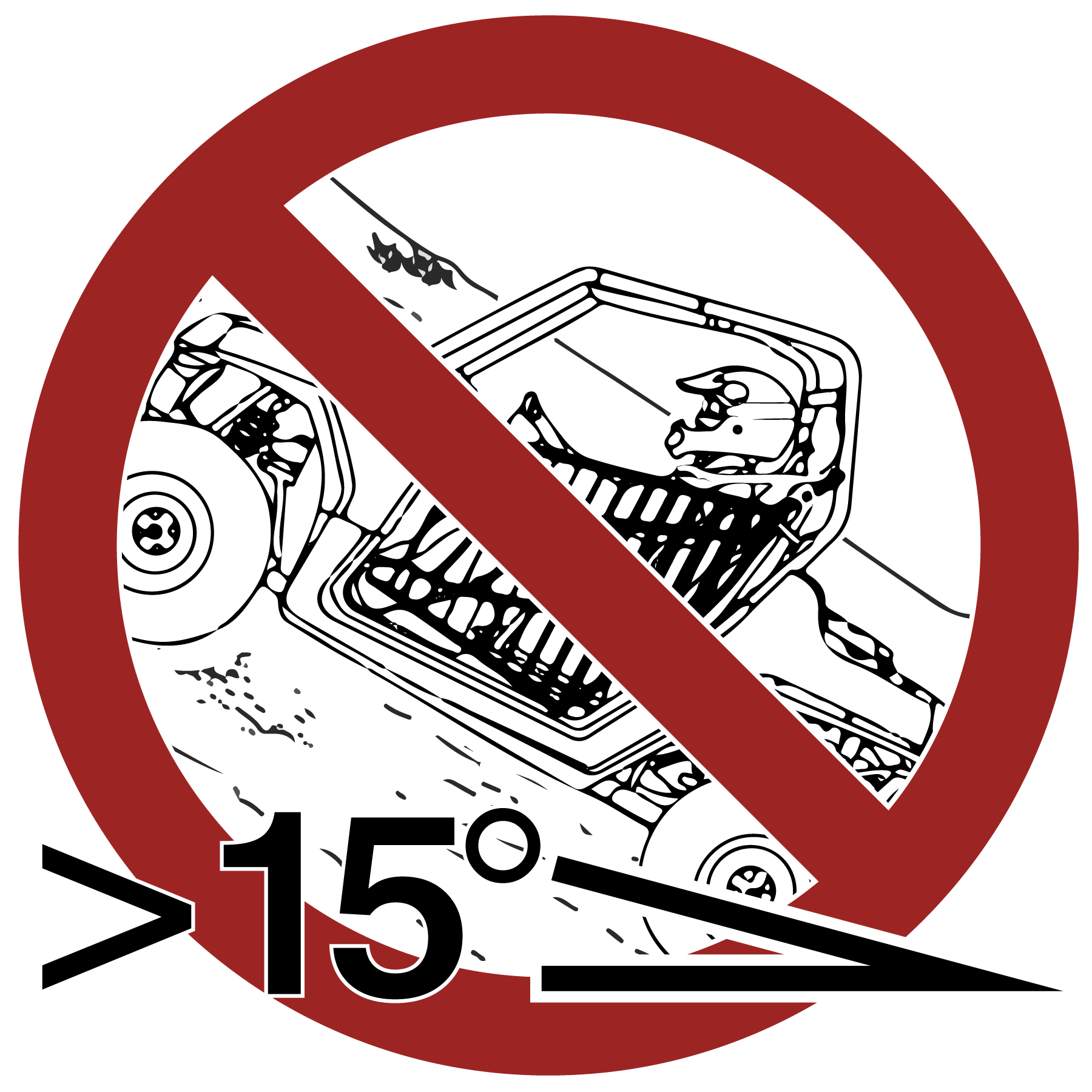
Improperly descending a hill could cause loss of control or rollover. Always follow proper procedures for traveling down hills as described in this owner’s manual. See the Driving Downhill section for details.
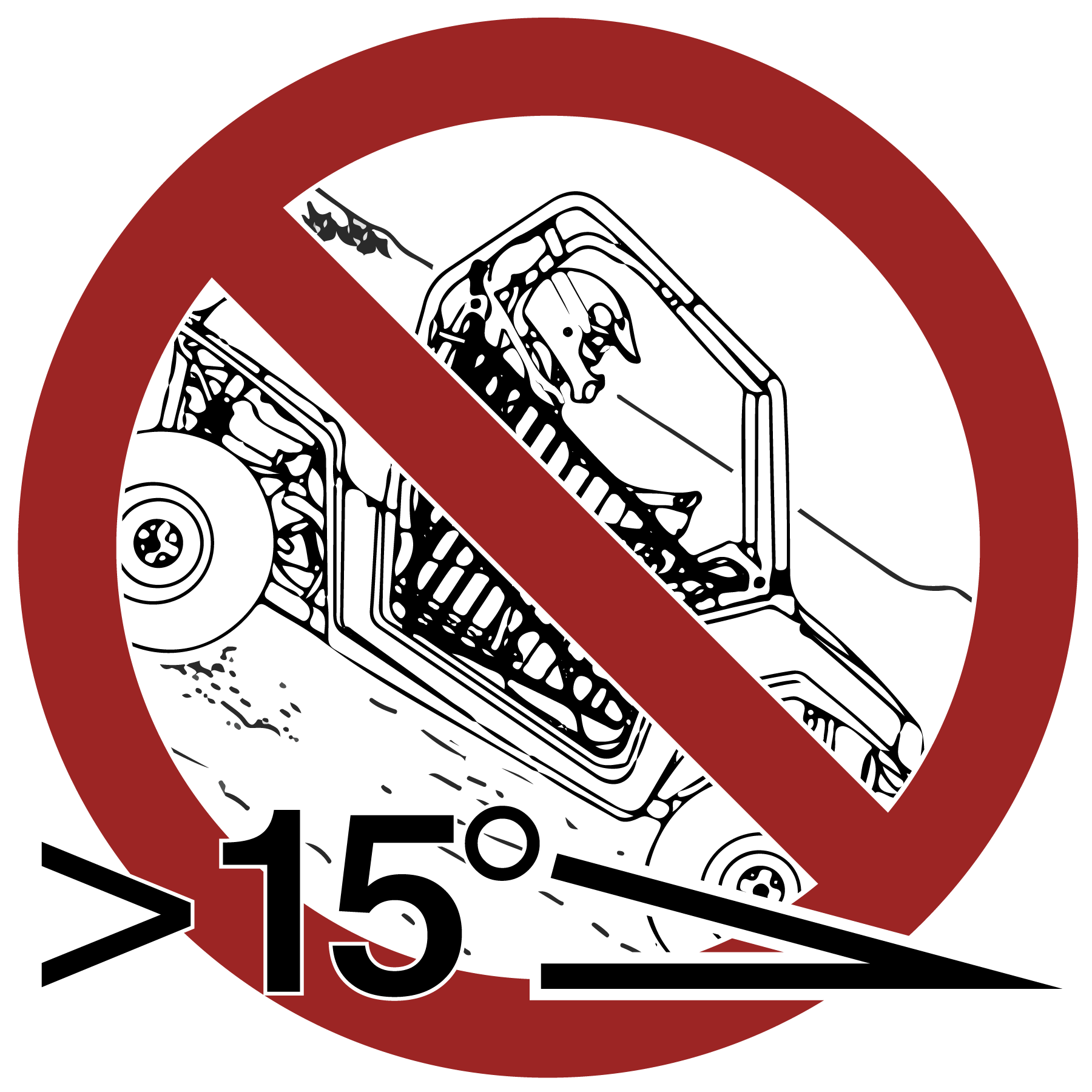
Driving on a sidehill is not recommended. Improper procedure could cause loss of control or rollover. Avoid crossing the side of any hill unless absolutely necessary.
If crossing a hillside is unavoidable, always follow proper procedures as described in this owner's manual. See the Driving on a Sidehill (Sidehilling) section for details.
Stalling or rolling backwards while
climbing a hill could cause a rollover. Maintain a steady speed when
climbing a hill.
If you lose all
forward speed:
Apply the brakes
gradually until the vehicle is fully stopped. Place the transmission
in reverse and slowly allow the vehicle to roll straight downhill
while applying light brake pressure to control speed.
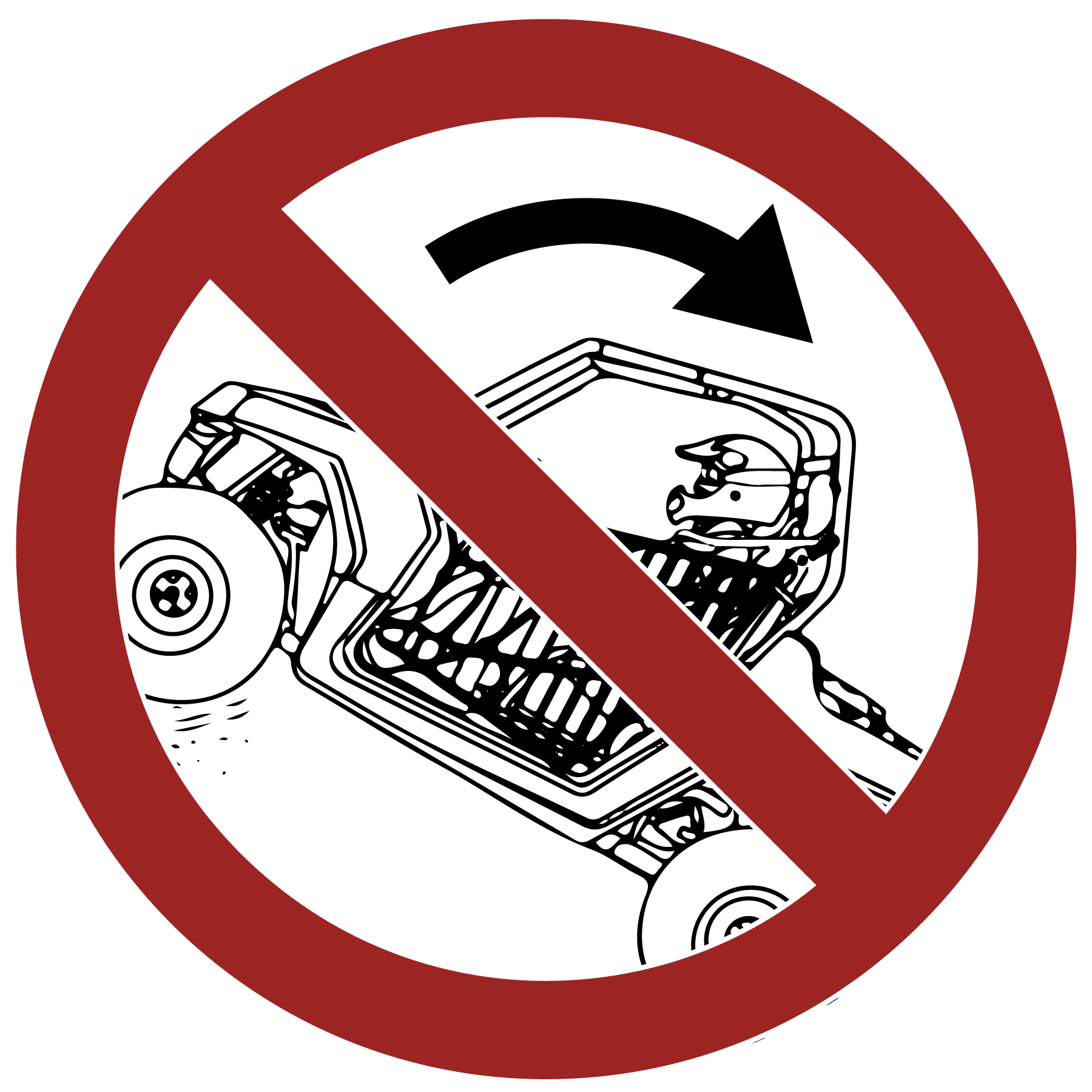
Failure to use extra caution when
operating on unfamiliar terrain could result in an accident or rollover.
Unfamiliar terrain may contain hidden rocks,
bumps, or holes that could cause loss of control or rollover.
Travel slowly and use extra caution when operating
on unfamiliar terrain. Always be alert to changing terrain conditions.
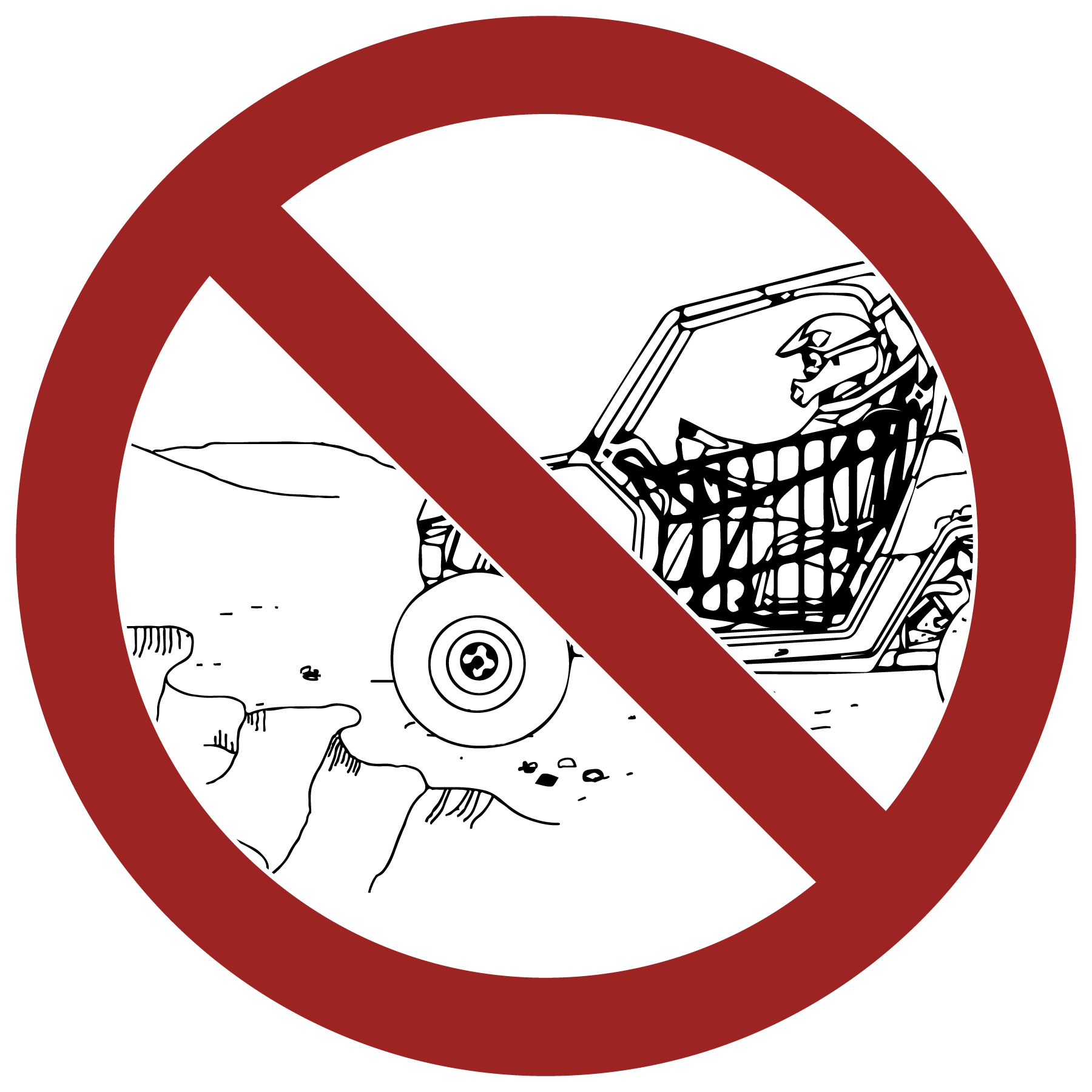
Improperly operating in reverse could result in a collision with an obstacle or person. Always follow proper operating procedures as outlined in this manual. See the Driving in Reverse section for details. Before shifting into reverse gear, always check for obstacles or people behind the vehicle. When it's safe to proceed, back slowly.
Operating this vehicle with improper tires or with improper or uneven tire pressure could cause loss of control, accident or rollover.
Always use the size and type of tires specified for your vehicle. Always maintain proper tire pressure as described in this owner's manual and on safety labels.
Failure to use extra caution when operating on excessively rough, slippery or loose terrain could cause loss of traction, loss of control, accident or rollover. Do not operate on excessively slippery surfaces. Always slow down and use additional caution when operating on slippery surfaces.
Skidding or sliding due to loss of traction can cause loss of control or rollover (if tires regain traction unexpectedly). Always follow proper procedures for operating on slippery surfaces as described in this owner's manual. See the Driving on Slippery Surfaces section for details.
Improperly operating over obstacles
could cause loss of control or rollover.
Before operating in a new area, check for obstacles. Never attempt
to operate over large obstacles such as large rocks or fallen trees.
Always follow the proper procedures outlined in this manual when operating
over obstacles. See the Driving Over Obstacles section for details.
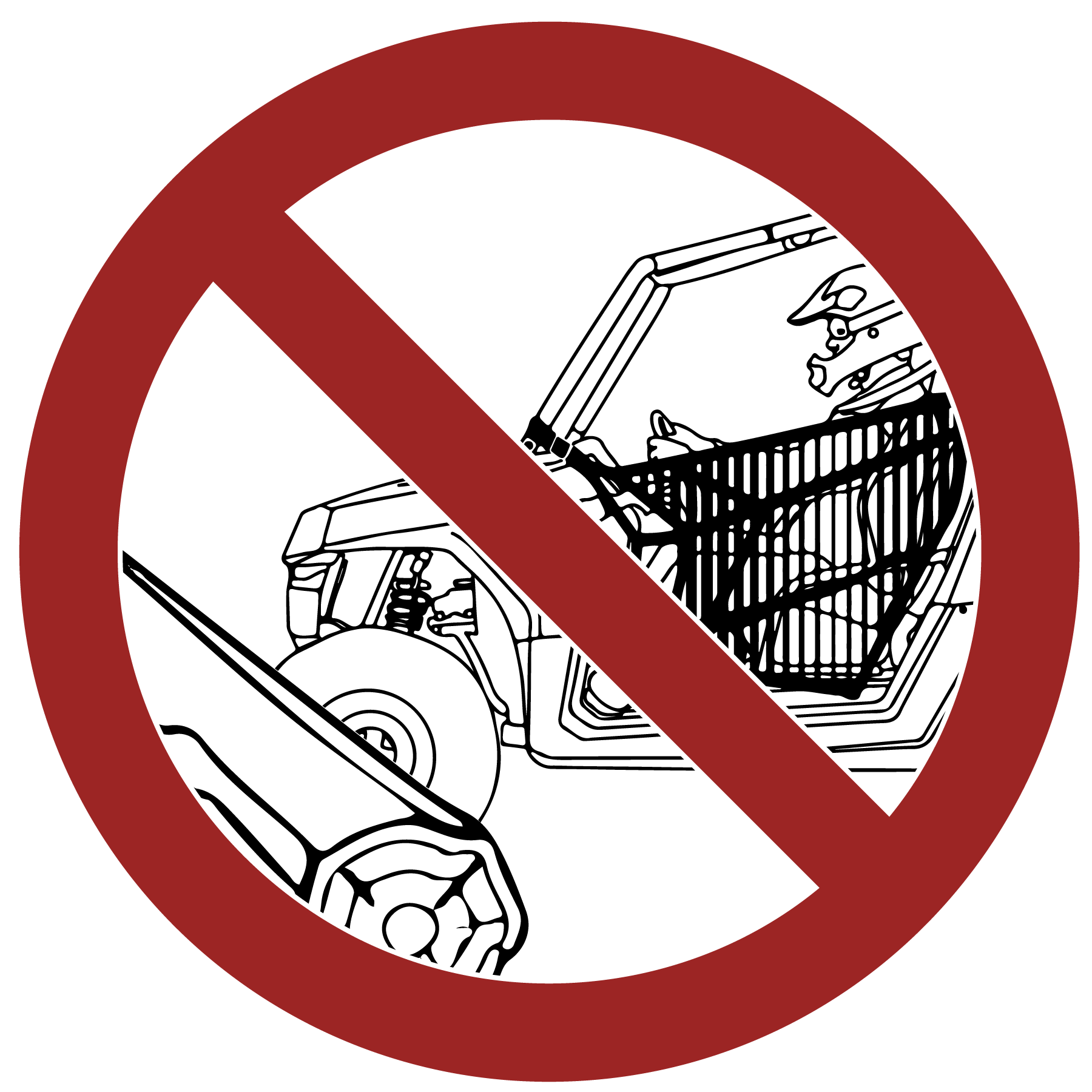
Operating through deep or fast-flowing water can cause loss of
traction, loss of control, rollover or accident. Never operate in
fast-flowing water or in water that exceeds the floor level of the
vehicle.
Always follow proper procedures
for operating in water as described in this owner’s manual.
See the Driving Through Water section for details.
Wet brakes may have reduced stopping ability. After leaving
water, test the brakes. Apply them lightly several times while driving
slowly. The friction will help dry out the pads.
Overloading the vehicle or carrying/towing loads may cause changes in stability and handling, which could cause loss of control or an accident.
Never tow objects with this vehicle.
Never exceed the maximum weight capacity for this vehicle.
Severe injury or death can result if the vehicle and/or the operator
fall through the ice. Never operate the vehicle on a frozen body of
water unless you have first verified that the ice is sufficiently
thick to support the weight and moving force of the vehicle, you and
any passengers, and your cargo, together with any other vehicles in
your party.
Always check with local
authorities and residents to confirm ice conditions and thickness
over your entire route. Vehicle operators assume all risk associated
with ice conditions on frozen bodies of water.
Operating a damaged vehicle can result in an accident. After any rollover or other accident, have a qualified service dealer inspect the entire machine for possible damage, including (but not limited to) seat belts, rollover protection devices, brakes, throttle and steering systems.
Overloading the vehicle or carrying cargo improperly may cause changes in stability and handling, which could cause loss of control or an accident.
Always follow the instructions in this owner’s manual for carrying cargo. See the Hauling Cargo section for details.
Never exceed the stated load capacity for this vehicle.
Cargo should be properly distributed and securely attached. See the Hauling Cargo section for details.
Reduce speed when carrying cargo. Allow a greater distance for braking.
Engine exhaust fumes are poisonous and can cause loss of consciousness or death in a short time. Never start the engine or let it run in an enclosed area.
Operate this vehicle only outdoors or in well-ventilated areas.
Exhaust system components are very hot during and after use of the vehicle. Hot components can cause burns and fire. Do not touch hot exhaust system components. Always keep combustible materials away from the exhaust system.
Use caution when traveling through tall grass, especially dry grass and when traveling through muddy conditions. Always inspect the underside of the vehicle and areas near the exhaust system after driving through tall grass, weeds, brush, other tall ground cover, and muddy conditions. Promptly remove any grass, debris or foreign matter clinging to the vehicle and pay particular attention to the exhaust system area.
Gasoline is highly flammable and explosive under certain conditions.
Always exercise extreme caution whenever handling gasoline.
Always turn off the engine when refueling.
Always refuel outdoors or in a well ventilated area free of any source of flame or sparks.
NEVER carry fuel or other flammable liquids on this vehicle. Failure to follow this instruction could lead to serious burn injuries or death.
Do not smoke or allow open flames or sparks in or near the area where refueling is performed or where gasoline is stored.
Do not overfill the tank. Do not fill the tank neck.
If gasoline spills on your skin or clothing, immediately wash it off with soap and water and change clothing.
Leaving the keys in the ignition can lead to unauthorized use of the vehicle by someone under the age of 10 or without proper training. This could result in an accident or rollover. Always remove the ignition key when the vehicle is not in use.
Your POLARIS vehicle is designed to provide safe operation when used as directed. Modifications to your vehicle may negatively impact vehicle stability. Failure of critical machine components may result from operation with any modifications, especially those that increase speed or power. This vehicle may become less stable at speeds higher than those for which it is designed. Loss of control may occur at higher speeds.
Do not install any non-POLARIS-approved accessory or modify the vehicle for the purpose of increasing speed or power. Any modifications or installation of non-POLARIS-approved accessories could create a substantial safety hazard and increase the risk of bodily injury.
The POLARIS limited warranty on your POLARIS vehicle will be terminated if any non-POLARIS-approved equipment and/or modifications have been added to the vehicle that increase speed or power.
The addition of certain accessories, including (but not limited to) mowers, blades, tires, sprayers, or large racks, may change the handling characteristics of the vehicle. Use only POLARIS-approved accessories, and familiarize yourself with their function and effect on the vehicle.
The addition of certain accessories, including (but not limited to) overhead audio speakers, may change the forward clearance in the vehicle. Polaris recommends selecting a helmet that is compatible with the equipment on your vehicle and provides the greatest amount of forward clearance. Always wear a helmet that meets or exceeds the specifications in this owner’s manual. Refer to the Safe Riding Gear section of this owner’s manual for more information. Use only POLARIS-approved accessories.
|
FOR MORE INFORMATION ABOUT SAFETY |
Warning labels have been placed on the vehicle for your protection. Read and follow the instructions of the labels on the vehicle carefully. If any of the labels depicted in this manual differ from the labels on your vehicle, always read and follow the instructions of the labels on the vehicle.
If an informational or graphic label becomes illegible or comes off, contact your POLARIS dealer to purchase a replacement. Replacement safety labels are provided by Polaris at no charge. The part number is printed on the label.
WARNING
The tire pressure and load warning 1 is located on the front of the cargo compartment.
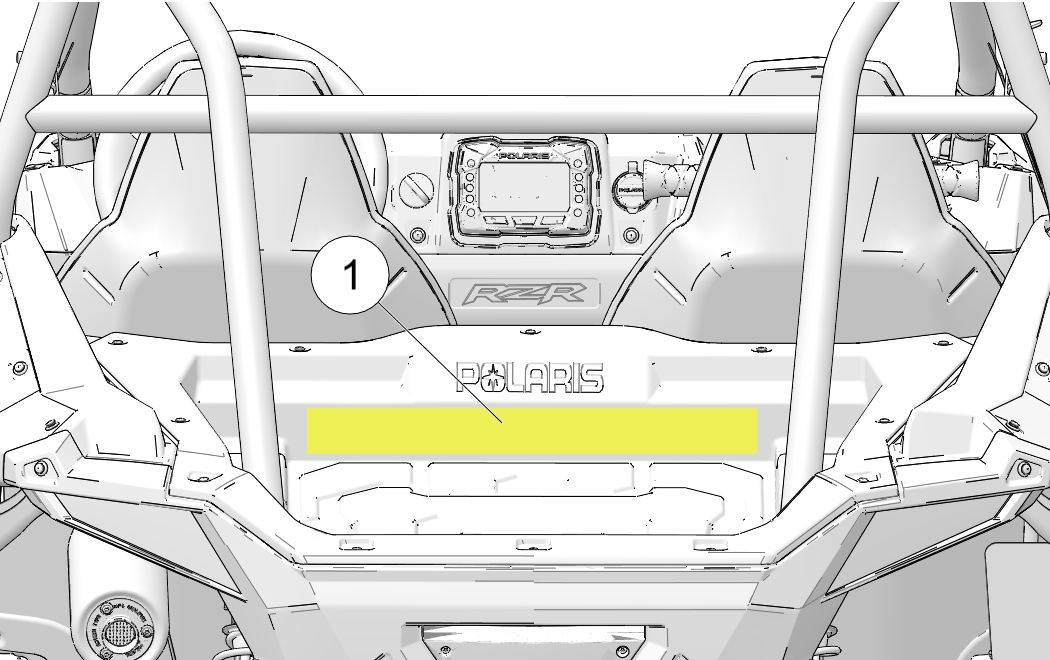
WARNING
Never carry passengers in cargo box.
Passengers can be thrown off. This can cause serious injury or death.
WARNING
Never carry fuel or other flammable liquids on this vehicle.
Failure to follow this instruction could lead to serious burn injuries or death
WARNING
IMPROPER TIRE PRESSURE OR OVERLOADING CAN CAUSE LOSS OF CONTROL RESULTING IN SERIOUS INJURY OR DEATH.
Reduce speed and allow greater distance for braking when carrying cargo.
Overloading or carrying tall, off-center, or unsecured loads will increase your risk of losing control. Loads should be centered and carried as low as possible in box.
For stability on rough or hilly terrain, reduce speed and cargo.
| RZR 200 | |
|---|---|
| MAXIMUM CARGO BOX LOAD |
50 lbs. (23 kg) |
| TIRE PRESSURE IN PSI (KPa) |
FRONT 5 (34.5) REAR 5 (34.5) |
| MAXIMUM WEIGHT CAPACITY INCLUDES WEIGHT OF OPERATOR, PASSENGER, CARGO, AND ACCESSORIES. |
350 lbs. (158 kg) |
| Read Operation & Maintenance Manual for more detailed loading information. | |
Part Number: 7300193
WARNING
The general use warning 2 is located on the inside of the driver’s door panel.

WARNING
Improper vehicle use can result in SEVERE INJURY or DEATH
NEVER allow vehicle to be Operated:
without all occupants first viewing and understanding the safety video and warning labels.
with more than one passenger.
on hills steeper than 15˚.
on paved surfaces - pavement may seriously affect handling and control.
with non-Polaris approved accessories - they may seriously affect stability.
at speeds that are too fast for the operators skills, the conditions and/or the terrain.
ALWAYS require Operator and/or Passenger to:
wear seat belts, grab hand holds (passenger) and plant feet firmly on the floor.
secure cab nets.
keep hands and feet inside vehicle.
use an approved helmet and protective gear for all occupants.
avoid quick turns of the steering wheel and driving stunts such as jumps, donuts or power slides.
reduce speed and use extra caution when carrying a passenger.
watch for branches or other hazards that could enter vehicle.
Operation of this vehicle by children under the age of 10 increase the risk of severe injury or death.
Adult supervision required for children under age 16.
NEVER permit children under age 10 to operate this vehicle.
NEVER permit a passenger whose feet cannot touch the floor.
LOCATE AND READ OWNER’S MANUAL. FOLLOW ALL INSTRUCTIONS AND WARNINGS. IF OWNER’S MANUAL IS MISSING, CONTACT A POLARIS DEALER FOR A REPLACEMENT.
Part Number: 7300583
WARNING
The clutch cover warning 3 is located on the outside belt-clutch cover.
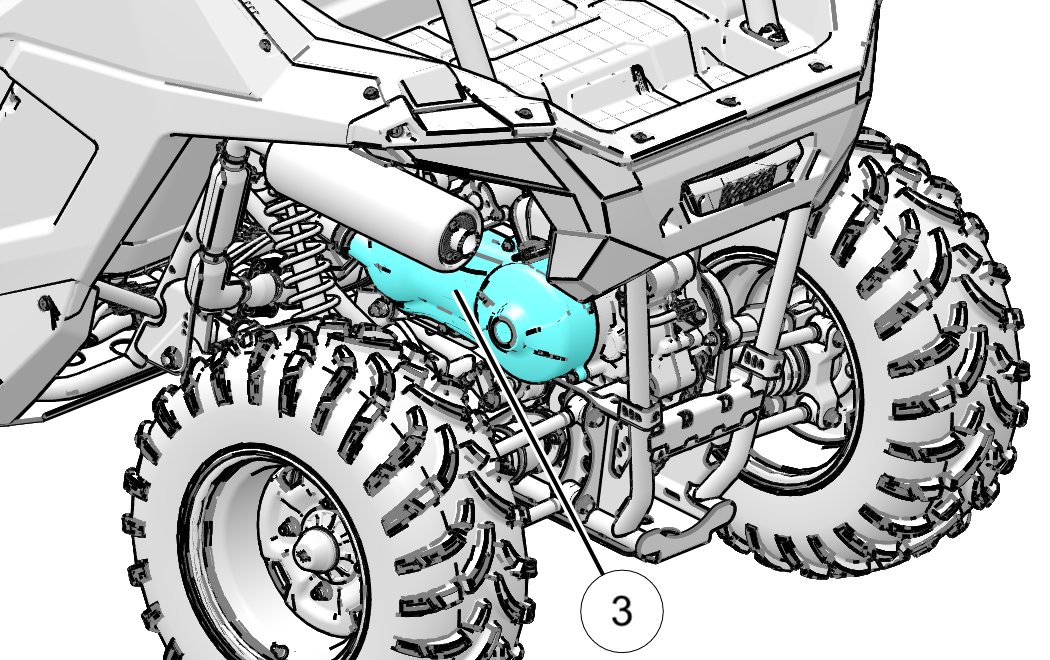
Moving parts hazard under belt-clutch guard. To prevent serious injury, do not operate vehicle with guard removed.
Do not modify engine or clutch. Doing so can cause part failure, possible imbalance, and excessive engine RPM which can result in serious injury or death.
Part Number: 7175488
WARNING
The tire pressure and load warning is located on the front of the cargo compartment.

Read the owner’s manual.
Never carry passengers in the cargo box.
NEVER carry fuel or other flammable liquids on this vehicle. Failure to follow this instruction could lead to serious burn injuries or death.
Maximum cargo capacity including weight of operator, passenger, cargo, and accessories must be under 158 kg.
Tire pressure specification is 34,5 kPa.
Part Number: 7300512
WARNING
The general use warning is located on the inside of the driver’s door panel.
Read the owner’s manual.
Always wear the seat belts.
Use and secure cab nets and door close-offs.
Use an approved helmet and protective gear for all occupants.
Never allow anyone under 10 years of age to operate the vehicle.
Never operate while under the influence of drugs or alcohol.
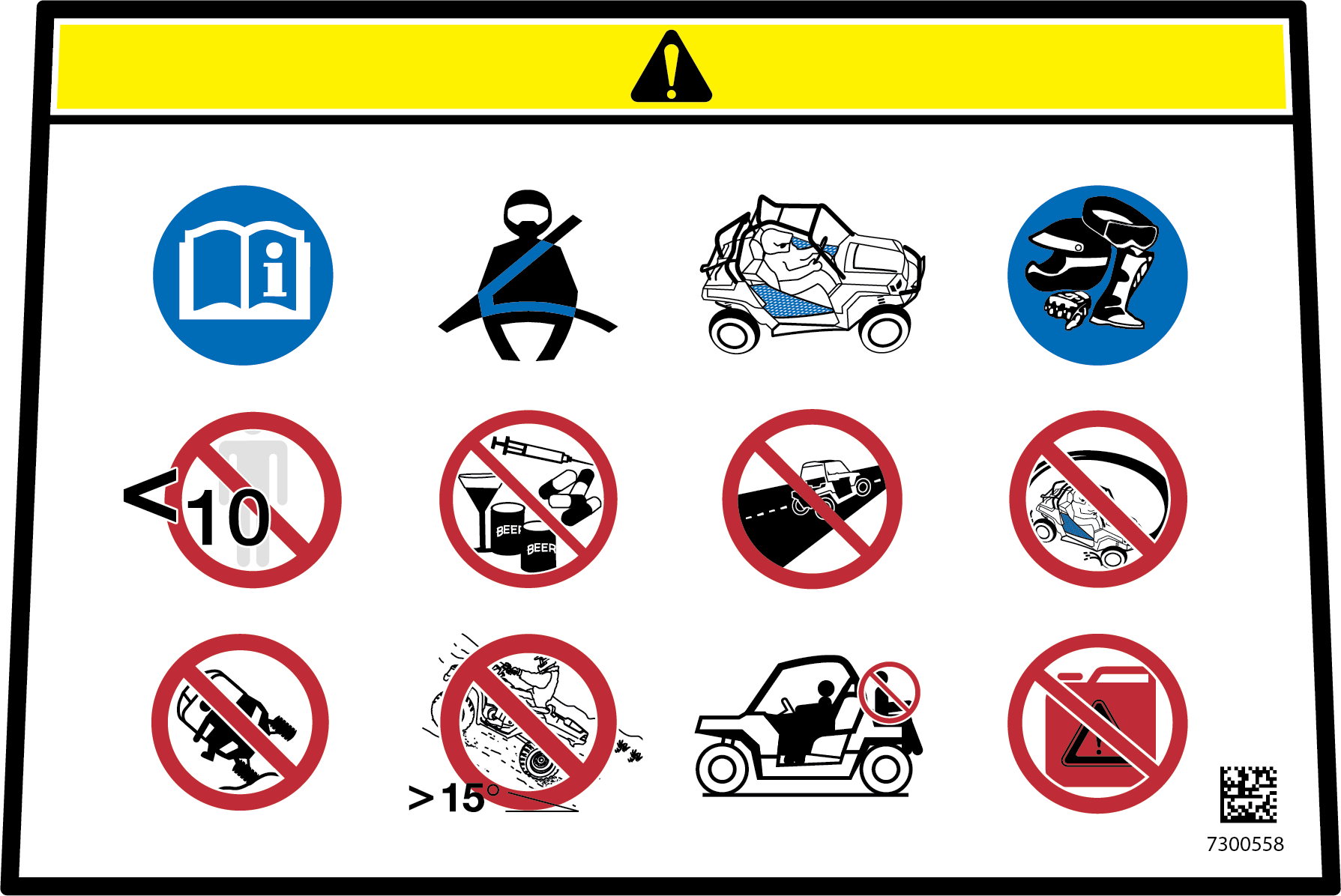
Do not use on public roads (unless designated for off-highway vehicle access).
Exhibition driving increases the risk of accident or rollover. DO NOT do power slides, “donuts”, jumps or other driving stunts. Avoid exhibition driving
Do not operate vehicle on grades exceeding 15 degrees of incline.
Never carry passengers in the cargo box.
NEVER carry fuel or other flammable liquids on this vehicle. Failure to follow this instruction could lead to serious burn injuries or death.
Part Number: 7300558
WARNING
Read the owner’s manual. Keep
limbs away from moving parts.
The clutch cover alert
label is located on the vehicle’s clutch cover.
Part number: 7181427.

WARNING
The hot surfaces alert is located
on the body above the muffler.
Hot component. Hot
components can cause burns and fire. Do not touch hot component.
Part Number: 7185151
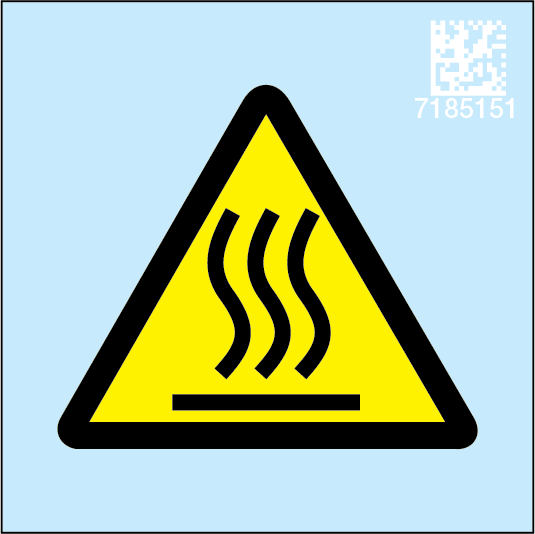
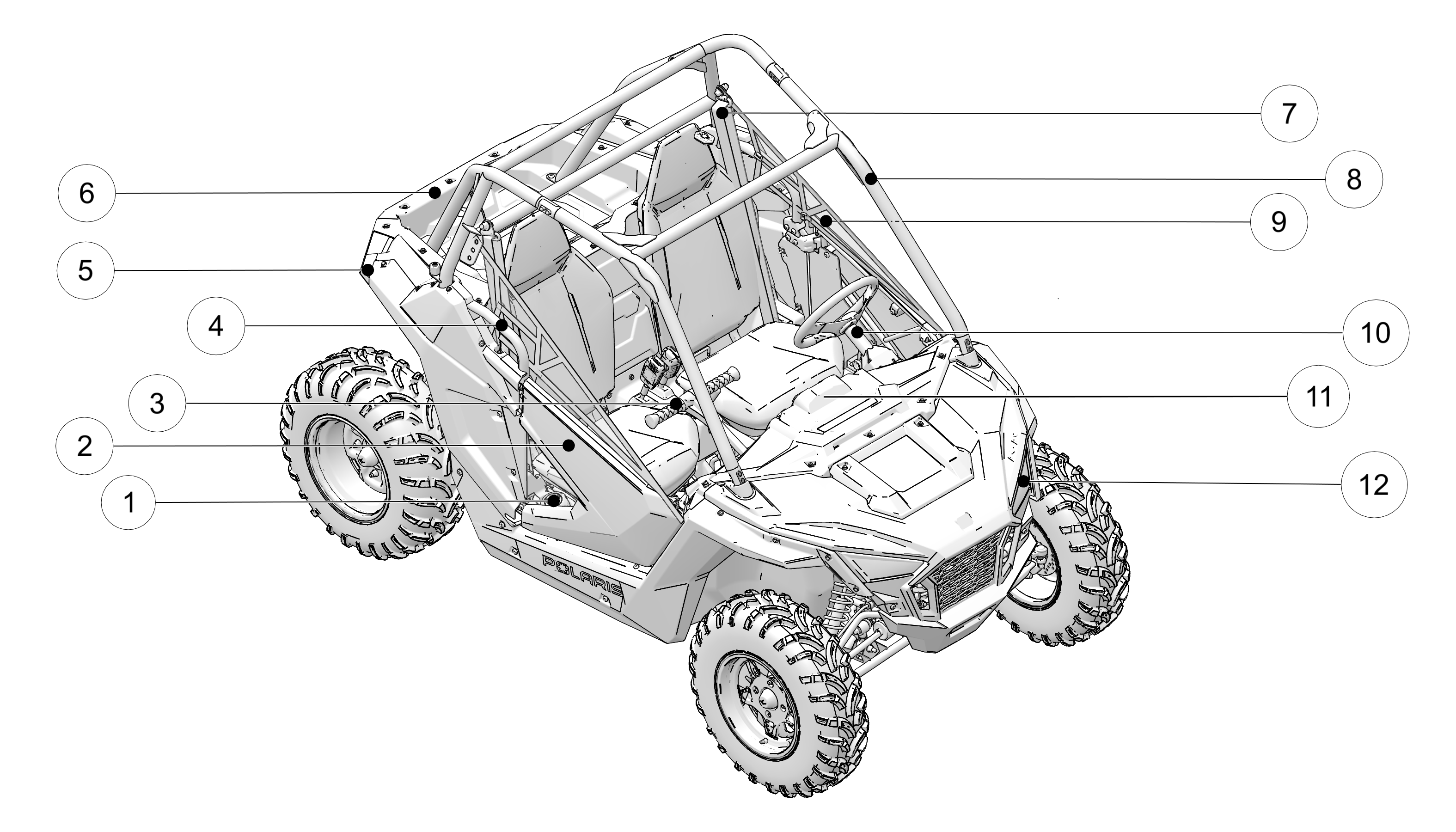
1 Fuel Cap
2 Cab Door
3 Passenger Hand Hold
4 Shoulder Bar
5 Tail Light
6 Cargo Box
7 Seat Belt
8 ROPS Frame
9 Cab Net
10 Steering Wheel
11 Console
12 Head Light
Lift the seat latch lever 1 located under the right front edge of the driver’s seat.
While holding the lever upward, slide the seat forward or rearward to the desired position, then release the lever.
Slide the seat forward and rearward to ensure the latch is engaged. Before operating the vehicle, always make sure both seats are securely installed.
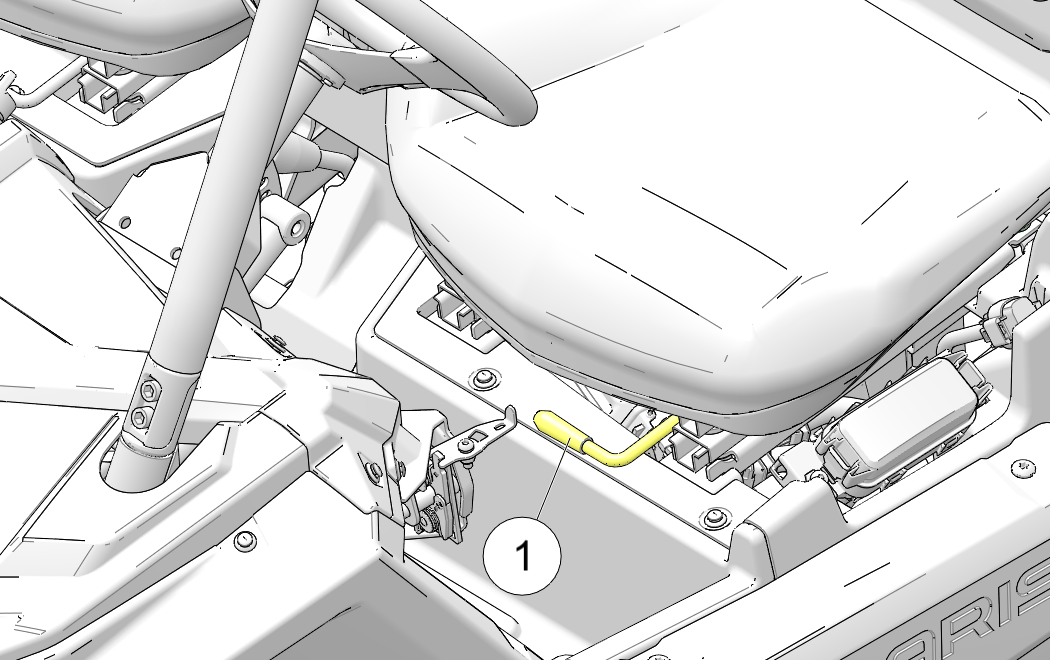
Slide the seat completely forward to access the fasteners.
Remove the two fasteners 2 securing the seat slides to the frame.
Remove the seat from the vehicle.
Reverse this procedure to reinstall the seat.
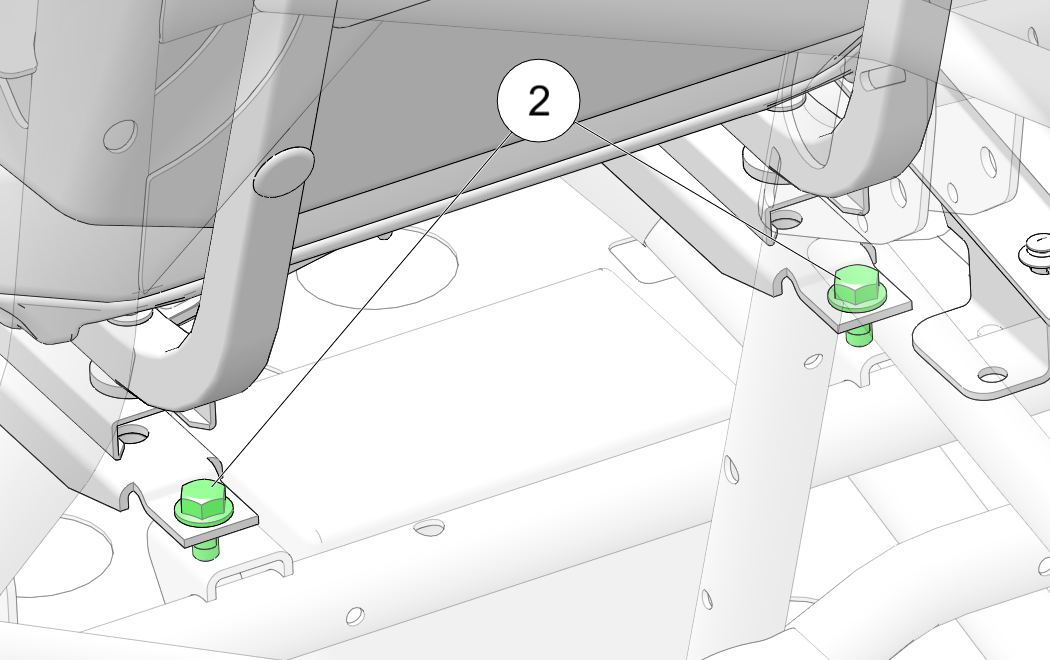
Seat Rail Mount to Chassis Fasteners:
30 ft-lbs (41 N·m)
The fuel tank filler cap 1 is located on the right-hand side of the vehicle near the passenger seat.
When refueling, always use either
leaded or unleaded gasoline with a minimum pump octane number of 87
R+M/2 octane. Non-ethanol fuel is recommended.
Do not use fuel with ethanol content greater than 10 percent, such
as E-85 fuel.

Riding in this vehicle without using the cab nets or doors increases the risk of serious injury or death in the event of an accident or rollover.
Cab nets must be used by both operator and passenger at all times. Make sure all latches are secure before operating the vehicle.
Always inspect doors and cab nets for tightness, wear, and damage before each use of the vehicle. Promptly replace worn or damaged doors, cab nets, or latches with new components. Your Polaris dealer can assist.
This RZR is equipped with three-point lap and diagonal seat belts for the operator and passenger. Never ride before ensuring seat belts are secured for both the operator and passenger. The driver’s seat belt is equipped with seat belt interlock, automatically limiting vehicle speed when the driver’s seat belt is not secured.
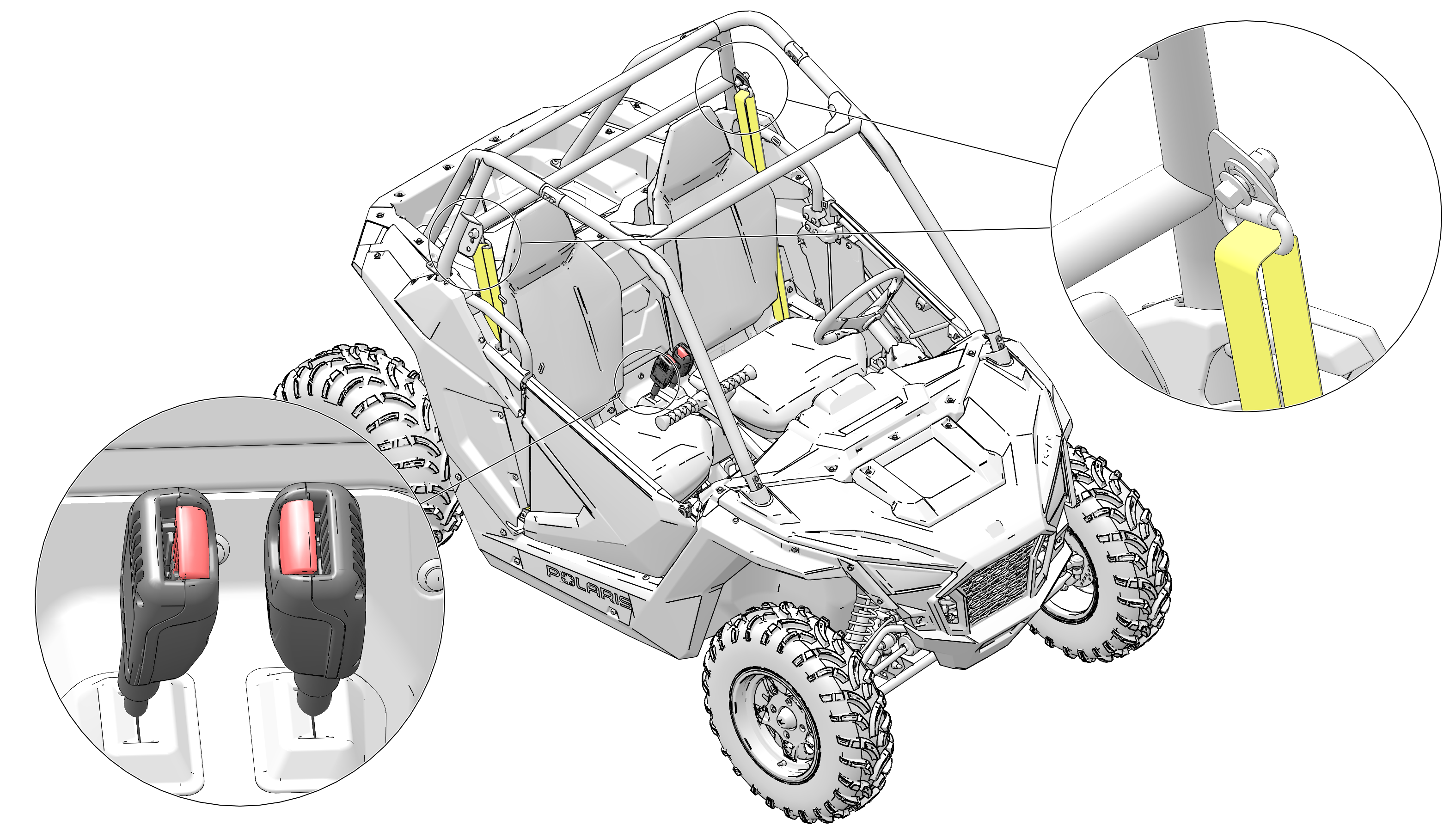
To wear the seat belt properly, do the following:
Pull the seat belt latch downward and across your chest toward the buckle on the inside edge of the seat. The belt should fit snugly across your hips and diagonally across your chest. Check to ensure the belt is not twisted before securing.
Push the latch plate into the buckle until it clicks.
Release the strap, it will self-tighten.
Press the red release latch on the buckle to release the seat belt.
The position of the shoulder strap can be adjusted to the height of the operator.
To adjust the seat belt height, do the following:
Remove the nut 2 from the seat belt bracket.
Move mounting bolt 1 to a higher or lower position.
Reinstall the nut and torque to specification.
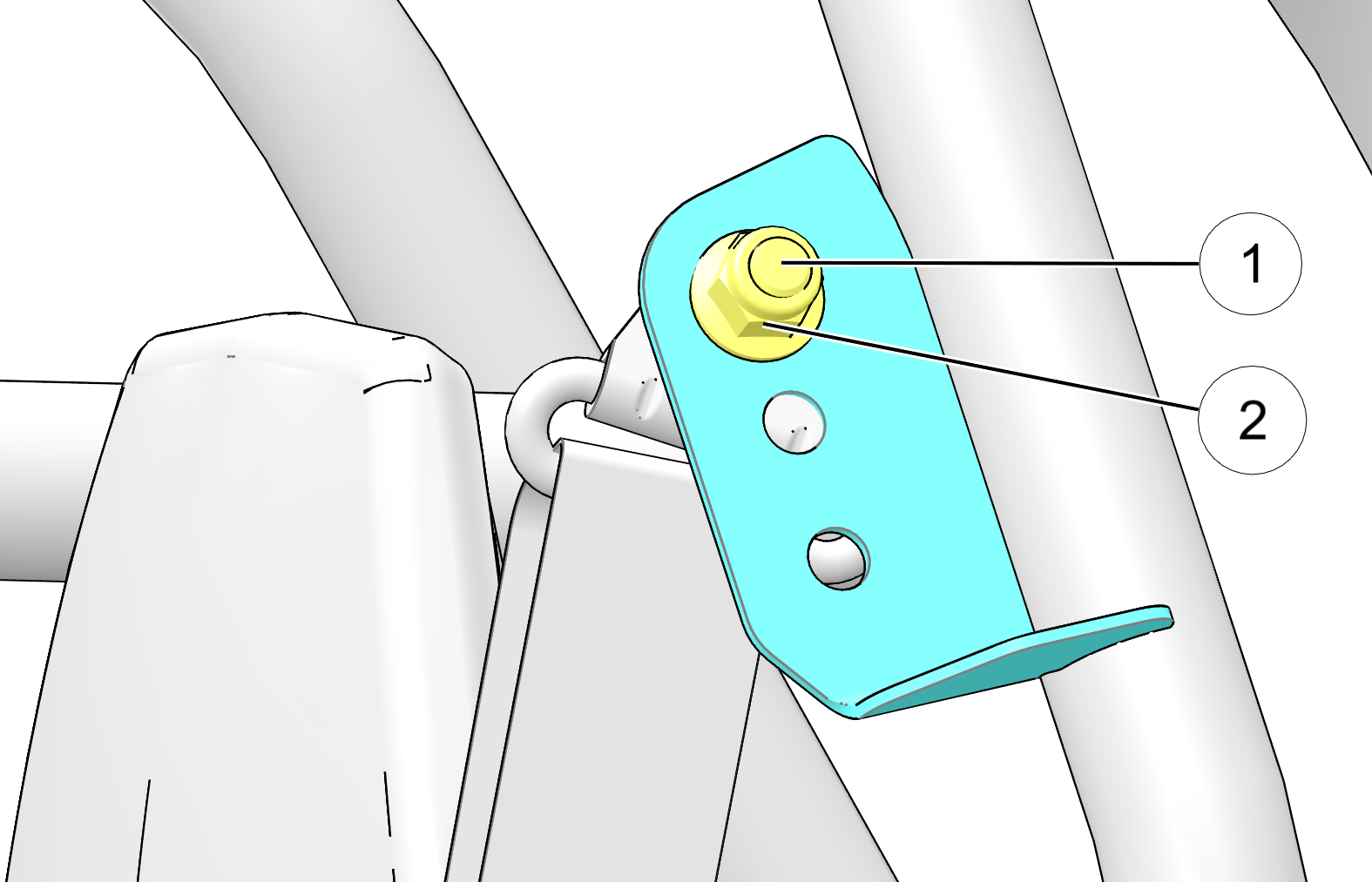
Seat Belt Adjustment Bolt
30 ft-lbs (41 N·m)
Inspect all seat belts for proper operation before each use of the vehicle.
Push the latch plate into the buckle until it clicks. The latch plate must slide smoothly into the buckle. A click indicates that it's securely latched.
Push the red release latch in the middle of the buckle to make sure it releases freely.
Pull each seat belt completely out and inspect the full length for any damage, including cuts, wear, fraying or stiffness. If any damage is found, or if the seat belt does not operate properly, have the seat belt system checked and/or replaced by an authorized dealer.
To clean dirt or debris from the seat belts, sponge the straps with mild soap and water. Do not use bleach, dye or household detergents.
The steering wheel can be adjusted upward or downward for rider preference. Do not adjust steering wheel while vehicle is in operation.
Unscrew the adjustment knob 1 until free from the steering bracket.
Lift or lower the steering wheel to the desired position.
Hand-tighten the knob.
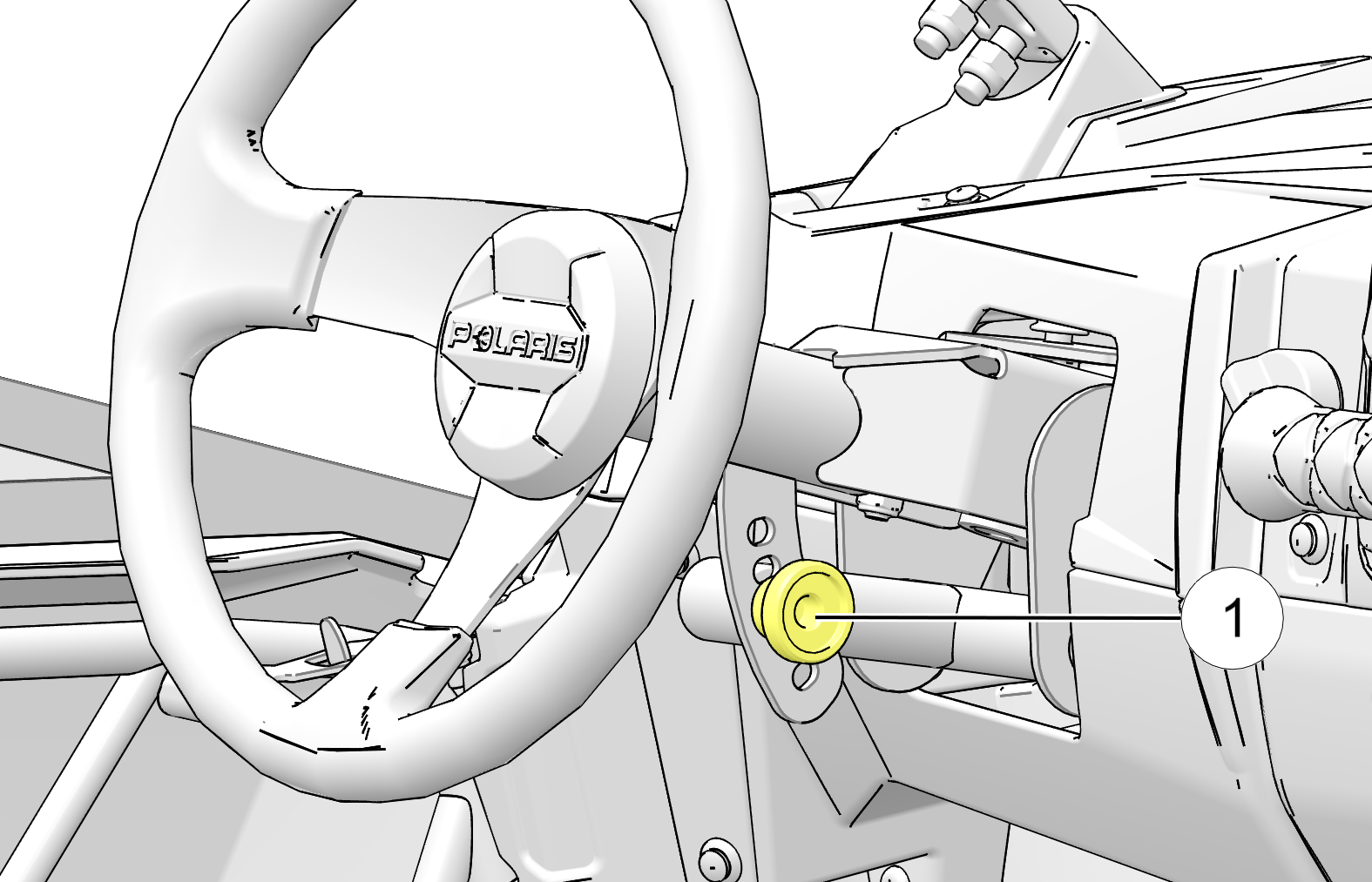
The ignition switch 1 is a three-position, key-operated switch. Use the ignition switch to start the engine. See Starting the Engine for starting procedures.The key can be removed from the switch when it is in the OFF position.
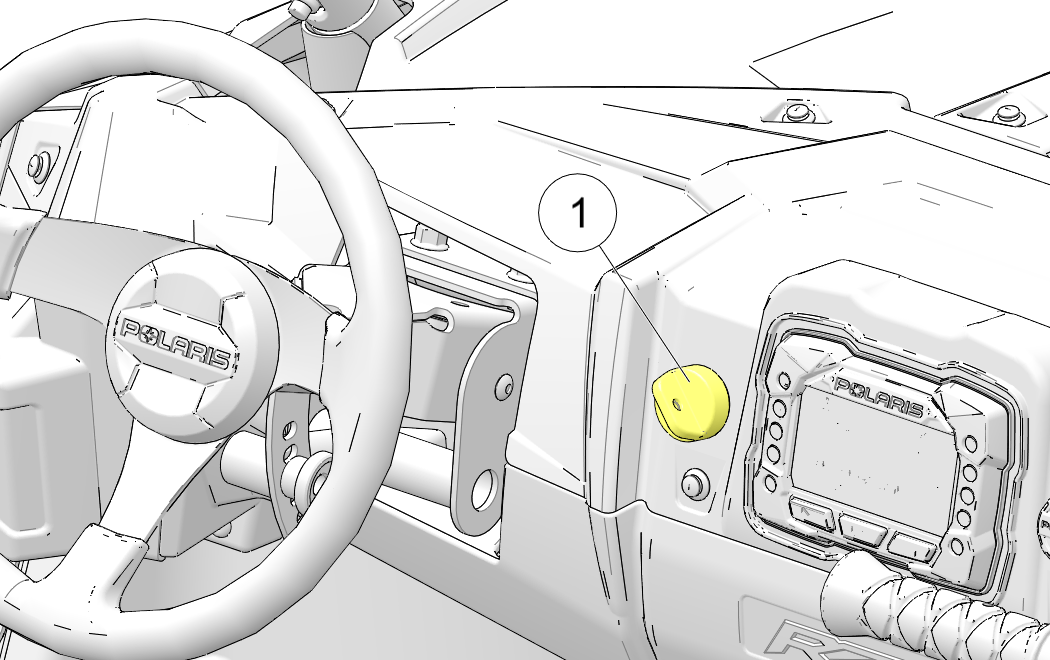
|
Icon |
Function |
Description |
|---|---|---|

|
Engine Off |
The engine is off. Electrical circuits are off, except accessory 12V. |

|
Battery On / |
Electrical circuits are on. Electrical equipment can be used. |

|
Engine Start |
Turn the key to START position to engage the electric starter and start the engine. The key returns to ON position when released. |
The gear selector 1 is located between the seats. To change gears, stop the vehicle, and with the engine idling, move the lever to the desired gear. Do not attempt to shift gears with engine speed above idle or while the vehicle is moving.
F: Forward
N: Neutral
R: Reverse
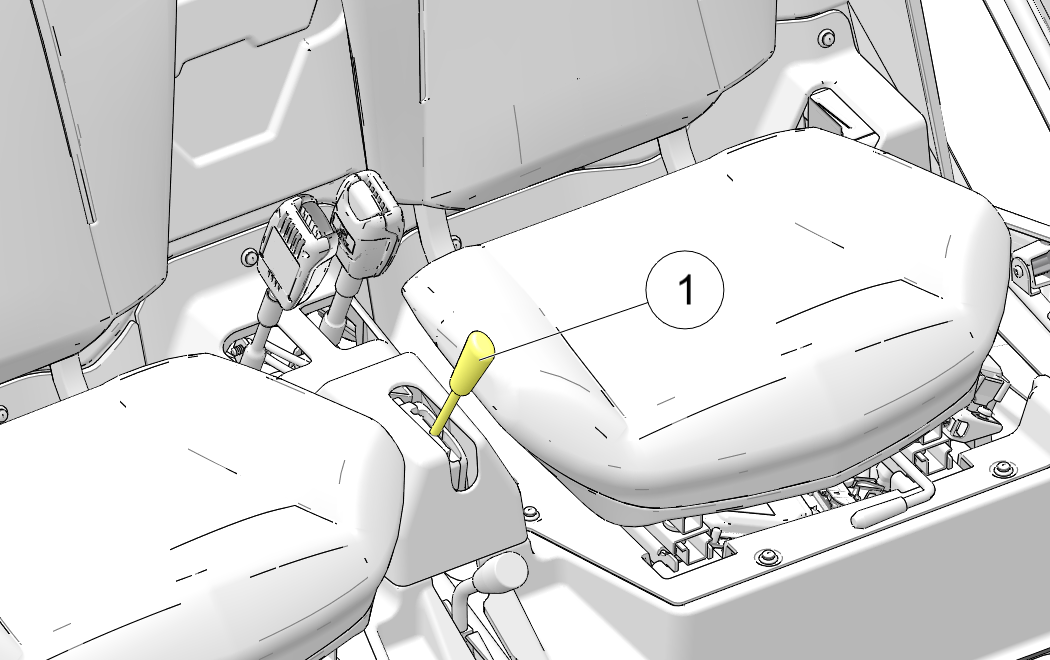
Apply the foot brake.
When vehicle is fully stopped, pull the parking brake lever 1 rearward as far as possible to set the parking brake.
Stop the engine.
To release the parking brake, apply the foot brake and push the parking brake lever first toward the passenger seat and then forward.

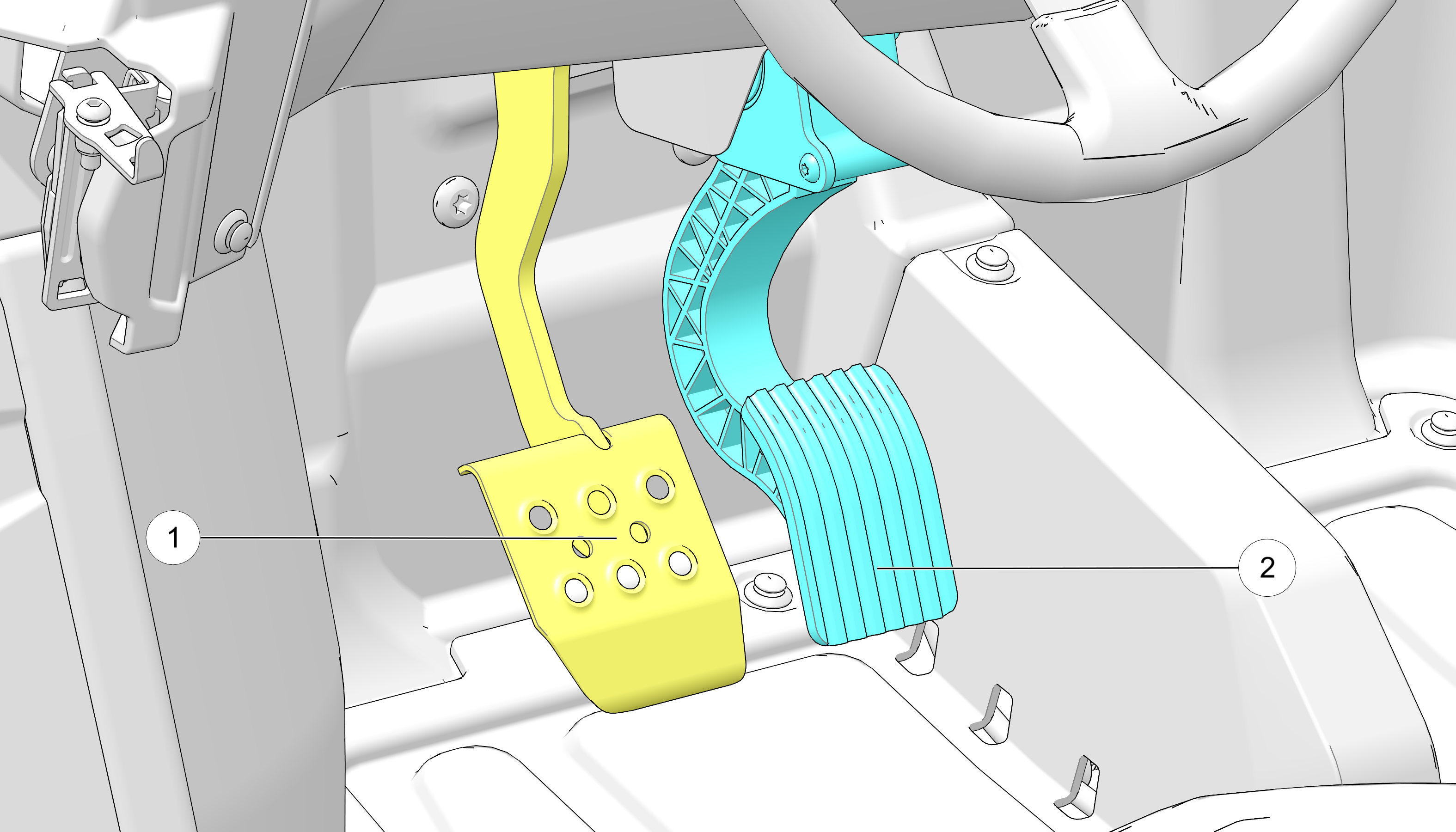
Depress the brake pedal 1 to slow or stop the vehicle.
Depress the throttle pedal 2 to increase engine speed. Spring pressure returns the pedal to the rest position when released. Always ensure the throttle pedal returns normally before starting the engine.
The helmet aware beacon and mounting
adhesive comes shipped with the owner’s manual. This allows
parents to mount to a helmet. The helmet aware beacon should be mounted
on a flat surface on the helmet.
The
display will issue a low battery message if the beacon is below 10%
battery level. Parents can replace the battery beacon with a CR2032.
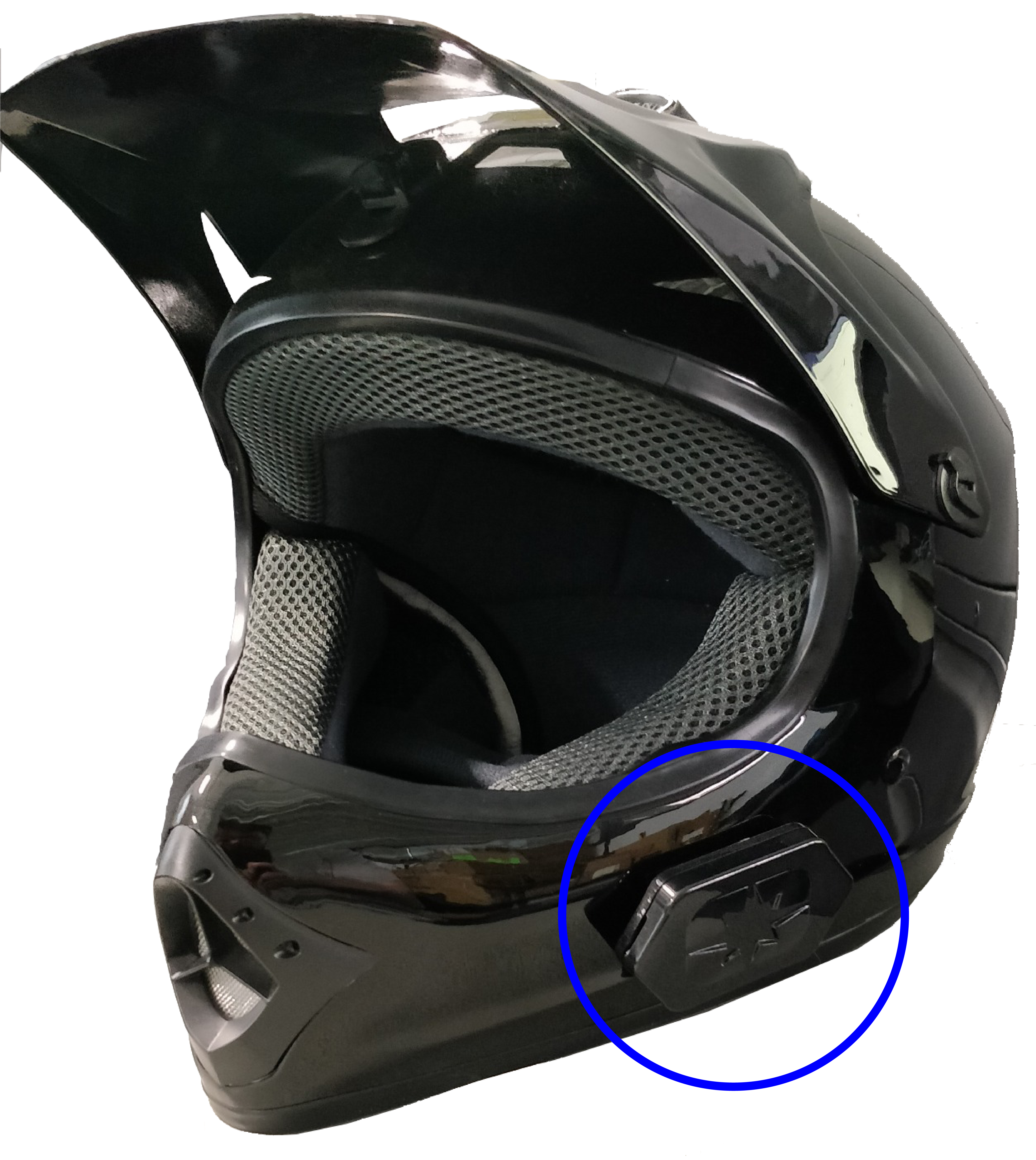
To replace the battery remove 2 screws
from the enclosure and then split the beacon apart with a small standard
screw driver.
Helmet aware comes disabled
from factory and must be enabled by parent.
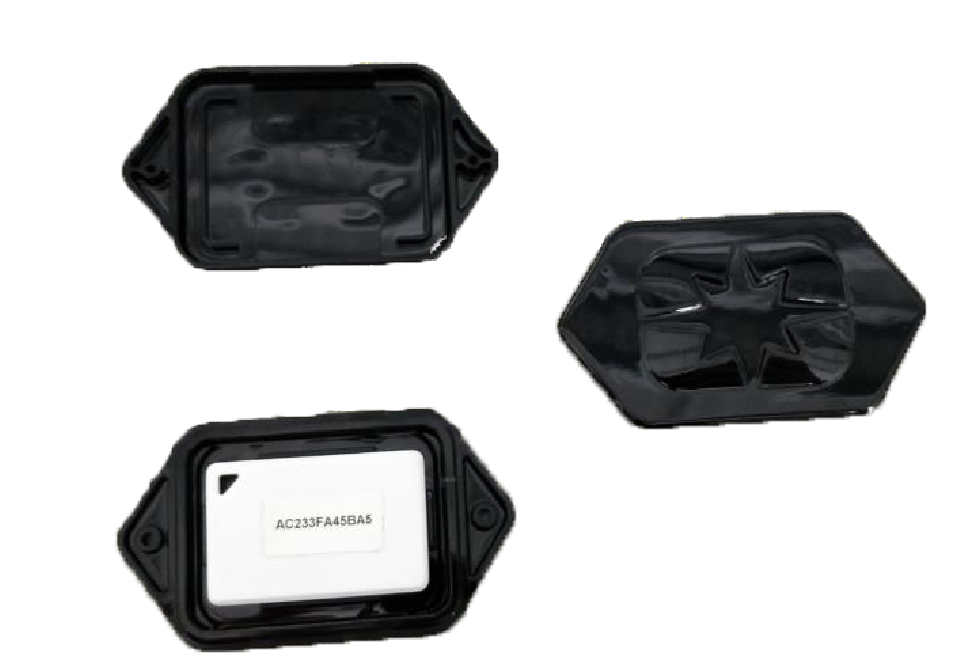
Cleaning your vehicle using a high pressure washer may cause instrument cluster damage. Wash the vehicle by hand or with a garden hose, using mild soap. Do not use rubbing alcohol to clean the instrument cluster. Avoid using insect sprays near your vehicle to prevent chemical contact with the screen. Should gasoline come into contact with the instrument cluster, immediately clean it off using a clean cloth and mild soap.
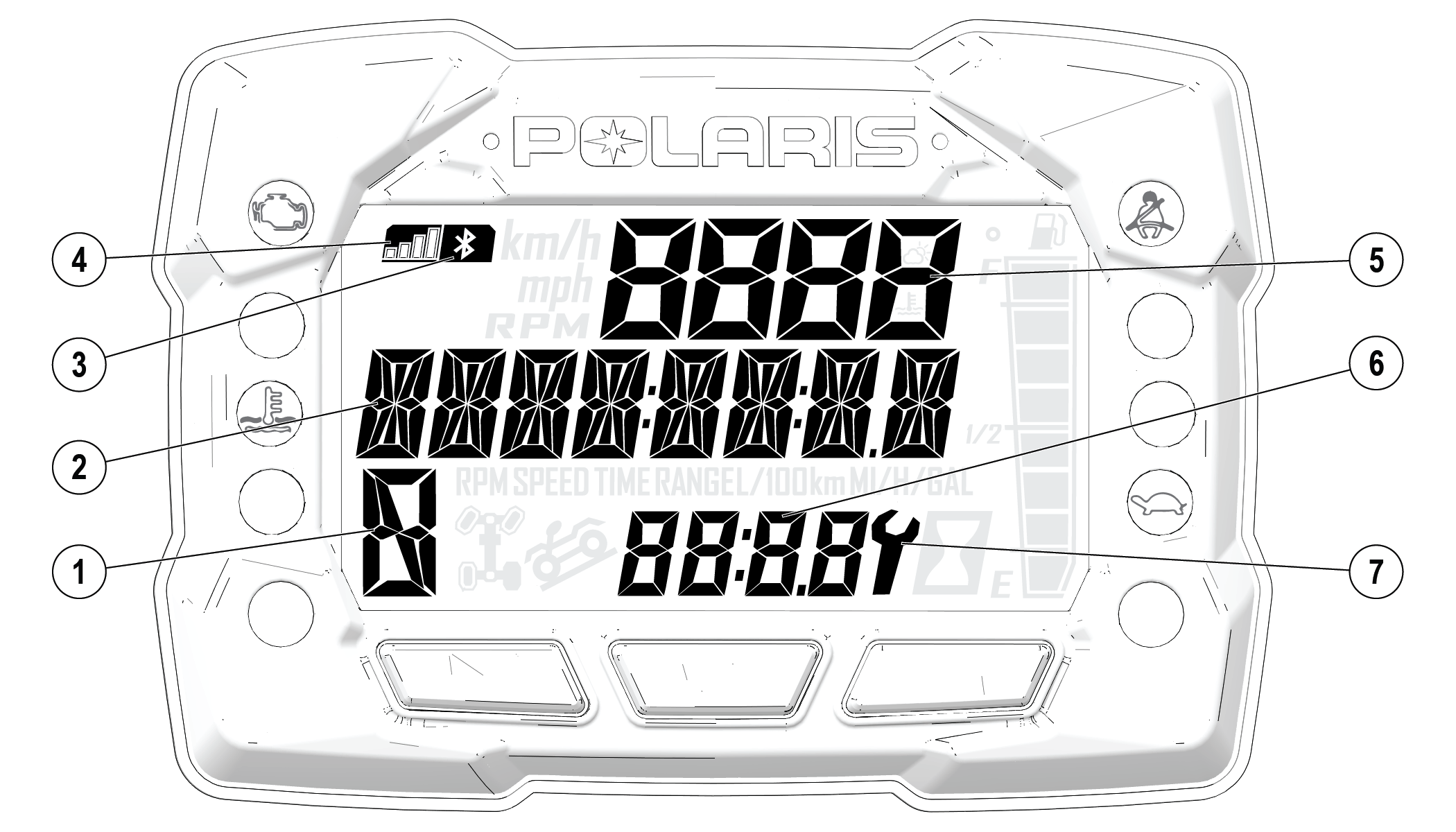
1 Gear Indicator
2 Display Area 2
3 Bluetooth® Connected
4 Helmet Aware Signal Strength
5 Display Area 1
6 Clock
7 Service Indicator
|
Feature |
Description |
|---|---|
|
Gear Indicator |
|
|
Display Area 2 |
This area displays odometer, trip meter, trip meter 2, voltage, engine temperature, engine hour meter, programmable service hour interval, ground speed, engine RPM, GeoFence status, or speed limit status. |
|
Bluetooth® Connected |
This icon illuminates when the display is connected to a device via Bluetooth®. |
|
Helmet Aware Signal Strength |
This indicates the signal strength of the helmet beacon. This symbol will flash if the helmet aware system is activated and the helmet beacon is not in range. The symbol will remain on solid when the helmet beacon is in range. |
|
Display Area 1 |
This area displays engine RPM, ground speed, or coolant temperature. |
|
Clock |
The clock displays time in a 12-hour or 24-hour format. See Clock for more information. |
|
Service Indicator |
A flashing wrench symbol alerts the operator that the preset service interval has been reached. Your Polaris dealer can provide scheduled maintenance. See Service Hours for more information. |
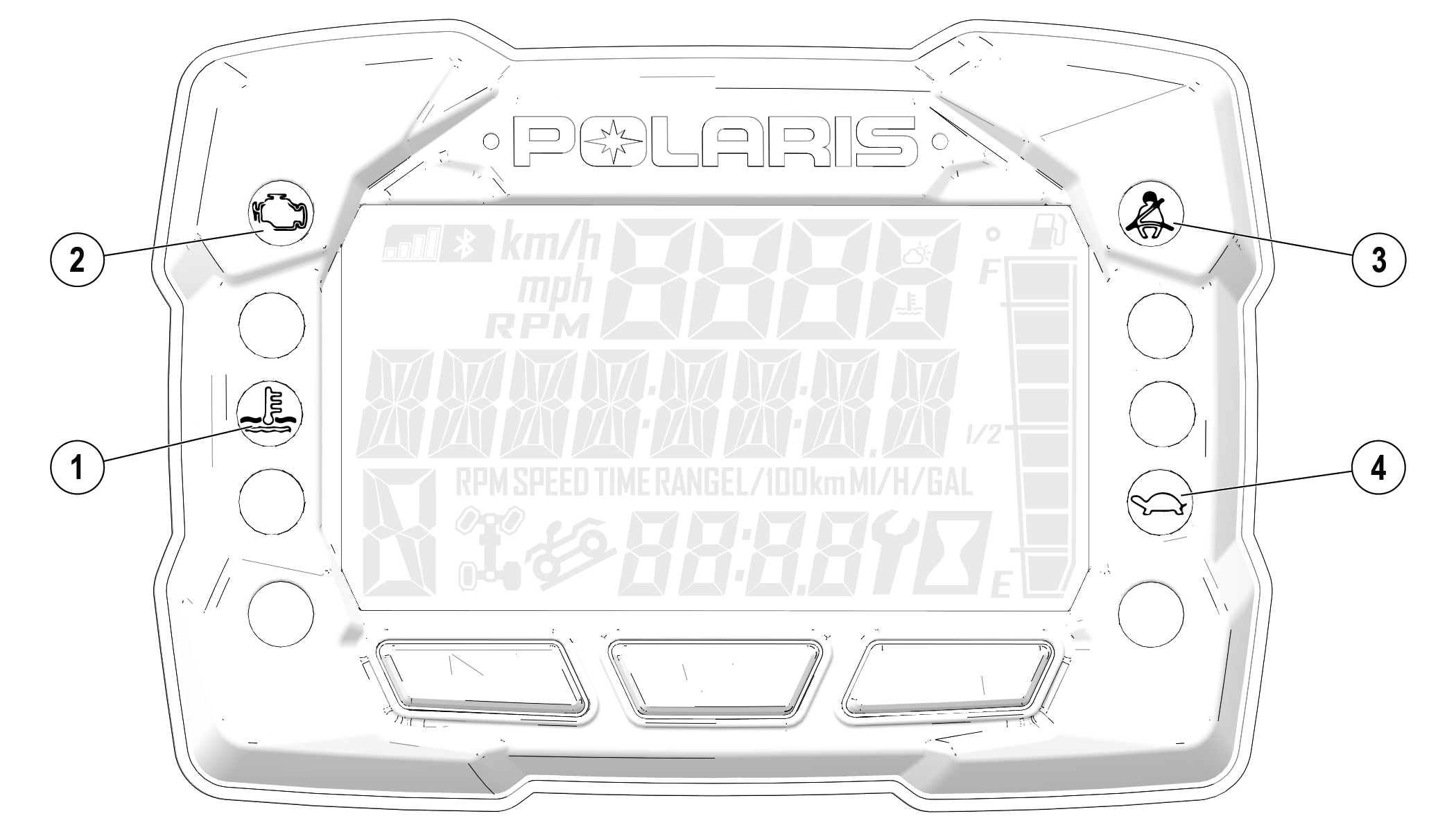
|
Indicator |
Description |
|
|---|---|---|
|
1 Engine Hot |
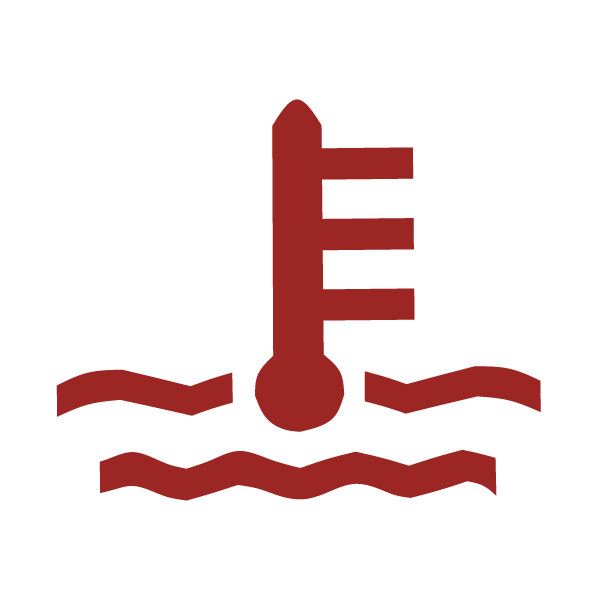
|
This lamp illuminates to indicate an overheated engine. If the indicator flashes, a severe overheating condition exists. |
|
2 Check Engine |
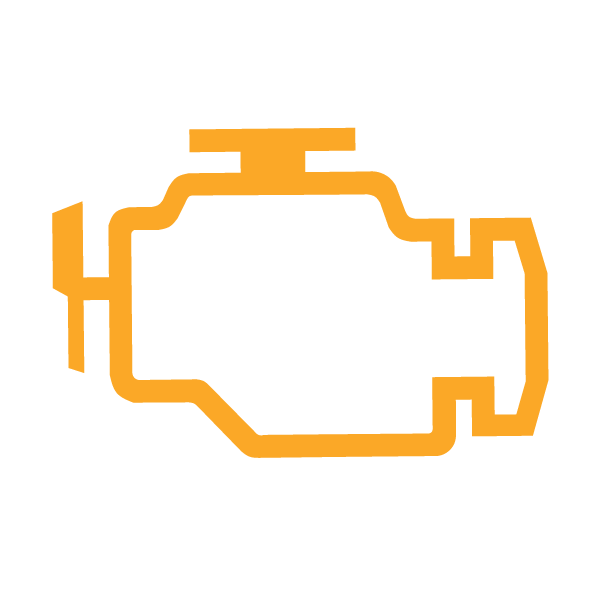
|
This indicator appears if an EFI-related fault occurs. Do not operate the vehicle if this warning appears. Serious engine damage could result. Your authorized Polaris dealer can assist. |
|
3 Helmet / Seat Belt |
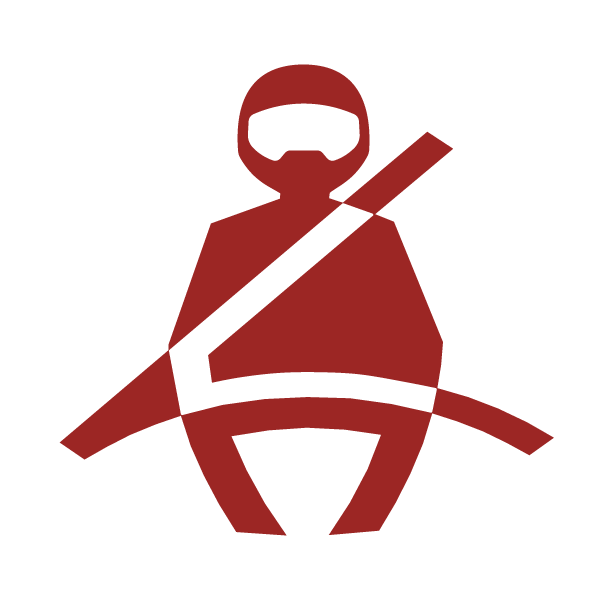
|
This lamp flashes for several seconds when the key is turned to the ON position. The lamp is a reminder to wear helmet and seat belt before operating. |
|
4 Performance Limited |
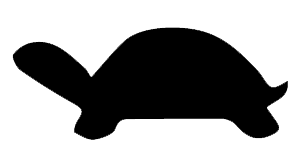
|
|
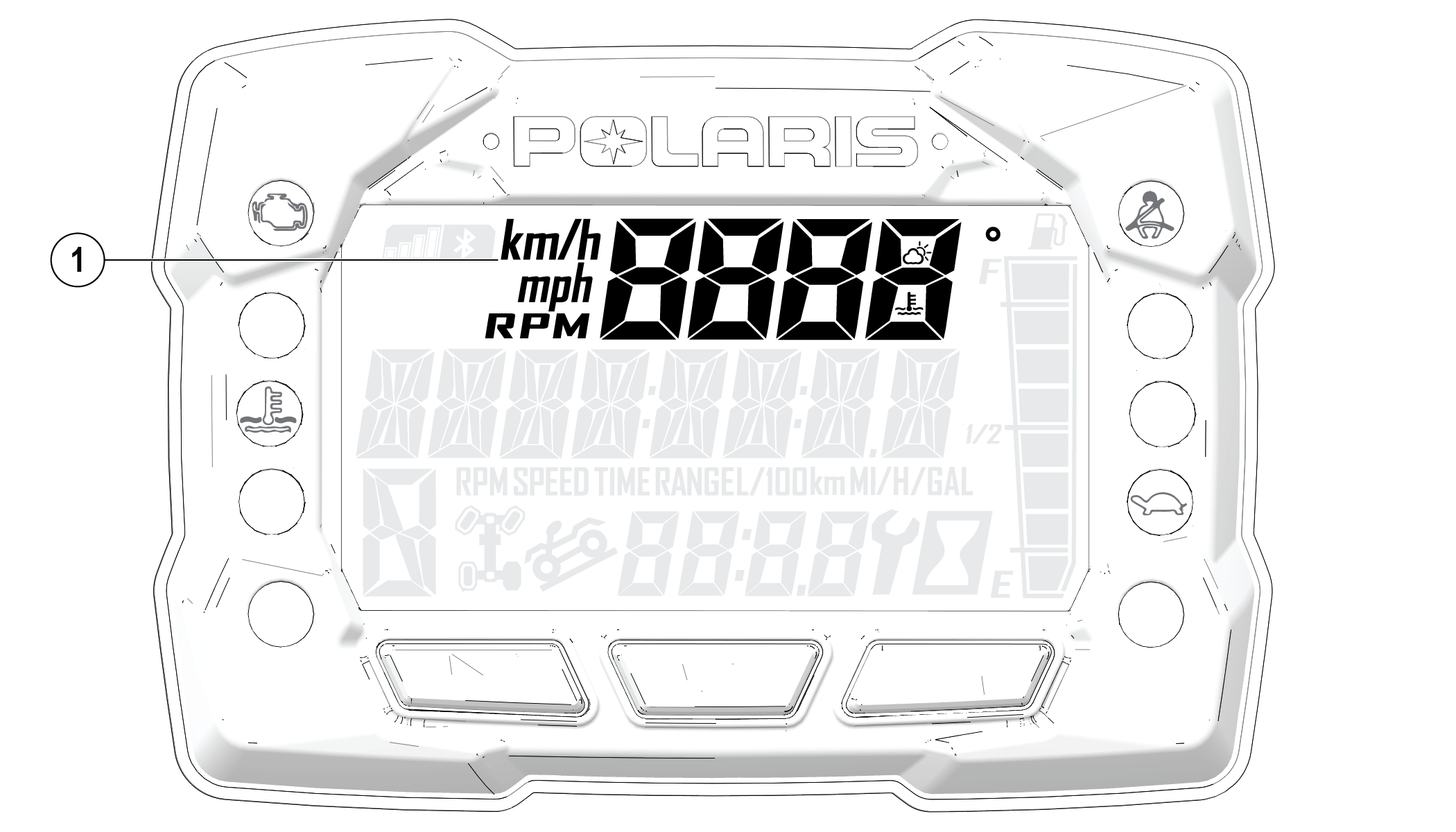
Press the MODE button to toggle through the information displayed in Area 1 1.
|
Feature |
Description |
|---|---|
|
Speed |
|
|
Engine RPMs |
|
|
Engine Temperature |
|
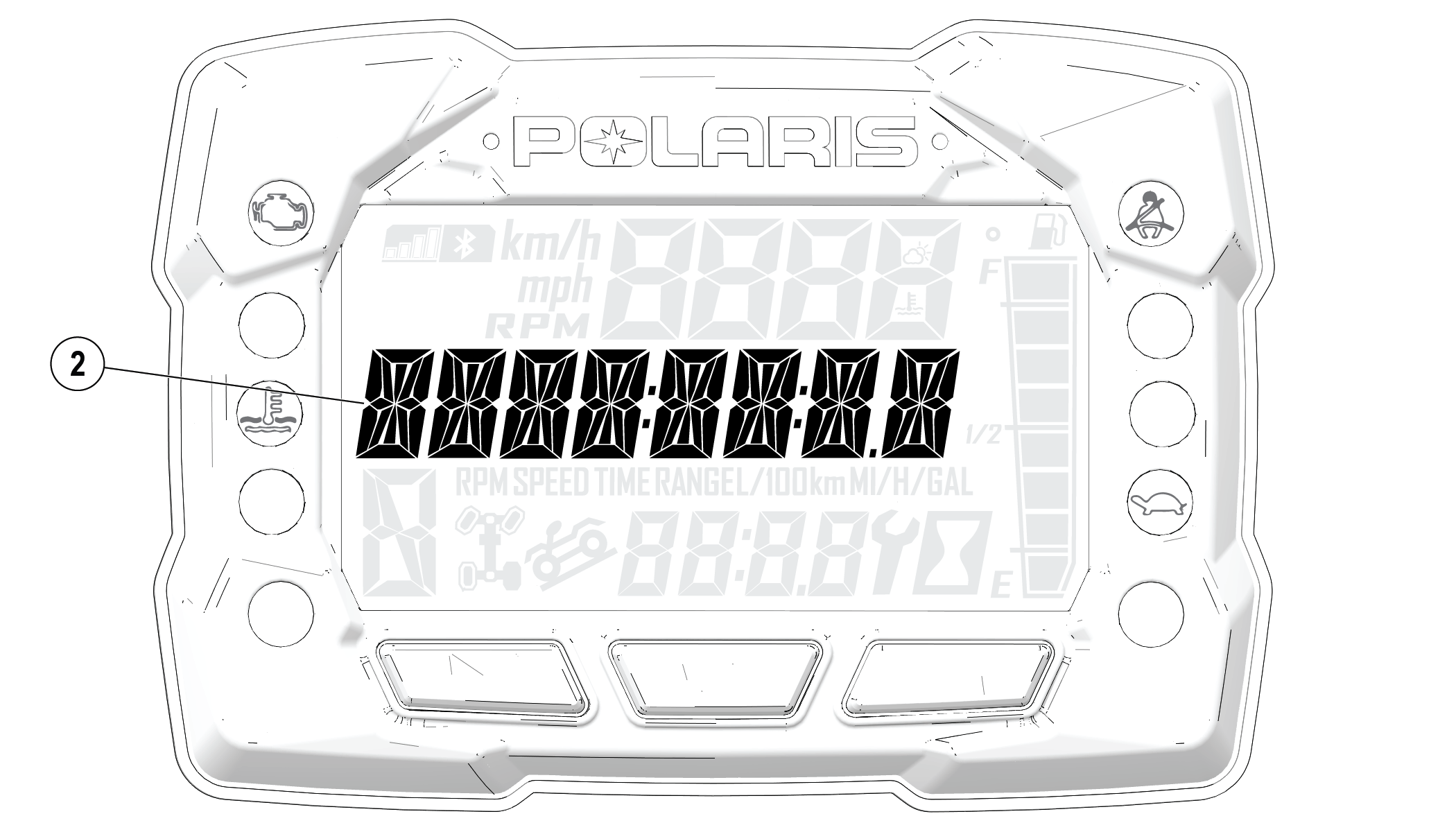
Toggle the Up/Down buttons to change the information displayed in Area 2 2.
|
Feature |
Description |
|---|---|
|
Odometer |
|
|
Service Hours |
|
|
Trip 1 |
|
|
Trip 2 |
|
|
Trip Timer |
|
|
Engine Temperature |
|
|
Voltage |
|
|
Geofence Status |
|
|
RPM |
|
|
Engine Hours |
|
|
Speed |
|
|
Helmet Aware Status |
|
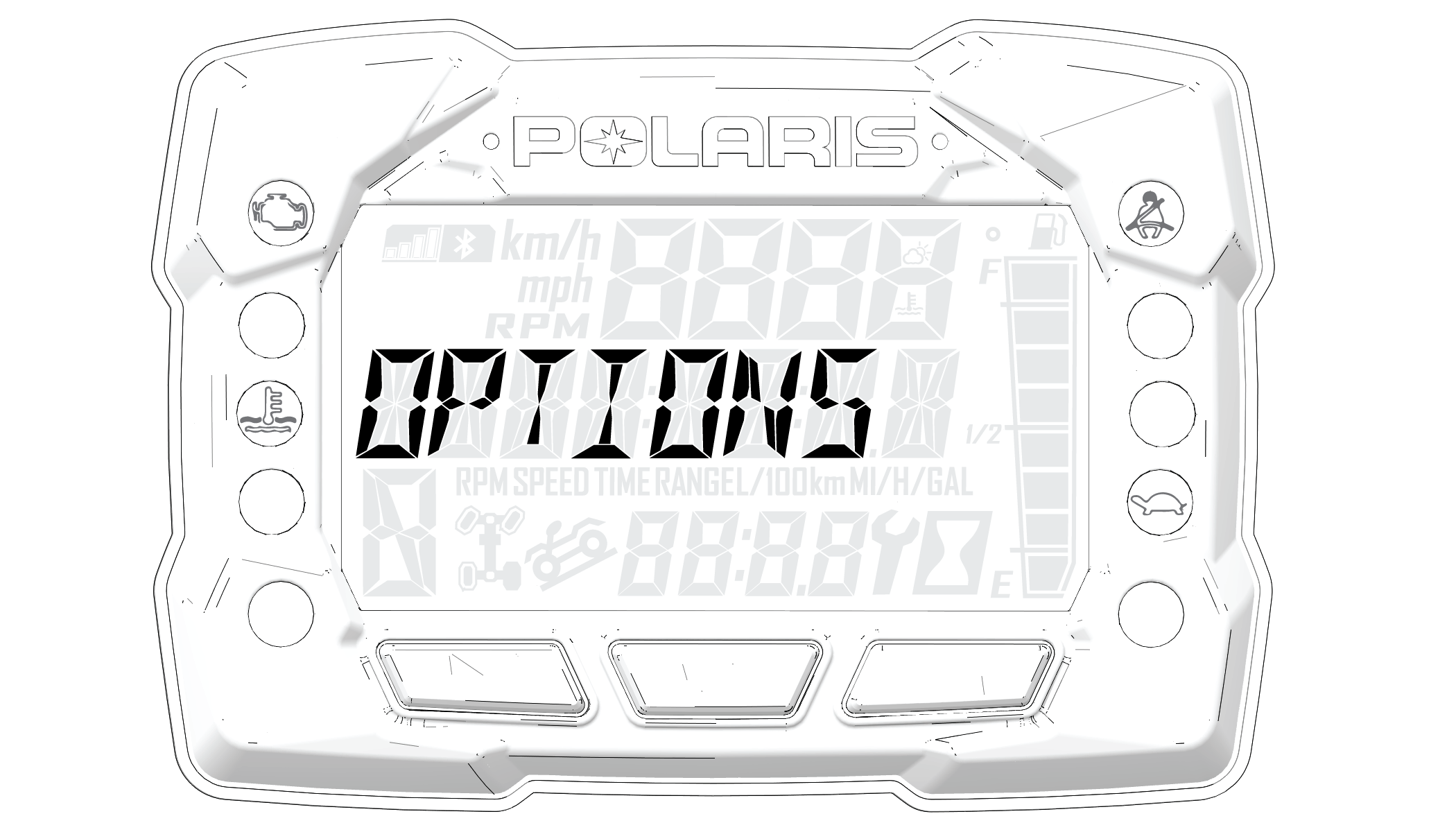
Press and hold the MODE button to enter the Options Menu.
| Options Menu | Notes |
|---|---|
| Diagnostic Codes |
Only displays if fault codes are present or stored |
| Youth Menu |
Set passcode, maximum speed, GeoFence, and helmet aware settings. |
| Units - Distance |
Select MPH or KPH |
| Units - Temp |
Select between °F and °C |
| Clock |
Select between 12H or 24H, and set time |
| Backlight Color |
Select between Blue or Red |
| Backlight Level |
Set backlight brightness level |
| Service Hours |
View/Set Service hours |
| Exit Menu |
Exit |

Diagnostic Code Screen will show available MIL that has come on during that ignition cycle.
Press and hold the MODE button to enter the Options Menu.
“OPTIONS” will display on the screen for 3 seconds before showing first menu item.
Select “Diagnostic Codes” from the Options Menu by pressing the MODE button.
Toggle the Up/Down Buttons to cycle through Code(s).
This option will only be available if a fault code was set or is active during the current ignition key 'on' cycle. Turning off the ignition will clear any saved fault codes from the gauge.
Reference the image shown above:
1 Area A will Display FMI (XX)
2 Area B will Display SPN (XXXXXX)
3 Clock Area will Display Count (XXX)
To exit the Options Menu the user can select Exit Menu function from Options Menu, can hold MODE Button and exit out of Options Menu, or not press any button for 10 seconds, which will exit out of the Options Menu.

The Youth Menu contains features that a parent can utilize to help limit the performance of the vehicle for new and inexperienced operators.
Press and hold the MODE button to enter the Options Menu.
OPTIONS will display on the screen for 3 seconds before showing first menu item.
Select YOUTH MENU from the Options Menu by pressing the MODE button.
| Youth Menu | Notes |
|---|---|
| Maximum Speed |
Set maximum Speed |
| Geofence |
Enable/Disable Geofence |
| Inside Geofence Speed |
Set inside Geofence maximum vehicle speed |
| Outside Geofence Speed |
Set outside Geofence maximum vehicle speed |
| Helmet Aware |
When enabled by a parent this function looks for the presence of a helmet beacon. A parent can decide to not let the vehicle start, limit speed to 5 mph (8 kph), or give a scrolling warning on the display if a helmet is not detected. |
| Require PIN to Start |
Enable/Disable PIN to start vehicle |
| PIN Delay |
If a PIN is required to start the engine, a PIN delay also can be enabled. This will allow the vehicle to be restarted without a PIN for a specified period of time after engine stall or shutdown. |
| Change PIN |
Change PIN |
| Exit Youth Menu |
Exit |

Press and hold the MODE button to enter the Options Menu.
OPTIONS will display on the screen for 3 seconds before showing first menu item.
Select YOUTH MENU by pressing the MODE button.
Enter PIN.
To exit the Youth Menu the user can select Exit Menu function from Youth Menu, can hold MODE button and exit out of Youth Menu, or not press any button for 10 seconds, which will exit out of the Options Menu.

Press and hold the MODE button to enter the Options Menu.
OPTIONS will display on the screen for 3 seconds before showing first menu item.
Select Youth Menu by pressing the MODE button.
Enter PIN.
Select CHANGE PIN from the Youth Menu by pressing the MODE button.
Reference the image shown above:
1 Press the MODE button.
2 Toggle the UP/DOWN buttons to increase/decrease the first digit of the new PIN.
3 With the desired first digit of the new PIN displayed, Press the MODE button which will set the digit and move to the 2nd digit.
4 Toggle the UP/DOWN buttons to increase/decrease the 2nd digit of the new PIN. Press MODE button to set 2nd digit and move on to the 3rd digit.
5 Toggle the UP/DOWN buttons to increase/decrease the 3rd digit of the new PIN. Press MODE button to set 3rd digit and move on to the 4th digit.
Press the MODE button to set the 4th digit and exit.
To exit the Youth Menu the user can select EXIT MENU function from Youth Menu, can hold MODE button and exit out of Youth Menu, or not press any button for 10 seconds, which will exit out of the Options Menu.
The speed of this vehicle is restricted to under 16 mph (26 kph) at manufacture. The speed limiting device may be adjusted by supervising adults when they determine that their child is capable of handling additional speed. The unrestricted top speed for this model is 29 mph (46 kph).
Maximum speed can be set using the process below or by using the Polaris Ride Command app.

Press and hold the MODE button to enter the Options Menu.
OPTIONS will display on the screen for 3 seconds before showing first menu item.
Select YOUTH MENU by pressing the MODE Button.
Enter PIN.
Select MAX SPEED from the Youth Menu by pressing the MODE button.
Reference the image shown above:
1 Press the MODE button.
2 Toggle the UP/DOWN buttons to increase/decrease the maximum speed.
3 With the desired maximum speed displayed, press the MODE button which will set the maximum speed and return to the Youth Menu.
To exit the Youth Menu the user can select EXIT MENU function from Youth Menu, can hold MODE button and exit out of Youth Menu, or not press any button for 10 seconds, which will exit out of the Options Menu.

Press and hold the MODE button to enter the Options Menu.
“OPTIONS” will display on the screen for 3 seconds before showing first menu item.
Select “Youth Menu” by pressing the MODE button.
Enter PIN.
Select “GEOFENCE” from the Youth Menu by pressing the MODE button.
Reference the image shown above:
1 Press the MODE button.
2 Toggle the Up/Down buttons to cycle through options (On/Off).
3 With the desired option displayed, press the MODE button which will set function and return to the Youth Menu.
To exit the Youth Menu the user can select Exit Menu function from Youth Menu, can hold Mode Button and exit out of Youth Menu, or not press any button for 10 seconds, which will exit out of the Options Menu.

Press and hold the MODE button to enter the Options Menu.
OPTIONS will display on the screen for 3 seconds before showing first menu item.
Select YOUTH MENU by pressing the MODE button.
Enter PIN.
Select INSIDE from the Youth Menu by pressing the MODE button.
Reference the image shown above:
1 Press the MODE button.
2 Toggle the UP/DOWN buttons to increase/decrease inside Geofence maximum speed.
3 With the desired speed displayed, press the MODE button which will set the inside Geofence speed and return to the Youth Menu.
To exit the Youth Menu the user can select EXIT MENU function from Youth Menu, can hold MODE button and exit out of Youth Menu, or not press any button for 10 seconds, which will exit out of the Options Menu.

Press and hold the MODE button to enter the Options Menu.
OPTIONS will display on the screen for 3 seconds before showing first menu item.
Select YOUTH MENU by pressing the MODE button.
Enter PIN.
Select OUTSIDE from the Youth Menu by pressing the MODE button.
Reference the image shown above:
1 Press the MODE button.
2 Toggle the UP/DOWN buttons to increase/decrease OUTSIDE Geofence maximum speed.
3 With the desired speed displayed, press the MODE button which will set the outside Geofence speed and return to the Youth Menu.
To exit the Youth Menu the user can select EXIT MENU function from Youth Menu, can hold MODE button and exit out of Youth Menu, or not press any button for 10 seconds, which will exit out of the Options Menu.

Press and hold the MODE button to enter the Options Menu.
OPTIONS will display on the screen for 3 seconds before showing first menu item.
Select YOUTH MENU by pressing the MODE button.
Enter PIN.
Select REQUIRE PIN TO START from the Youth Menu by pressing the MODE button.
Reference the image shown above:
1 Press the MODE button.
2 Toggle the UP/DOWN buttons to enable/disable requiring PIN to start vehicle.
3 With the desired option displayed, press the MODE button which will set the function and return to the Youth Menu.
To exit the Youth Menu the user can select EXIT MENU function from Youth Menu, can hold MODE button and exit out of Youth Menu, or not press any button for 10 seconds, which will exit out of the Options Menu.

Press and hold the MODE button to enter the Options Menu.
OPTIONS will display on the screen for 3 seconds before showing first menu item.
Select YOUTH MENU by pressing the MODE button.
Enter PIN.
Select PIN DELAY from the Youth Menu by pressing the MODE button.
Reference the image shown above:
1 Press the MODE button.
2 Toggle the UP/DOWN buttons to enable/disable the pin delay.
3 With the desired option displayed, press the MODE button which will set the function and return to the Youth Menu.
To exit the Youth Menu the user can select EXIT MENU function from Youth Menu, can hold MODE button and exit out of Youth Menu, or not press any button for 10 seconds, which will exit out of the Options Menu.
To use all of the helmet aware features first download the Polaris Ride Command app and sign up. Turning the helmet aware feature on and off can be done through the vehicle display but the helmet not detected behavior must be selected through the Ride Command app.

Press and hold the MODE button to enter the Options Menu.
OPTIONS will display on the screen for 3 seconds before showing first menu item.
Select YOUTH MENU by pressing the MODE button.
Enter PIN.
Select HELMET A from the Youth Menu by pressing the MODE button.
Reference the image shown above:
1 Press the MODE button.
2 Toggle the UP/DOWN buttons to cycle through options (On/Off).
3 With the desired option displayed, press the MODE button which will set function and return to the Youth Menu.
To exit the Youth Menu the user can select EXIT MENU function from Youth Menu, can hold MODE button and exit out of Youth Menu, or not press any button for 10 seconds, which will exit out of the Options Menu.

Press and hold the MODE button to enter the Options Menu.
“OPTIONS” will display on the screen for 3 seconds before showing first menu item.
Select “Youth Menu” by pressing the MODE button.
Enter PIN.
Select “CHANGE PIN” from the Youth Menu by pressing the MODE button.
Reference the image shown above:
1 Press the MODE button.
2 Toggle the Up/Down buttons to increase/decrease the first digit of the new PIN.
3 With the desired first digit of the new PIN displayed, Press the MODE button which will set the digit and move to the 2nd digit.
4 Toggle the Up/Down Buttons to increase/decrease the 2nd digit of the new PIN. Press MODE button to set 2nd digit and move on to the 3rd digit.
5 Toggle the Up/Down Buttons to increase/decrease the 3rd digit of the new PIN. Press MODE button to set 3rd digit and move on to the 4th digit.
Press the MODE button to set the 4th digit and exit.
To exit the Youth Menu the user can select Exit Menu function from Youth Menu, can hold Mode button and exit out of Youth Menu, or not press any button for 10 seconds, which will exit out of the Options Menu.

Press and hold the MODE button to enter the Options Menu.
“OPTIONS” will display on the screen for 3 seconds before showing first menu item.
Select “Units-Distance” from the Options Menu by pressing the MODE button.
Reference the image shown above:
1 Press the MODE button.
2 Toggle the Up/Down Buttons to change the units (MPH or KPH)
3 With the correct unit displayed, press the MODE button which will set the unit and return to the Options Menu.
To exit the Options Menu the user can select Exit Menu function from Options Menu, can hold MODE Button and exit out of Options Menu, or not press any button for 10 seconds, which will exit out of the Options Menu.

Press and hold the MODE button to enter the Options Menu.
“OPTIONS” will display on the screen for 3 seconds before showing first menu item.
Select “Units - Temp” from the Options Menu by pressing the MODE button.
Reference the image shown above:
1 Press the MODE button.
2 Toggle the Up/Down Buttons to change the units (°F or °C)
3 With the correct unit displayed, press the MODE button which will set the unit and return to the Options Menu.
To exit the Options Menu the user can select Exit Menu function from Options Menu, can hold MODE Button and exit out of Options Menu, or not press any button for 10 seconds, which will exit out of the Options Menu.
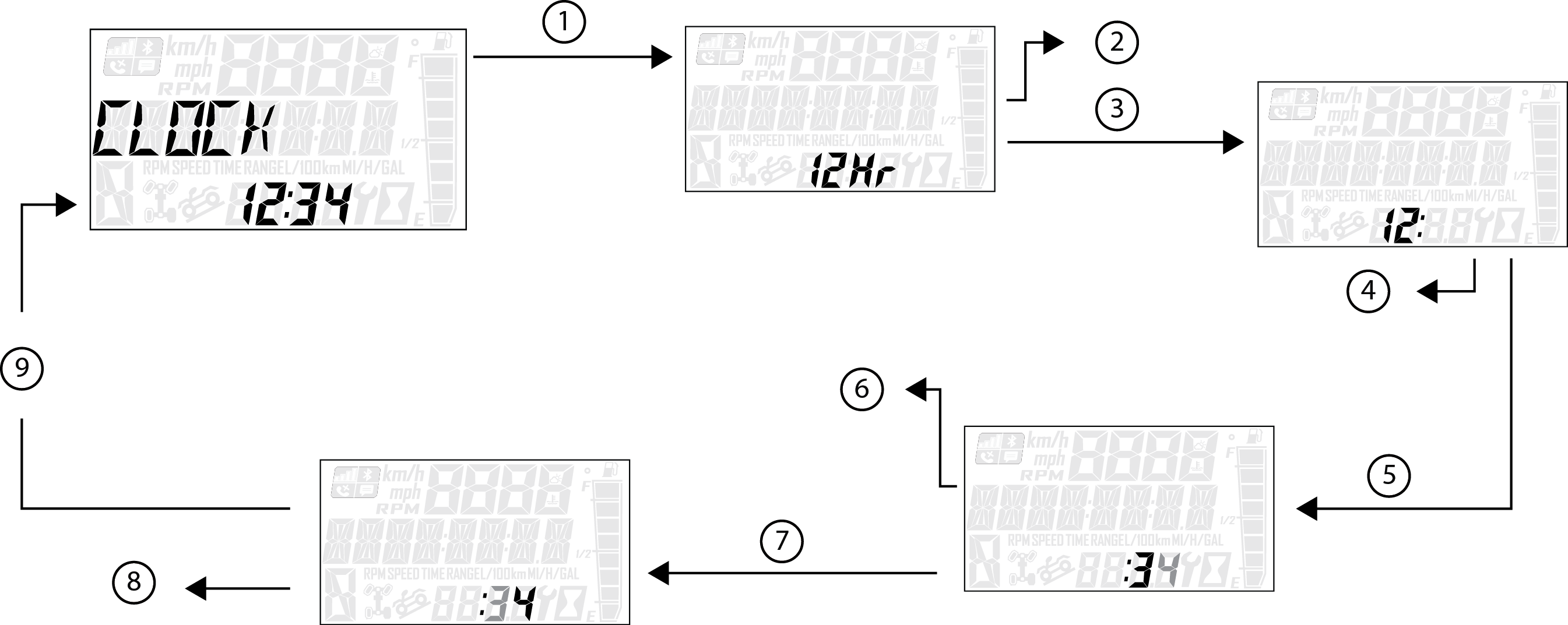
Press and hold the MODE button to enter the Options Menu.
“OPTIONS” will display on the screen for 3 seconds before showing first menu item.
Select “Clock” from the Options Menu by pressing the MODE button.
Reference the image shown above:
1 Press the MODE button.
2 Toggle the Up/Down Buttons to change the units (12H or 24H)
3 With the correct unit displayed, Press the MODE button which will set the unit.
4 Toggle the Up/Down Buttons to change the units (Cycles Hours)
5 With the correct unit displayed, Press the MODE button which will set the unit.
6 Toggle the Up/Down Buttons to change the units (Cycles 10s of Minutes)
7 With the correct unit displayed, Press the MODE button which will set the unit.
8 Toggle the Up/Down Buttons to change the units (Cycles 1s of Minutes)
9 With the correct unit displayed, Press the MODE button which will set the unit and return to the Options Menu.
To exit the Options Menu the user can select Exit Menu function from Options Menu, can hold MODE button and exit out of Options Menu, or not press any button for 10 seconds, which will exit out of the Options Menu.

Press and hold the MODE button to enter the Options Menu.
“OPTIONS” will display on the screen for 3 seconds before showing first menu item.
Select “Backlight Color” from the Options Menu by pressing the MODE button.
Reference the image shown above:
1 Press the MODE button.
2 Toggle the Up/Down Buttons to change the units (Blue or Red)
3 With the correct unit displayed, Press the MODE button which will set the unit and return to the Options Menu.
To exit the Options Menu the user can select Exit Menu function from Options Menu, can hold MODE Button and exit out of Options Menu, or not press any button for 10 seconds, which will exit out of the Options Menu.

Press and hold the MODE button to enter the Options Menu.
“OPTIONS” will display on the screen for 3 seconds before showing first menu item.
Select “Backlight Level” from the Options Menu by pressing the MODE button.
Reference the image shown above:
1 Press the MODE button.
2 Toggle the Up/Down Buttons to change the units (Increase or Decrease Level)
3 With the correct unit displayed, Press the MODE button which will set the unit and return to the Options Menu.
To exit the Options Menu the user can select Exit Menu function from Options Menu, can hold MODE Button and exit out of Options Menu, or not press any button for 10 seconds, which will exit out of the Options Menu.

Press and hold the MODE button to enter the Options Menu.
“OPTIONS” will display on the screen for 3 seconds before showing first menu item.
Select “Service Hours” from the Options Menu by pressing the MODE button.
Reference the image shown above:
1 Press the MODE button.
2 Toggle the Up/Down Buttons to change the units (0, 5, 10 - 95, 100)
3 With the correct unit displayed, press the MODE button, which will set the unit and return you to the Options Menu.
To reset service hours after they have counted down to "0.0", reselect the existing setpoint or select a new service hour value.
To exit the Options Menu the user can select Exit Menu function from Options Menu, can hold MODE Button and exit out of Options Menu, or not press any button for 10 seconds, which will exit out of the Options Menu.
Failure to operate the vehicle properly can result in a collision, loss of control, accident or rollover, which may result in serious injury or death. Read and understand all safety warnings outlined in the safety section of this owner’s manual.
The break-in period for your new vehicle is the first 25 hours of operation, or the time it takes to use the first 2 full tanks of gasoline. No single action on your part is as important as a proper break-in period. Careful treatment of a new engine will result in more efficient performance and longer life for the engine. Perform the following procedures carefully.
Excessive heat build-up during the first 3 hours of operation will damage close-fitted engine parts and drive components. Do not operate at full throttle or high speeds during the first 3 hours of use.
Apply only moderate braking force for the first 50 stops. Aggressive or overly forceful braking when the brake system is new could damage brake pads and rotors.
A proper break-in of the clutches and drive belt will ensure a longer life and better performance. Break in the clutches and belt by operating at slower speeds during the break-in period as recommended. Pull only light loads. Avoid aggressive acceleration and high speed operation during the break-in period.
If a belt fails, always clean any debris from the CVT intake and outlet duct and from the clutch and engine compartments when replacing the belt.
Familiarize yourself with all laws and regulations concerning the operation of this vehicle in your area. Respect the environment in which you ride your vehicle. Find out where the designated riding areas are by contacting your POLARIS dealer, a local riding club, or local officials.
Help keep our trails open for recreational vehicle use. As an off-road enthusiast, you represent the sport and can set a good example (or a poor example) for others to follow. Tread LightlySM. Operate with respect for the terrain, avoid littering, and always stay on the designated trails.
Failure to inspect and verify that the vehicle is in safe operating condition before operating increases the risk of an accident. Always inspect the vehicle before each use to make sure it's in safe operating condition.
| Item | Remarks | Page |
|---|---|---|
| Brake system/pedal travel | Ensure proper operation | Brakes |
| Brake fluid | Ensure proper level | Brakes |
| Front suspension | Inspect, lubricate if necessary | Lubrication Recommendations |
| Rear suspension | Inspect, lubricate if necessary | Lubrication Recommendations |
| Steering | Ensure free operation | - |
| Tires | Inspect condition and pressure | Tires |
| Wheels/fasteners | Inspect, ensure fastener tightness | Tires |
| Frame nuts, bolts, fasteners | Inspect, ensure tightness | - |
| Drive Belt | Inspect, ensure installed correctly | - |
| Fuel and oil | Ensure proper levels | Oil Recommendations |
| Throttle | Ensure proper operation | Brake and Throttle Pedals |
| Indicator lights/switches | Ensure proper operation | Indicator Lamps |
| Intake pre-filters | Inspect, clean | - |
| Daytime Running Lights (LED) | Check operation | Daytime Running Lamps |
| Brake light/tail lamps | Check operation | - |
| Seat Latch | Push down on the seat back to ensure the latch is secure | - |
| Seat Belt | Check length of belt for damage, check latches for proper operation | Seat Belts |
| Cab Doors and Nets (if equipped) | Check doors and latches for wear or damage. | - |
| Helmet Aware System | Check the condition of the battery in the helmet beacon. | Helmet Aware |
| Grass and Leaves | Remove grass, leaves, foreign matter, and other flammable material or debris, especially near the exhaust system | - |
Position the vehicle on a level surface outdoors or in a well ventilated area.
Sit in the driver's seat and fasten the seat belt. Secure the cab nets.
Place the transmission in NEUTRAL and apply the PARKING BRAKE.
Apply the brakes. Do not press the throttle pedal while starting the engine.
Turn the ignition key past the ON/RUN position to START. Engage the starter for a maximum of five seconds. Release the key when the engine starts.
If the engine does not start within five seconds, return the ignition switch to the OFF position and wait five seconds. Repeat steps 5 and 6 until the engine starts.
Vary the engine RPM slightly with the throttle to aid in warm up until the engine idles smoothly.
Release the throttle pedal completely and brake to a complete stop.
Place the transmission in NEUTRAL and apply the PARKING BRAKE.
Turn the engine off.
Slowly release the brake pedal and make sure the transmission is in PARK before exiting the vehicle.
Your vehicle is equipped with daytime running lamps. The lamps illuminate for extra visibility, but are not designed for night driving. Do not allow operation of the machine in the dark.
If the vehicle is used year-round, check the oil level frequently. A rising oil level could indicate the accumulation of contaminates such as water or excess fuel in the bottom of the crankcase. Water in the bottom of the crankcase can lead to engine damage and must be drained. Water accumulation increases as outside temperature decreases.
Release the throttle pedal completely.
Press on the brake pedal evenly and firmly. Practice starting and stopping (using the brakes) until you're familiar with the controls.
Stop the vehicle on a level surface. When parking inside a garage or other structure, be sure that the structure is well ventilated and that the vehicle is not close to any source of flame or sparks, including any appliance with pilot lights.
Place the transmission in NEUTRAL and apply the PARKING BRAKE.
Turn the engine off.
Slowly release the brake pedal.
Remove the ignition key to prevent unauthorized use.
Avoid parking on an incline if possible. If it's unavoidable, follow these precautions:
Apply the brakes.
Place the transmission in NEUTRAL and apply the PARKING BRAKE.
Turn the engine off.
Slowly release the brake pedal.
Block the rear wheels on the downhill side.
Overloading the vehicle or carrying or towing cargo improperly can alter vehicle handling and may cause loss of control or brake instability. Always follow these precautions when hauling cargo:
Never exceed the stated load capacity for this vehicle.
REDUCE SPEED AND ALLOW GREATER DISTANCES FOR BRAKING WHEN HAULING CARGO.
NEVER EXCEED THE MAXIMUM WEIGHT CAPACITY of the vehicle. When determining the weight you are adding to the vehicle, include the weight of the operator, accessories, and loads in the rack or box. The combined weight of these items must not exceed the maximum weight capacity.
Always load the cargo box with the load centered and as low as possible.
When operating over rough or hilly terrain, reduce speed and cargo to maintain stable driving conditions.
Always operate the vehicle with extreme care when hauling loads.
SECURE ALL LOADS BEFORE OPERATING. Unsecured loads can create unstable operating conditions, which could result in loss of control of the vehicle.
OPERATE ONLY WITH STABLE AND SAFELY ARRANGED LOADS. When handling off-centered loads that cannot be centered, securely fasten the load and operate with extra caution.
HEAVY LOADS CAN CAUSE BRAKING AND CONTROL PROBLEMS. Use extreme caution when applying brakes with a loaded vehicle. Avoid terrain or situations that may require backing downhill.
USE EXTREME CAUTION when operating with loads that extend over the rack sides. Stability and maneuverability may be adversely affected, causing vehicle rollover.
Carrying a passenger in the cargo box could result in a fall from the vehicle or contact with moving components. Never allow a passenger to ride in the cargo box.
Read and understand the owner's manual and all warning and instruction labels before operating this vehicle.
Visit the Recreational Off-Highway Vehicle Association® web site and take the free on-line training course. Visit www.rohva.org or call 866-267-2751. Hands-on training is also available through ROHVA®.
Perform the pre-ride inspection.
Do not carry cargo during this period.
Select an open area that allows room to familiarize yourself with vehicle operation and handling.
The driver and passenger must wear helmet, eye protection, gloves, long-sleeve shirt, long pants, over-the-ankle boots and seat belt at all times.
Sit in the driver's seat and fasten the seat belt.
Always make sure all doors and cab nets are closed and latched when riding in this vehicle.
Place the transmission in NEUTRAL.
Start the engine and disengage the parking brake.
Apply the brakes and shift into gear.
Check your surroundings and determine your path of travel.
Keeping both hands on the steering wheel, slowly release the brakes and depress the throttle with your right foot to begin driving.
Drive slowly at first. On level surfaces, practice starting, stopping, turning, maneuvering, using the throttle and brakes and driving in reverse. Learn how the vehicle handles when making both left and right turns at a slow speed.
Increase speed only after mastering all maneuvers at a slow speed.
After you become skilled at making turns and begin to operate at faster speeds, follow these precautions:
Avoid sharp turns.
Never turn while applying heavy throttle.
Never make abrupt steering maneuvers.
Operate at speeds appropriate for your skills, the conditions and the terrain.
DO NOT do power slides, “donuts”, jumps or other driving stunts.
Perform the pre-ride inspection.
Make sure all passengers are at least 10 years of age and tall enough to comfortably and safely sit in the passenger seat with the seat belt secured, put both feet on the floor and grasp the hand hold.
Make sure passenger is wearing helmet, eye protection, gloves, long-sleeve shirt, long pants and over-the-ankle boots.
Make sure passenger secures their seat belt.
Make sure all cab nets are properly secured.
Do not carry more than the recommended number of passengers for your vehicle.
Allow a passenger to ride only in a passenger seat.
Slow down. Always travel at a speed appropriate for your skills, your passenger’s skills, and operating conditions. Avoid unexpected or aggressive maneuvers that could cause discomfort or injury to a passenger.
Vehicle handling may change with a passenger and/or cargo on board. Allow more time and distance for braking.
Always follow all operating guidelines as outlined on safety labels and in this manual.

When driving on slippery surfaces such as wet trails, loose gravel, or ice, be alert for the possibility of skidding and sliding. Follow these precautions when encountering slippery conditions:
Do not operate on excessively rough, slippery or loose terrain.
Slow down before entering slippery areas.
Maintain a high level of alertness, reading the trail and avoiding quick, sharp turns, which can cause skids.
Correct a skid by turning the steering wheel in the direction of the skid. Never apply the brakes during a skid.
Follow these precautions when operating over obstacles:
Always check for obstacles before operating in a new area.
Look ahead and learn to read the terrain. Be constantly alert for hazards such as logs, rocks and low hanging branches.
Travel slowly and use extra caution when operating on unfamiliar terrain. Not all obstacles are immediately visible.
Move the gear selector to Low Gear, if needed.
Avoid operating over large obstacles such as large rocks and fallen trees. If unavoidable, use extreme caution and operate slowly.
Always have all passengers dismount and move away from the vehicle before operating over an obstacle that could cause a rollover.
Whenever traveling uphill, follow these precautions:
Avoid excessively steep hills.
Always travel straight uphill.
Keep both feet on the floor.
Always check the terrain carefully before ascending any hill. Never climb hills with excessively slippery or loose surfaces.
Proceed at a steady rate of speed and throttle opening. Never open the throttle suddenly.
Never go over the crest of a hill at high speed. An obstacle, a sharp drop, or another vehicle or person could be on the other side of the hill.
When driving downhill, follow these precautions:
Avoid excessively steep hills.
Always descend a hill with the direction selector switch on forward. Never descend a hill with the switch on neutral.
Drive straight downhill. Avoid descending a hill at an angle, which would cause the vehicle to lean sharply to one side. Travel straight downhill when possible.
Slow down.
Apply the brakes slightly to aid in slowing.
Driving on a sidehill is not recommended. Improper procedure could cause loss of control or rollover. Avoid crossing the side of any hill unless absolutely necessary.
If crossing a sidehill is unavoidable, follow these precautions:
Slow down.
Exercise extreme caution.
Avoid crossing the side of a steep hill.
Your vehicle can drive through shallow water. Make sure the water is no deeper than the floor 1 of the vehicle. Follow these precautions when driving through water:
Check water depth. Never drive through water that is deeper than the floor level.
After driving through water, test the brakes. Apply the lightly several times while driving slowly. The Friction will help dry out the pads.
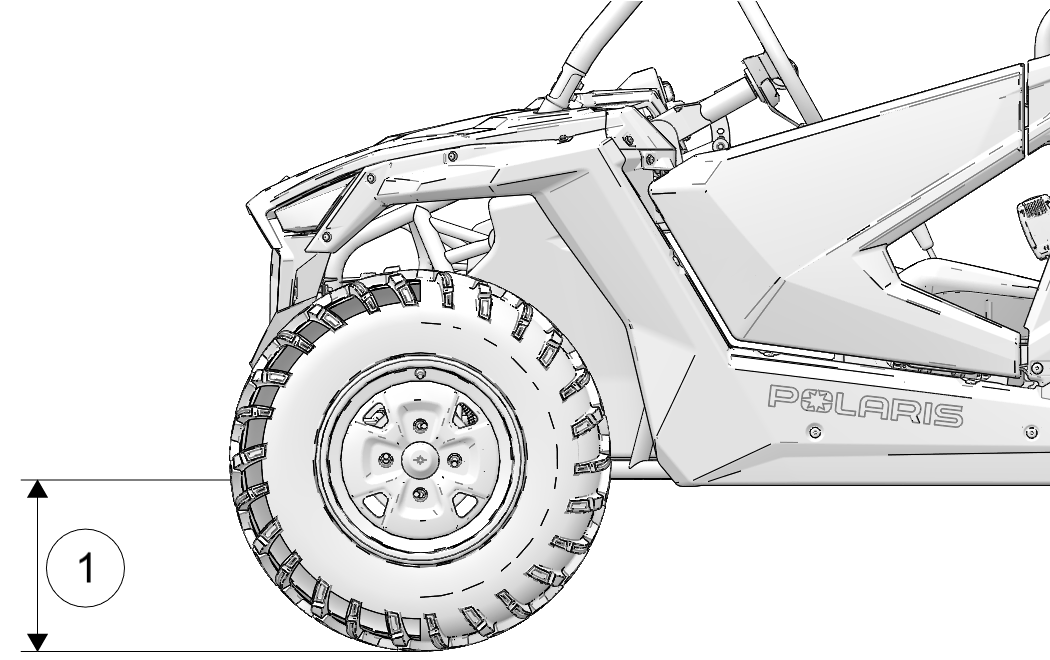
Follow these precautions when operating in reverse:
Always check for obstacles or people behind the vehicle. Always inspect left and right fields of vision before backing.
Always avoid backing downhill.
Back slowly.
Apply the brakes lightly for stopping.
Avoid turning at sharp angles.
Never open the throttle suddenly.
Do not modify the engine, intake or exhaust components, as doing so may affect compliance with U.S.A. EPA noise control requirements (40 CFR 205) and local noise level requirements.
Your vehicle has a spark arrester that was tested and qualified to be in accordance with the USFS standard 5100-1D. Federal law requires that this spark arrester be installed and functional when the vehicle is operated on public lands.
Operation of off-road vehicles on public lands in the U.S.A. is regulated by 43 CFR 420. Violations are subject to monetary penalties. Federal regulations can be viewed online at https://ecfr.federalregister.gov/current/title-43/subtitle-B/chapter-I/part-420.
This engine is equipped with a closed crankcase system. Blow-by gases are forced back to the combustion chamber by the intake system. All exhaust gases exit through the exhaust system.
Exhaust emissions are controlled by engine design. An electronic fuel injection (EFI) system controls fuel delivery. The engine and EFI components are set at the factory for optimal performance and are not adjustable.
The emissions label is located on the inside of the lower left frame tube (below driver’s foot area).
This spark ignition system complies with Canadian ICES-002.
This vehicle complies with the EMC requirements of UN ECE Regulation 10.
Non-ionizing Radiation: This vehicle emits some electromagnetic energy. People with active or non-active implantable medical devices (such as heart monitoring or controlling devices) should review the limitations of their device and the applicable electromagnetic standards and directives that apply to this vehicle.
Engine exempt from non-road mobile machinery (NRMM) pollutant emissions Regulation (EU) 2016/1628.
Engine used in reduced-scale vehicle model for recreational purposes, net power < 19 kW.
Any qualified repair shop or person may maintain, replace or repair the emission control devices or systems on your vehicle. An authorized Polaris dealer can perform any service that may be necessary for your vehicle. Polaris also recommends Polaris parts for emissions-related service, however equivalent parts can be used.
It is a potential violation of the Clean Air Act if a part supplied by an aftermarket parts manufacturer reduces the effectiveness of the vehicle’s emission controls. Tampering with emission controls is prohibited by federal law.
Owners are responsible for performing the scheduled maintenance identified in this owner’s manual.
Careful periodic maintenance will help keep your vehicle in the safest, most reliable condition. Inspection, adjustment and lubrication of important components are explained in the Polaris maintenance chart.
Inspect, clean, lubricate, adjust and replace parts as necessary. When inspection reveals the need for replacement parts, genuine Polaris parts are available from your Polaris dealer. Equivalent parts may be used for emissions-related service.
Service and adjustments are important for proper vehicle operation. If you’re not familiar with safe service and adjustment procedures, a qualified dealer can perform these operations.
The intervals shown are based on vehicles operated under normal conditions.
Each interval is given in hours and miles (kilometers). Items should be serviced at whichever interval comes first.
Continue to reference the following maintenance schedules at the given intervals as hours and miles (kilometers) increase on the vehicle.
Vehicles subjected to severe use must be serviced at 50% of the stated interval. Examples of Severe Use: Frequent immersion in mud, water, or sand, constant high RPM use, prolonged low-speed heavy load operation, extended idle, and short trip cold weather operation.
| Initial Break-In
Service First 12 Hours / 100 mi (160 km) |
|
|---|---|
| Brake Pads, Brake Lines / Hoses | Inspect. |
| Drive Chain | Adjust and lubricate. |
| Engine Oil and Filter | Change the engine oil and filter. |
| Valve Lash* | Adjust. |
| The break-in period consists of the first 12 hours of operation. Careful treatment of a new engine and drive components will result in more efficient performance and longer life for these components. The items outlined in this service interval only need to be performed at the first 12 hours of operation. They do not need to be performed every 12 hours. | |
| * Have an authorized Polaris dealer or other qualified person perform these services. | |
Vehicles subjected to severe use must be serviced at 50% of the stated interval. Examples of Severe Use: Frequent immersion in mud, water, or sand, constant high RPM use, prolonged low-speed heavy load operation, extended idle, and short trip cold weather operation.
| Every 50 Hours / 500 mi (800 km) | |
|---|---|
| Battery | Check terminals; terminals should be tight and free of corrosion. Clean, test, and replace as necessary. |
| Brake System | Inspect for fluid leaks; add recommended brake fluid from a sealed container if needed. |
| Drive Chain | Inspect; adjust; lubricate. |
| Engine Oil and Filter | Change the engine oil and filter. |
| Front / Rear Suspension* | Inspect for loose or worn components; replace as needed. Lubricate. Inspect shock absorbers for leaks or damage. |
| Fuel System / Filter* | Inspect; cycle key to pressurize fuel pump; check for leaks at fuel system connections, check for leaks at fill cap. |
| General Lubrication | Locate all applicable grease fittings (zerks) and grease. |
| Shift Cable / Linkage | Inspect; adjust; lubricate. |
| Steering Components | Inspect; replace as needed. |
| Throttle Body Intake Ducts / Flanges | Inspect for proper sealing and air leaks. |
| Wheels / Tires / Lug Nuts | Inspect; replace as needed. |
| Valve Lash* | Inspect; adjust as needed. |
| * Have an authorized Polaris dealer or other qualified person perform these services. | |
Vehicles subjected to severe use must be serviced at 50% of the stated interval. Examples of Severe Use: Frequent immersion in mud, water, or sand, constant high RPM use, prolonged low-speed heavy load operation, extended idle, and short trip cold weather operation.
| Every 100 Hours / 1000 mi (1600 km) or Yearly | |
|---|---|
| Air Filter | Replace air filter. Ensure proper installation of filter and airbox cover. Inspect ducts and screens; clean as necessary. |
| Battery | Check terminals; terminals should be tight and free of corrosion. Clean, test, and replace as necessary. |
| Brake Pads, Brake Lines / Hoses | Inspect; replace as needed. |
| Brake System | Inspect for fluid leaks; add recommended brake fluid from a sealed container if needed. |
| Clutches (Drive and Driven)* | Inspect; clean; replace as needed. |
| Drive Belt | Inspect; replace as needed. |
| Drive Chain | Inspect; adjust; lubricate. |
| Engine Mounts | Inspect. |
| Engine Oil and Filter | Change the engine oil and filter. |
| Exhaust Silencer / Pipe | Inspect for leaks or damage. |
| Front / Rear Suspension* | Inspect for loose or worn components; replace as needed. Lubricate. Inspect shock absorbers for leaks or damage. |
| Fuel System / Filter* | Inspect; cycle key to pressurize fuel pump; check for leaks at fuel system connections, check for leaks at fill cap. |
| General Lubrication | Locate all applicable grease fittings (zerks) and grease. |
| Shift Cable / Linkage | Inspect; adjust; lubricate. |
| Spark Arrestor | Inspect; clean. |
| Spark Plugs | Inspect; replace as needed. |
| Steering Components | Inspect; replace as needed. |
| Throttle Body Intake Ducts / Flanges | Inspect for proper sealing and air leaks. |
| Transmission Fluid | Change fluid. |
| Valve Lash* | Inspect; adjust as needed. |
| Wheel Bearings | Inspect; replace as needed. |
| Wheels / Tires / Lug Nuts | Inspect; replace as needed. |
| Wiring | Inspect for wear, routing, and retention. |
| * Have an authorized Polaris dealer or other qualified person perform these services. | |
Vehicles subjected to severe use must be serviced at 50% of the stated interval. Examples of Severe Use: Frequent immersion in mud, water, or sand, constant high RPM use, prolonged low-speed heavy load operation, extended idle, and short trip cold weather operation.
| Additional Maintenance Intervals | ||
|---|---|---|
|
Every 200 hours / 2000 mi (3200 km) or Every 24 months / 2 years |
Brake Fluid | Change fluid. |
|
Every 200 hours / 2000 mi (3200 km) |
Shock Absorbers* | Replace as needed. |
Check and lubricate all components at the intervals outlined in the Maintenance Schedule beginning on Polaris Maintenance Schedule, or more often under severe use, such as wet or dusty conditions. Items not listed in the chart should be lubricated at the general lubrication interval.
| Item | Lube | Method | |
|---|---|---|---|
| Engine Oil | PS-4 5W-50 4-Cycle Oil | See Oil Recommendations | |
| Brake Fluid | DOT 4 Brake Fluid | See Brake Fluid | |
| Transmission Oil (Main Gearcase) |
AGL Gearcase Lubricant & Transmission Fluid | See Transmission Oil Change | |
| Drive Chain | POLARIS Chain Lube or SAE 80/90 | See Drive Chain Lubrication and Adjustment | |
| A-Arm Pivots | POLARIS All Season Grease or grease conforming to NLGI No. 2 Grease at general lubrication interval, also after washing vehicle or driving in water. | ||
| XU | Steering Arm Pivots | ||
XU Perform these procedures more often for vehicles subjected to severe use.
Always check and change the engine oil at the intervals outlined in the Maintenance Schedule beginning on Overview. Polaris recommends the use of Polaris PS-4 5W-50 4-Cycle Oil for this vehicle. Oil may need to be changed more frequently if Polaris oil is not used. Do not use automotive oil. See Engine Lubricant for the part numbers of Polaris products.
Maintain the oil level within the safe range on the dipstick. Do not overfill.
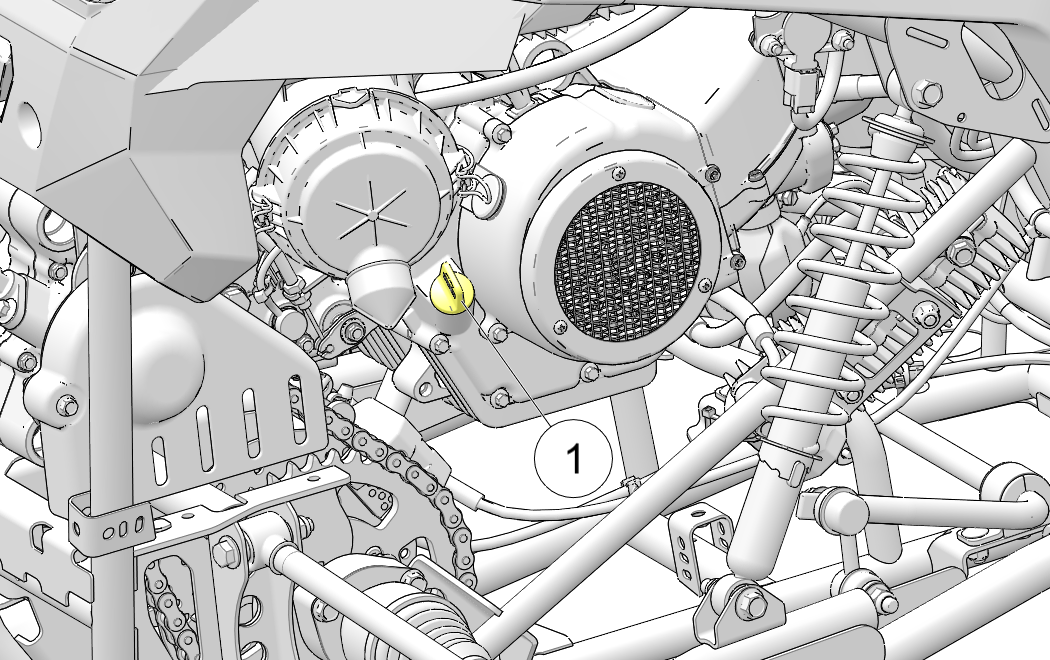
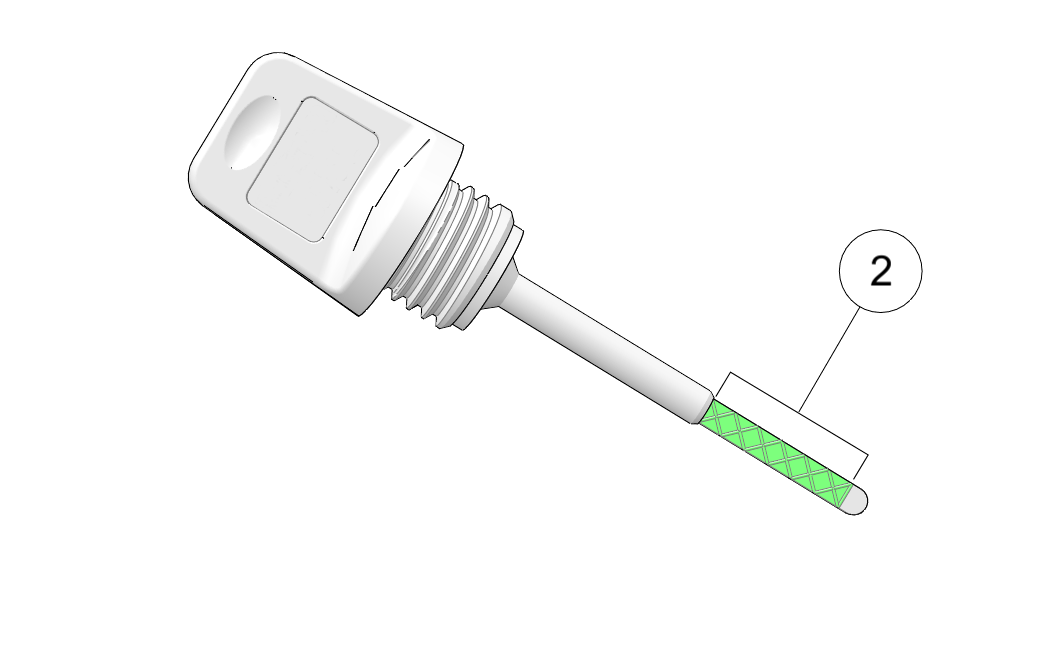
Position the vehicle on a level surface.
Remove the dipstick 1. Wipe it dry with a clean cloth.
Reinstall the dipstick completely.
Remove the dipstick and check if oil level is within safe range 2.
Add the recommended oil as needed.
Reinstall the dipstick.
Position the vehicle on a level surface. Set the parking brake.
Stop the engine.
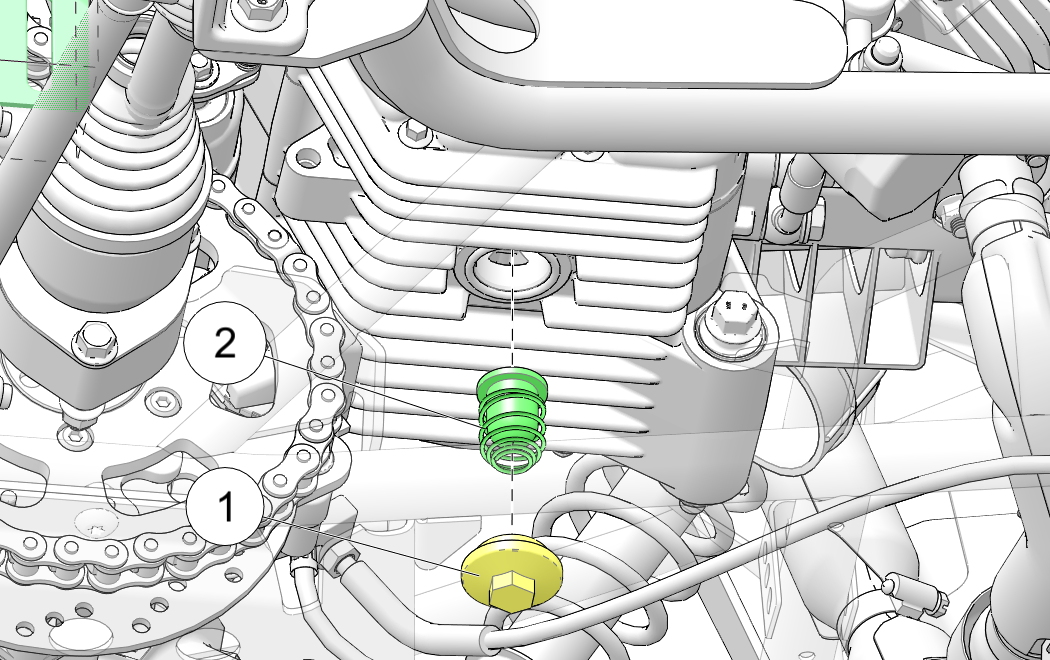
Clean the area around the drain plug 1.
Place a drain pan under the engine crankcase.
Remove the drain plug and pre-filter screen 2. Allow the oil to drain completely.
Wash the oil pre-filter screen with solvent to remove debris. Allow the screen to air dry.
The external oil filter and oil cooler 3 are mounted to the chassis under the engine. The oil filter is accessible on the right side of the vehicle. The spin-on oil filter should be replaced when oil is changed. With the oil drained from the crankcase, unscrew the oil filter and replace with a new one. Ensure that the oil filter gasket is properly seated, lubricated with oil and in good condition. Do not over tighten the oil filter.
External Oil Filter:
Turn by hand until filter O-ring contacts sealing surface, then turn an additional 3/4 turn.
Reassemble the pre-filter screen and spring to the pre-filter plug.
Reinstall the drain plug and tighten to specification.

Drain Plug:
10 ft-lbs (14 N·m)
Remove the dipstick. Add 35.5 floz (1050 ml) of the recommended oil. Do not overfill. See the specifications section for capacities.
Reinstall the dipstick.
Start the engine. Allow it to idle for 30 seconds.
Stop the engine and inspect for leaks.
Wait at least 15 seconds before removing the oil dipstick. Check the oil level.
Add oil as needed to bring the level to the upper mark on the dipstick.
Dispose of used oil properly.
Maximum transmission fluid volume cannot exceed 25 floz (750 ml). The fill / check method is fill to spill. Follow Fluid Change Procedure to verify transmission is filled with fluid
Always check and change the fluid at the intervals outlined in the Maintenance Schedule, see Overview. Polaris recommends the use of AGL Gearcase Lubricant and Transmission Fluid for this vehicle.
The fill plug 1 and sealing washer 2 can be accessed on the right side of the transmission gearcase.
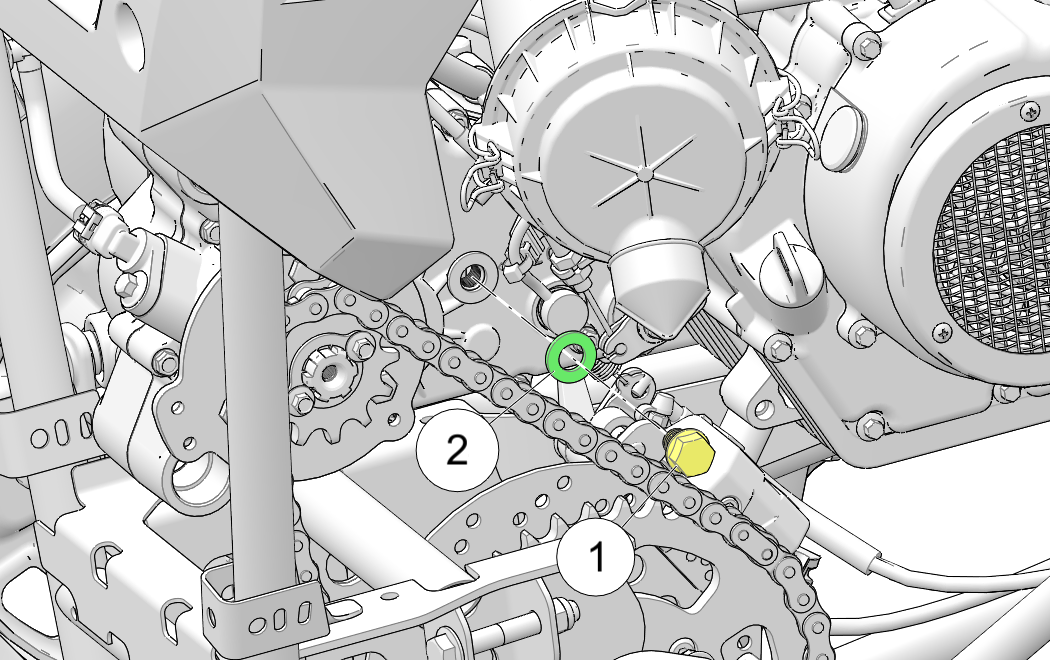
Maximum transmission fluid volume cannot exceed 25 floz (750 ml). The fill / check method is fill to spill. Follow Fluid Change Procedure to verify transmission is filled with fluid.
Always change the fluid at the intervals outlined in the Maintenance Schedule, see Overview. Polaris recommends the use of AGL Gearcase Lubricant and Transmission Fluid for this vehicle.
The fill plug 1 can be accessed
on the right side of the transmission gearcase. The drain plug 3 is located on the bottom of the transmission gearcase. Access
the drain plug from the bottom of the vehicle.
To change the transmission fluid, do the following:
Remove the fill plug 1 and sealing washer 2.
Place a drain pan under the transmission drain plug.
Remove drain plug 3 and sealing washer 4 from the bottom of the gearcase and allow lubricant to drain completely.
Clean the drain plug magnetic surface.

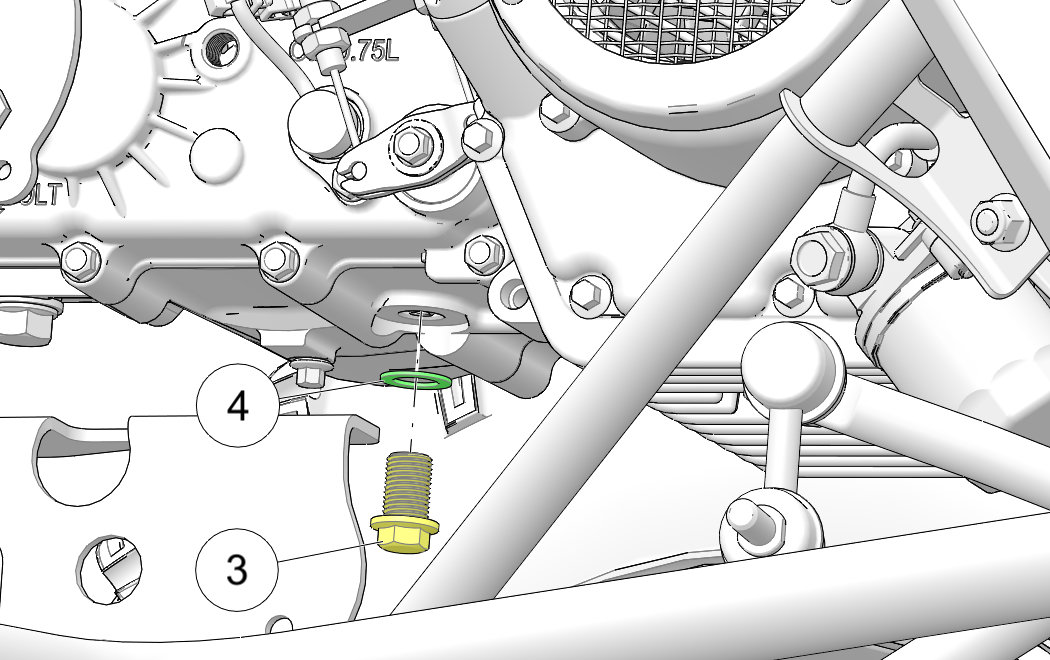
Reinstall the drain plug and sealing washer. Torque to specification.
Transmission Drain Plug:
18 ft-lbs (25 N·m)
Add the recommended amount of lubricant or fill-to-spill through the fill plug hole.
Transmission Lubricant Capacity:
25 oz (750 ml)
Reinstall the fill plug and washer. Torque to specification.
Transmission Fill Plug:
18 ft-lbs (25 N·m)
Check for leaks. Dispose of used lubricant properly.
Lubricate the drive chain with Polaris chain spray lube or an approved chain lube at the interval specified in the Maintenance Schedule, see Overview. Lubricate more often under severe use, such as in dirty or wet conditions.
Washing the drive chain with a high pressure washer or solvents can cause premature wear and chain failure. Do not use a high pressure washer or gasoline to clean the drive chain. Operating the vehicle with improper rear drive chain deflection can result in severe damage to the transmission and drive components. Always make sure the chain adjusted within the stated specifications.
Remove cap from rear of the cargo area.
Loosen upper nut 1 on the chain tensioner bracket.
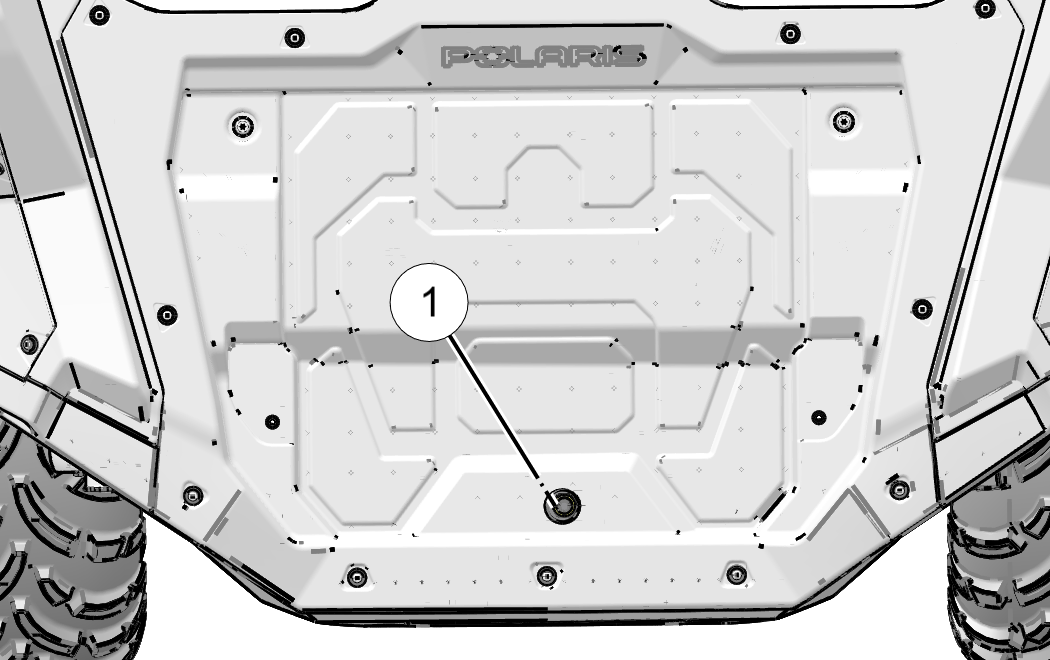
Turn lower nuts 2 clockwise in 1/2 turn increments, then turn upper nut until tight. Follow this procedure until chain is at proper tension. To check for proper tension, press the down on the middle of the chain with thumb using 22 lbs (100N) of force. Chain deflection 3 should be within specification.
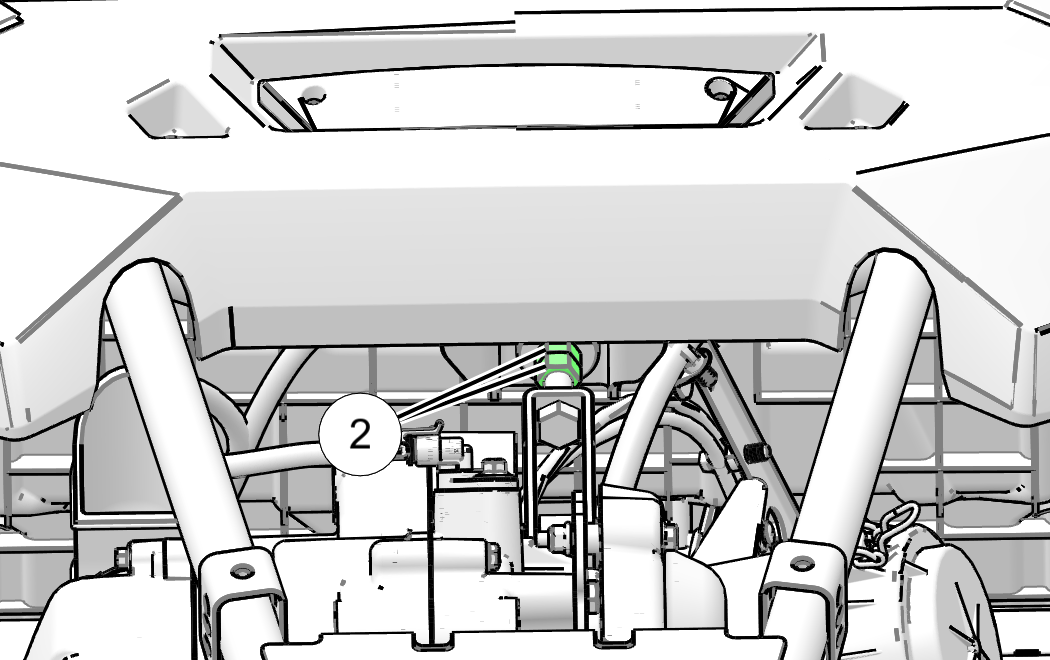
Repeat these steps until chain is adjusted to desired deflection.
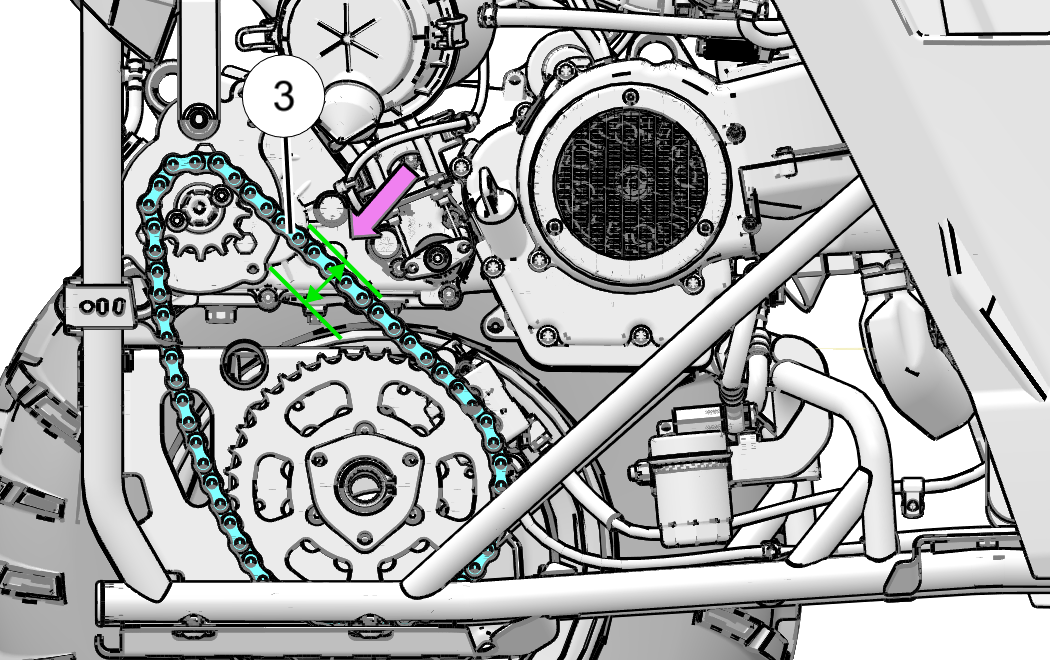
Chain Deflection:
Using 22 lbs (100N) of force
New Chain: 3/16 - 13/32” (5 - 10 mm)
Broken In Chain: 13/32 - 19/32” (10 - 15 mm)
A new chain will stretch after the vehicle is used for a period of time.
Inspect and perform any needed service on the brake pads before adjusting parking brake cable freeplay.
Make sure the parking brake is NOT set (the lever should be in the DOWN position).
Pull the brake cable back to inspect freeplay between the cable end and the caliper bracket. Freeplay should be 1/16" - 1/8" (1.5-3 mm).
To adjust freeplay, loosen the jam nut. Turn the in-line adjuster nut outward to decrease freeplay. Turn the adjuster nut inward to increase freeplay.
Tighten the jam nut against the adjuster nut.
Inspect and perform any needed service on the brake pads before adjusting the parking brake.
Position the vehicle on a level surface. Place the transmission in neutral.
Carefully elevate the rear of the vehicle slightly. Use an appropriate lift.

Loosen the jam nut 1 on the parking brake cable sleeve.
While rotating the rear wheels by hand, turn the adjustment nut 2 counterclockwise until significant brake drag is detected. Then turn the adjustment nut in 1/4 turn.
Hold the parking brake cable sleeve and adjustment nut in place and tighten the jam nut securely against the lever arm.
Check parking brake lever movement. Verify that the rear wheels rotate freely with the parking brake off (lever in DOWN position) and that the vehicle will not move when the parking brake is applied (lever in UP position).
Verify that the park brake lever stays in the UP position when the brake is fully applied.

Remove the spark plug cap 1.
Using the spark plug wrench provided in the tool kit, remove the plug by rotating it counter-clockwise.
Reverse the procedure for spark plug installation. Torque to specification.
| Electrode Gap | New Plug Torque | Used Plug Torque |
|
(0.6-0.7 mm) |
11 ft-lbs (15 N·m) |
18 ft-lbs (24 N·m) |
Normal Plug
The normal insulator tip is gray, tan or light brown. There
will be few combustion deposits. The electrodes are not burned or
eroded. This indicates the proper type and heat range for the engine
and the service.
Failure to comply with the instructions in this warning can result in severe injury or death.
Do not modify any component of the CVT system. Doing so may reduce its strength so that a failure may occur at a high speed. The CVT system has been precision balanced. Any modification will cause the system to be out of balance, creating vibration and additional loads on components.
Always follow all recommended maintenance procedures. See your POLARIS dealer, or other qualified person, for service and repair assistance.
This CVT system is intended for use on POLARIS products only. Do not install it in any other product.
Always make sure the CVT housing is securely in place during operation.
After operating in water, the vehicle’s CVT system should be checked immediately. Use the following instructions to dry it out before operating.
Shift the transmission to neutral. Set the parking brake.
Start the engine. Apply varying throttle for 10-15 seconds to expel the moisture and air-dry the belt and clutches.
Do not hold the throttle pedal wide open for more than 5 seconds.
Allow the engine RPM to return to idle, then shift the transmission into gear.
Test the CVT system for belt slippage. If the belt slips, repeat the process or remove the outer clutch cover to inspect the CVT system.
If the vehicle has ingested a large amount of water into the CVT system and has not been operated for a period of time, be sure to check the CVT system components for water damage.
Inspect the air filter at the intervals outlined in the Maintenance Schedule, see Overview. In extremely dusty conditions, air filter replacement will be required more often. Access the air box near the right rear wheel.
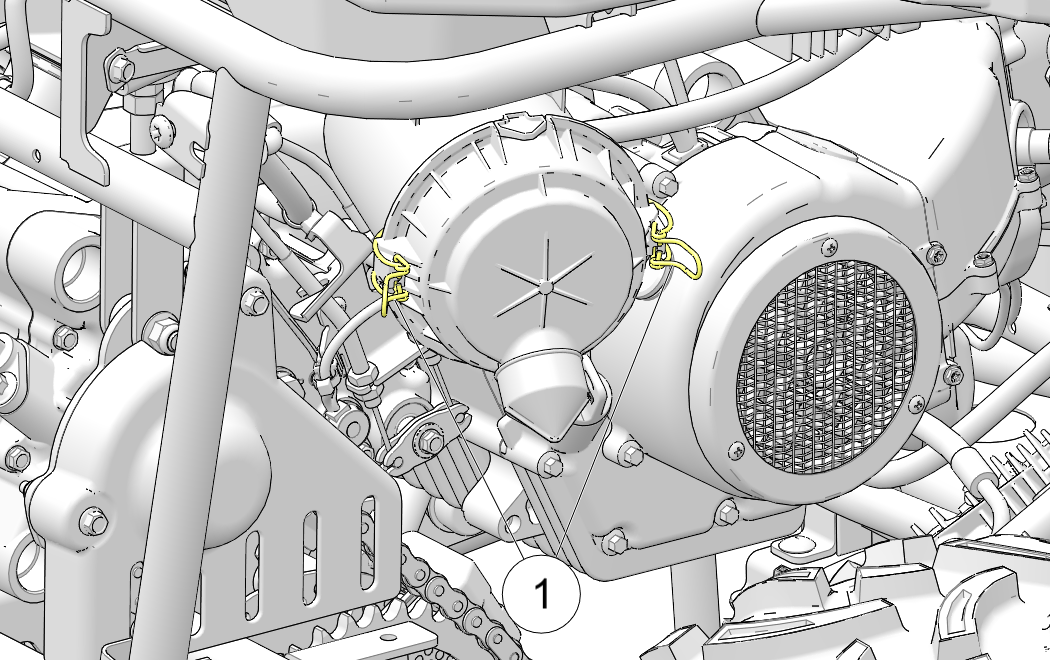
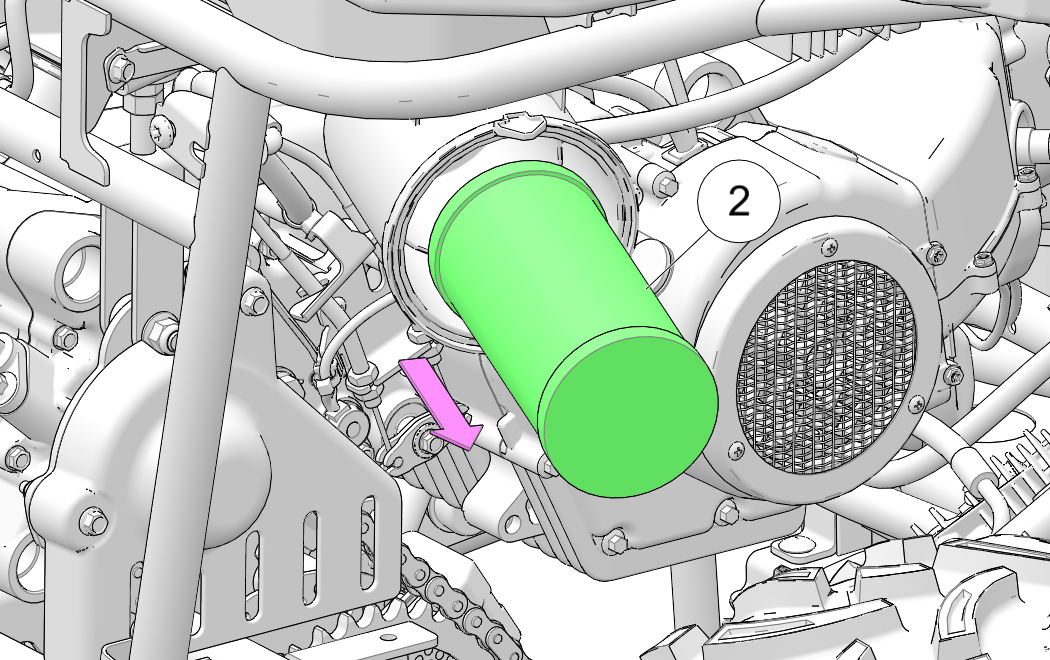
Disengage the two cover latches 1.
Unlatch the cover and carefully remove it from the air box.
Remove the filter 2.
Inspect the air box for oil or water deposits. Wipe away any deposits with a clean shop towel.
If the filter has been soaked with fuel or oil it must be replaced.
Inspect the air filter and replace if necessary.
DO NOT attempt to clean the air filter with compressed air .
Place the air filter into the air box and reinstall the air box cover.
Make sure the tabs are properly positioned into the hinge. Ensure the O-ring is installed inside the lid properly.
Engage the cover latches.
Failure to heed the following warnings while servicing the spark arrestor could result in serious injury or death.
Do not perform service on the spark arrestor while the system is hot. Allow components to cool sufficiently before proceeding.
Wear eye protection and gloves.
Never operate without the spark arrestor.
Never run the engine in an enclosed area. Exhaust contains poisonous carbon monoxide gas.
To remove accumulated carbon, clean the spark arrestor at the intervals recommended in the Maintenance Schedule beginning on Overview.
Remove the 3 fasteners 1 and remove the arrestor 2 from the end of the muffler.
Use a non-synthetic brush to clean the arrestor screen. A synthetic brush may melt if components are warm. If necessary, blow debris from the screen with compressed air.
Inspect the screen for wear and damage. Replace the arrestor if damage is found.
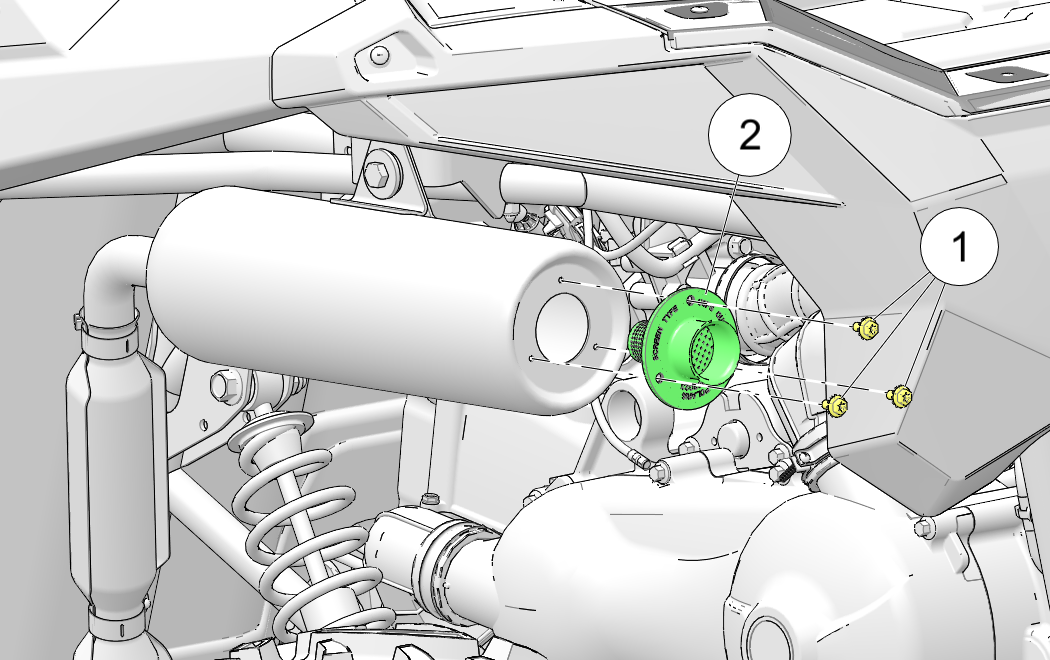
Reinstall the arrestor.
Torque the fasteners to specification.
Spark Arrestor Fasteners:
35 in-lbs (4 N·m)
Remove fuse box cover 1.
Remove the suspect fuse from the fuse panel. If the fuse is blown, install a new fuse with the same amperage.
Secure the fuse box cover.
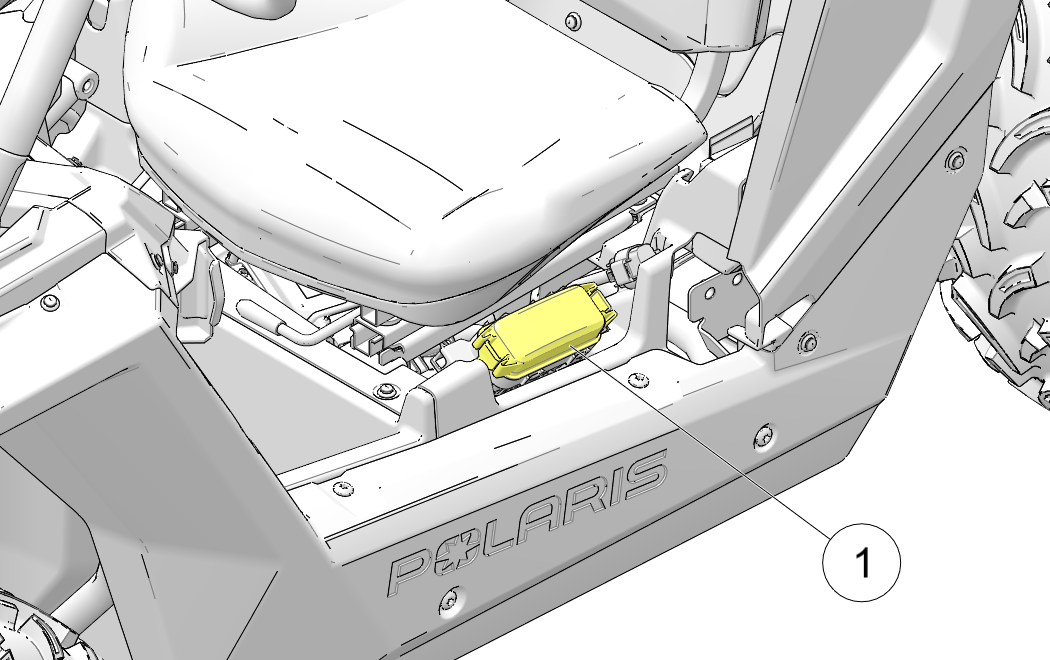
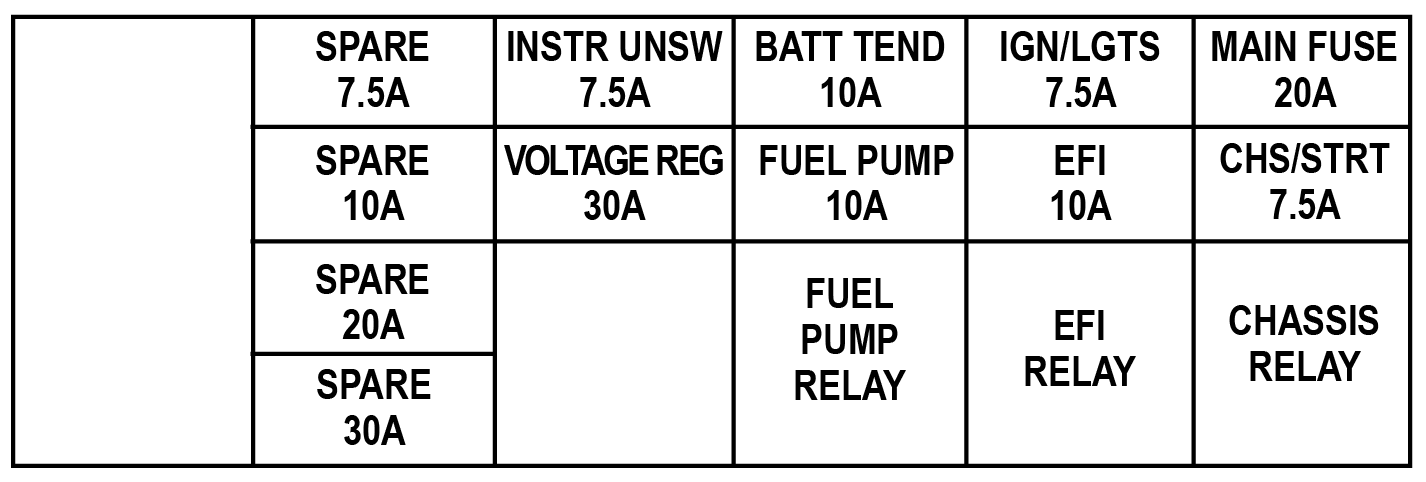
The front and rear brakes are hydraulic disc type brakes activated by the brake pedal.
Always check brake pedal travel and the brake fluid reservoir level before each use of the vehicle. When applied, the brake pedal should feel firm. Any sponginess would indicate a possible fluid leak or low brake fluid level, which must be corrected before riding.
If you discover any irregularities in brake system operation, including excessive pedal travel, contact your dealer for proper diagnosis and repairs.
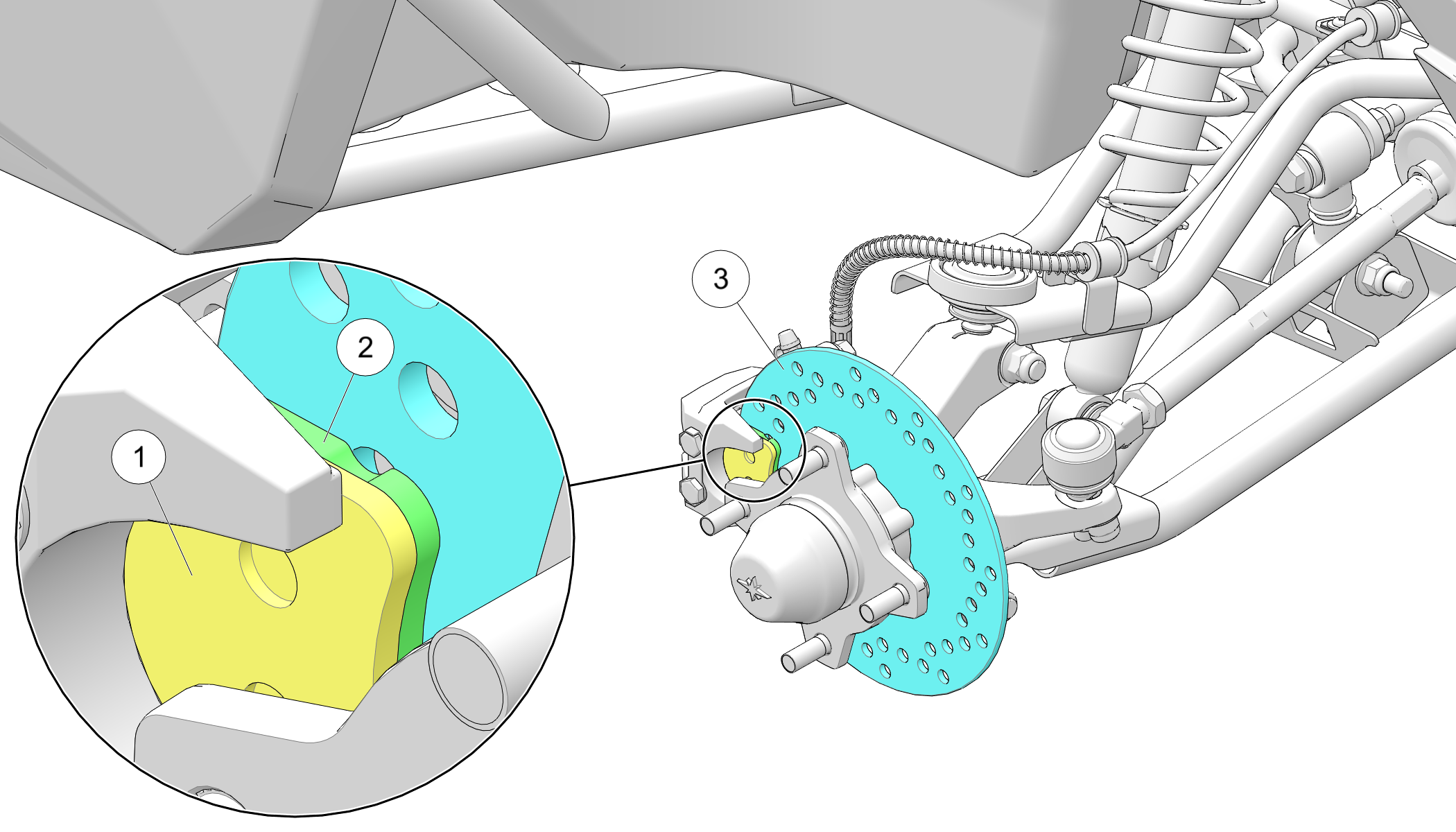
Check the brake system for fluid leaks.
Check the brake pedal for excessive travel or a spongy feel.
Check the brake pads 1 for wear, damage and looseness.
Inspect the brake pad wear surface for excessive wear.
Change pads when the friction material 2 is worn to .04" (1 mm) .
Check the surface condition of the brake discs 3. Measure the thickness. Replace a disc if the thickness is less than .170” (4.32 mm).
Check brake system hoses and fittings for cracks, deterioration, abrasion and leaks. Tighten any loose fittings and replace any worn or damaged parts.
Inspect the level of the brake fluid before each operation. If the fluid level is low add DOT 4 brake fluid only. See Engine Lubricant for the part numbers of POLARIS products.
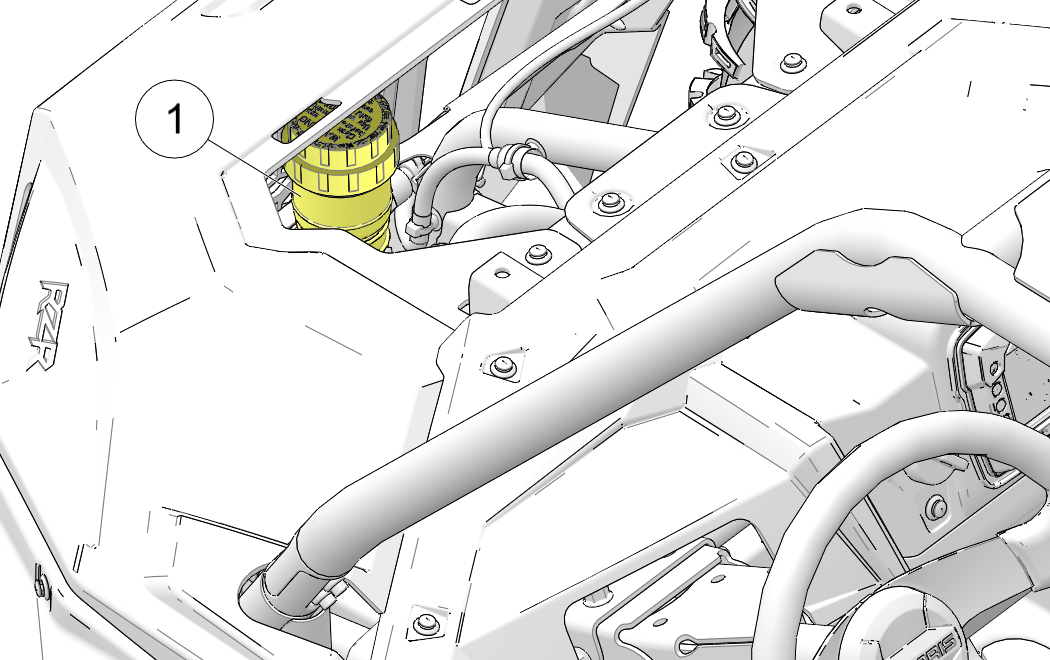
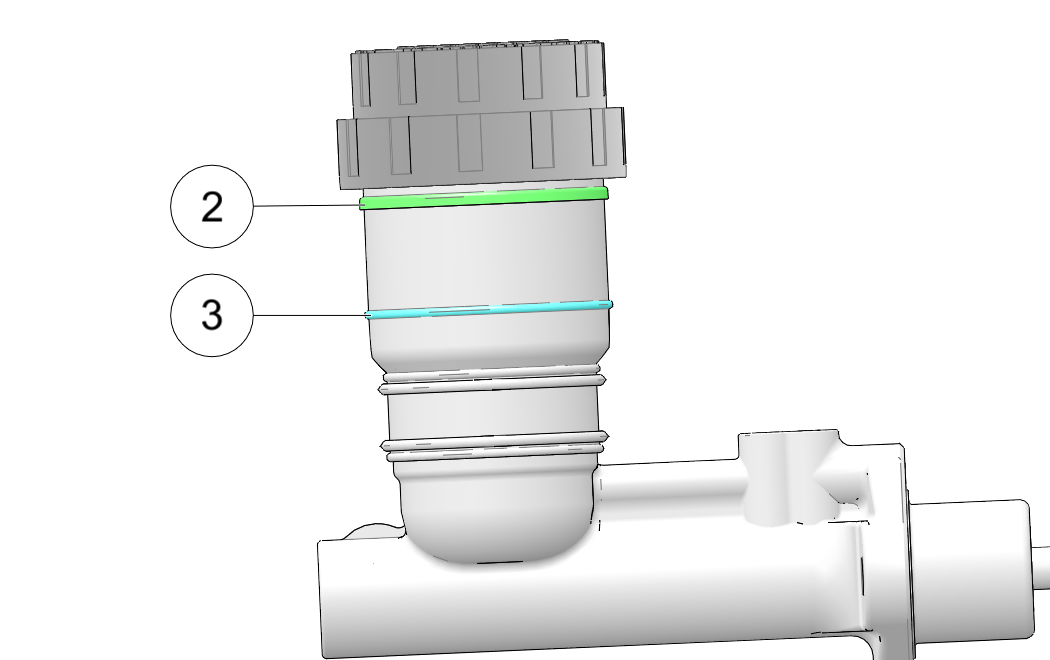
The brake fluid reservoir 1 is located under the hood at the front of the vehicle.
Change the brake fluid every two years and any time the fluid becomes contaminated, the fluid level is below the minimum, or if the type and brand of the fluid in the reservoir are unknown. Access the brake fluid reservoir through the left front wheel well.
Position the vehicle on a level surface.
Place the transmission in neutral. Set the parking brake.
View the brake fluid level in the reservoir. The level should be between the maximum 2 and minimum 3 level lines. Add brake fluid as needed.
Apply the brake forcefully for a few seconds and check for fluid leakage around the fittings.
Check the steering wheel for specified freeplay and smooth operation at the intervals outlined in the Maintenance Schedule, see Overview.
Position the vehicle on level ground.
Lightly turn the steering wheel left and right.
There should be 0.8"-1.0" (20-25 mm) of freeplay.
If there is excessive freeplay or strange noises, or the steering feels rough or "catchy," have the steering system inspected by an authorized Polaris dealer or other qualified service facility before operating the vehicle.
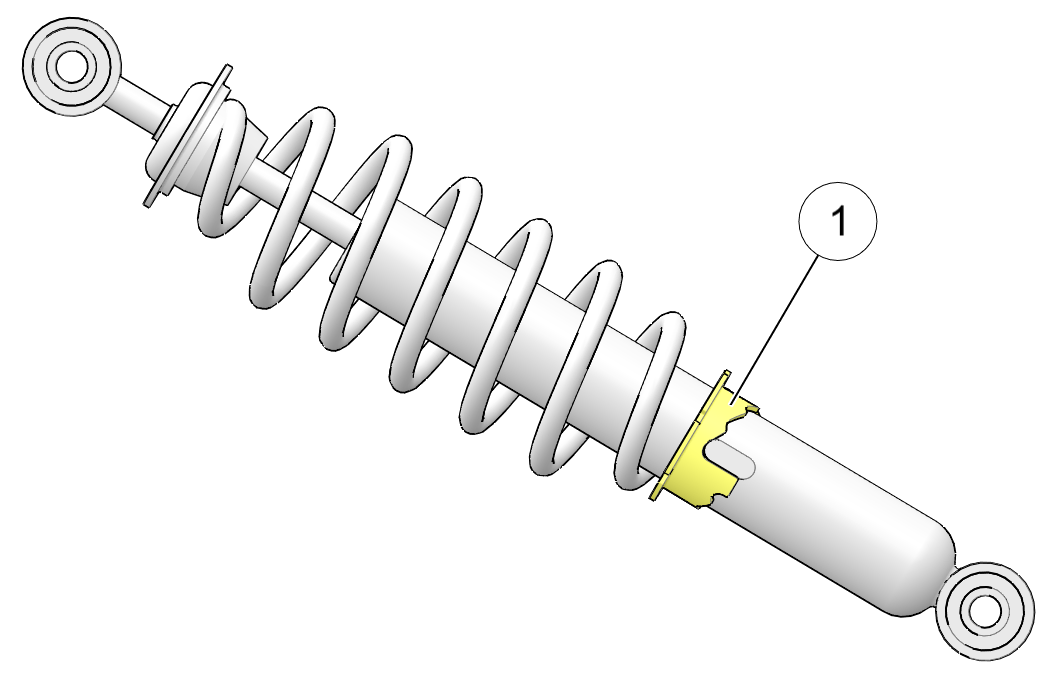
The front and rear shock absorber springs are adjustable to increase
or decrease spring tension. Rotate the adjuster 1 either
clockwise or counter-clockwise to make adjustments.
Always apply the same adjustment setting to all
four wheels.
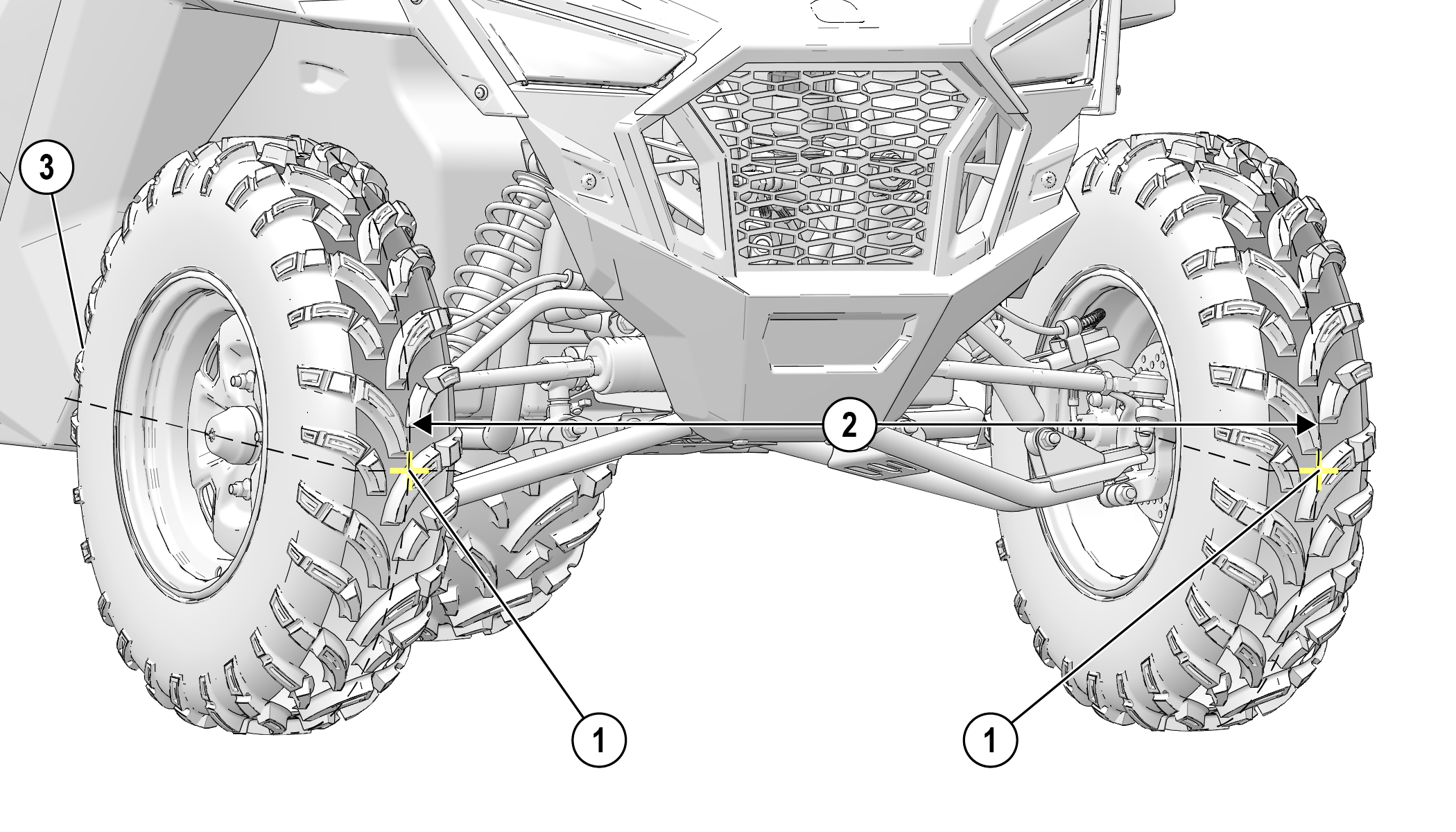
Place machine on a smooth level surface and set steering wheel in a straight ahead position. Secure the steering wheel in this position.
Place a chalk mark on the center line of the front tires approximately 10″ (25.4 cm) from the floor or as close to the hub/axle center line as possible 1.
It is important the height of both marks be equally positioned to get an accurate measurement.
Measure the distance between the marks and record the measurement. Call this measurement “2”.
Rotate the tires 180° by moving the vehicle forward. The chalk marks are now facing rearward, even with the hub/axle center line.
Again measure the distance between the marks and record. Call this measurement “3”. Subtract measurement “3” from measurement “2”. The difference between measurements “2” and “3” is the vehicle toe alignment. The recommended vehicle toe tolerance is 0 to 1/8” (0 to 3.2 mm) toe out. This means the measurement at the front of the tire 2 is 0 to 1/8” (0 to 3.2 mm) wider than the measurement at the rear 3.
Wheel Toe-Out:
0 to 1/8" (0 to 3.2 mm)
If toe alignment is incorrect, repeat steps 3-5 of “Wheel Toe Alignment Inspection”, but instead measure the distance between each wheel and the vehicle center. This will tell you which tie rod needs adjusting.
Be sure steering wheel is straight ahead before determining which tie rod needs adjustment.
During tie rod adjustment, it is very important that the following precautions be taken when tightening tie rod end jam nuts.
If the rod end is positioned incorrectly it will not pivot, and may break.
Hold tie rod end to keep it from rotating.
Loosen jam nuts at both end of the tie rod.
Shorten or lengthen the tie rod until alignment is as required to achieve the proper toe setting as specified in above.
When tightening the tie rod end jam nuts, the rod ends must be held parallel to prevent rod end damage and premature wear. Damage may not be immediately apparent if done incorrectly.
After alignment is complete, torque jam nuts to specification.
Tie Rod Jam Nut:
13 ft-lbs (18 N·m)
If it’s impossible to take your vehicle to a dealer before starting it, follow the steps outlined below.
Move the vehicle to dry land.
Check the air box. If water is present, dry the air box and replace the filter with a new filter. Thoroughly dry the air pre-filter..
Remove the air box drain plug to drain any water. Reinstall the drain plug securely.
Remove the spark plug.
Turn the engine over several times using the electric start.
Dry the spark plug and reinstall it, or install a new plug.
Attempt to start the engine. If necessary, repeat the drying procedure.
Take the vehicle in for service as soon as possible, whether you succeed in starting it or not. Your POLARIS dealer can provide the required service.
If water has been ingested into the transmission follow the procedure in the Constant Variable Transmission (CVT) System section for details on drying.
Operating your vehicle with worn tires will increase the possibility of skidding, loss of control and an accident, which could result in serious injury or death. Always replace tires when the tread depth measures 1/8 in (3 mm) or less.
Improper tire inflation or the use of non-standard size or type of tires may adversely affect vehicle handling, which could result in vehicle damage or personal injury. Always maintain proper tire pressure. Always use POLARIS approved size and type of tires for this vehicle when replacing tires.
Always replace tires when tread depth is worn to 3 mm (1/8”) or less.

Position the vehicle on a level surface.
Apply the parking brake and stop the engine.
Loosen the wheel nuts slightly. If wheel hub removal is required, remove the hub cap, cotter pin and loosen the hub nut slightly.
Elevate the appropriate side of the vehicle by placing a suitable stand under the frame.
Remove the wheel nuts 1 and remove the wheel.
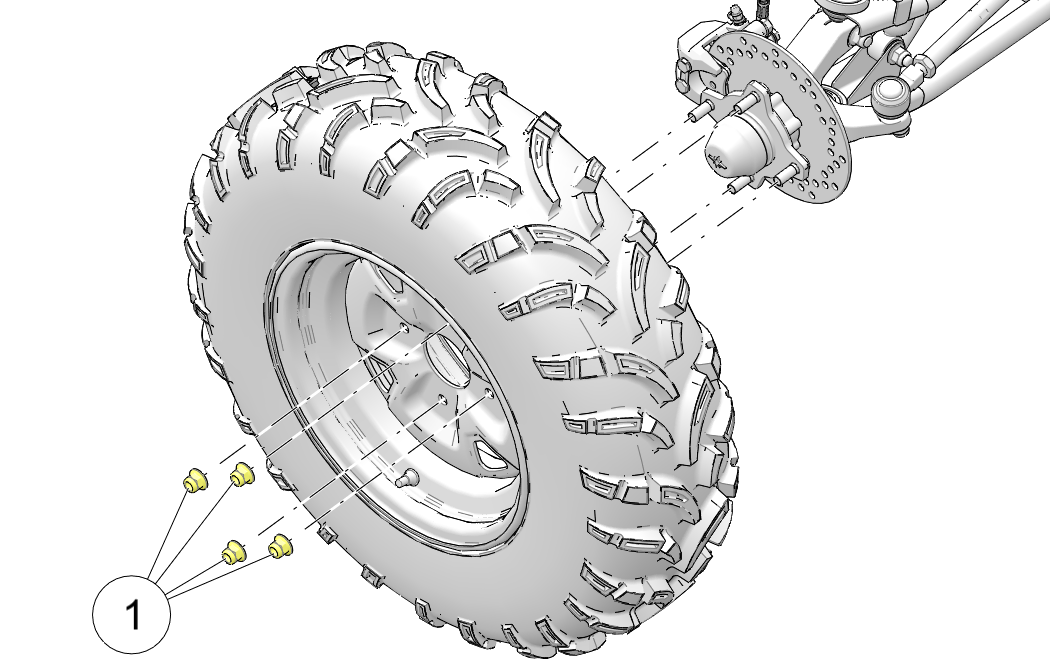
Improperly installed wheels can adversely affect tire wear and vehicle handling, which can result in serious injury or death. Always ensure that all nuts are torqued to specification. Do not service axle nuts that have a cotter pin installed. Your dealer can assist.
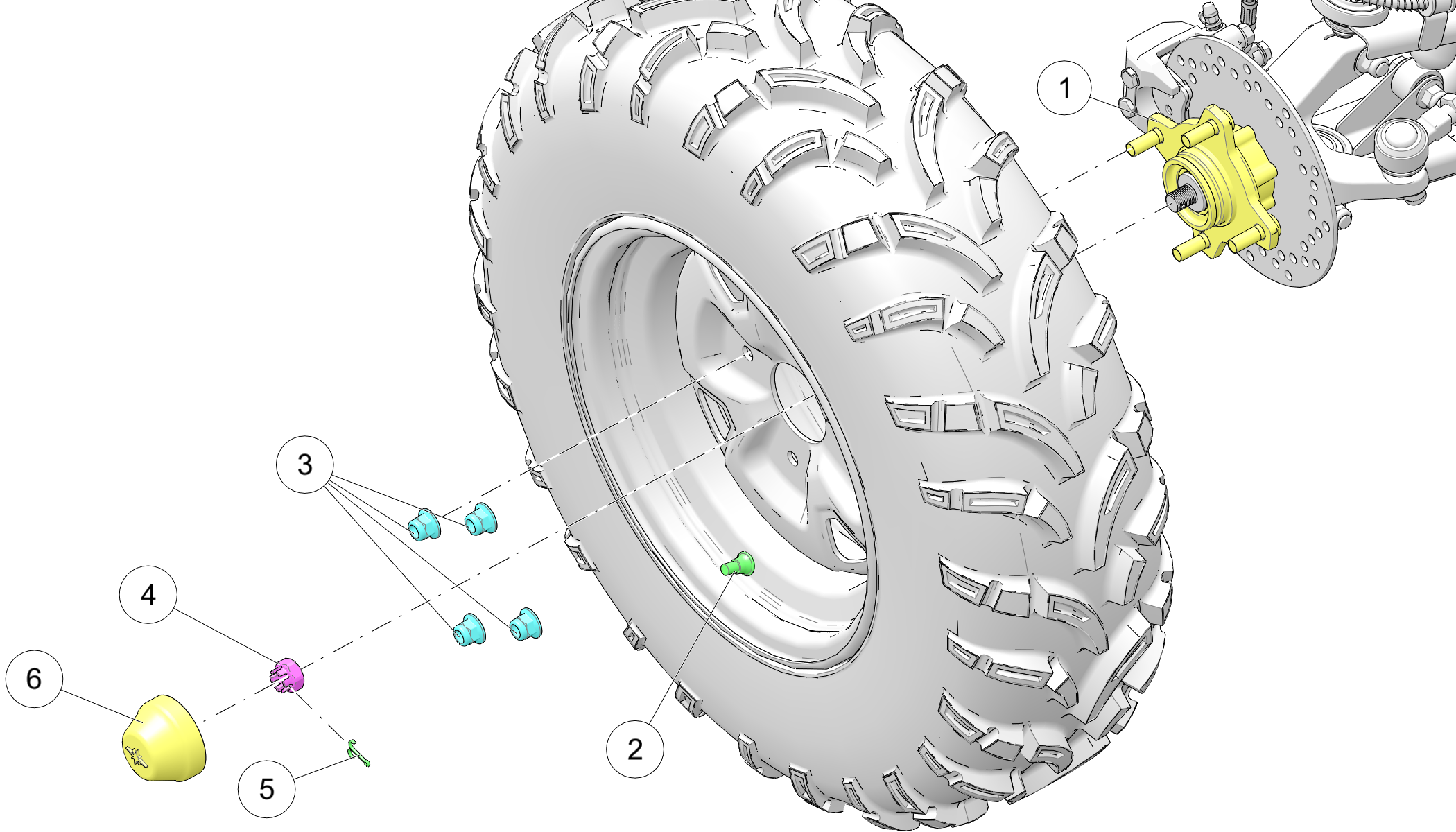
Verify the parking brake is still applied.
Place the wheel in the correct position on the wheel hub 1. Be sure the valve stem 2 is toward the outside and rotation arrows on the tire point toward forward rotation.
Install the wheel nuts 3 and finger tighten.
Carefully lower the vehicle to the ground.
Torque the wheel nuts and the hub nut 4, if removed, to the proper torque specification.
Wheel Nuts:
30 ft-lbs (41 N·m)
Hub Castle Nuts:
Front: 60 ft-lbs (80 N·m)
Rear: 80 ft-lbs (109 N·m)
If hub nut was removed, install a new cotter pin 5 after the hub nut has been tightened. If the holes do not line up, turn the hub nut until the cotter pin can be installed.
Install the hub cap 6.
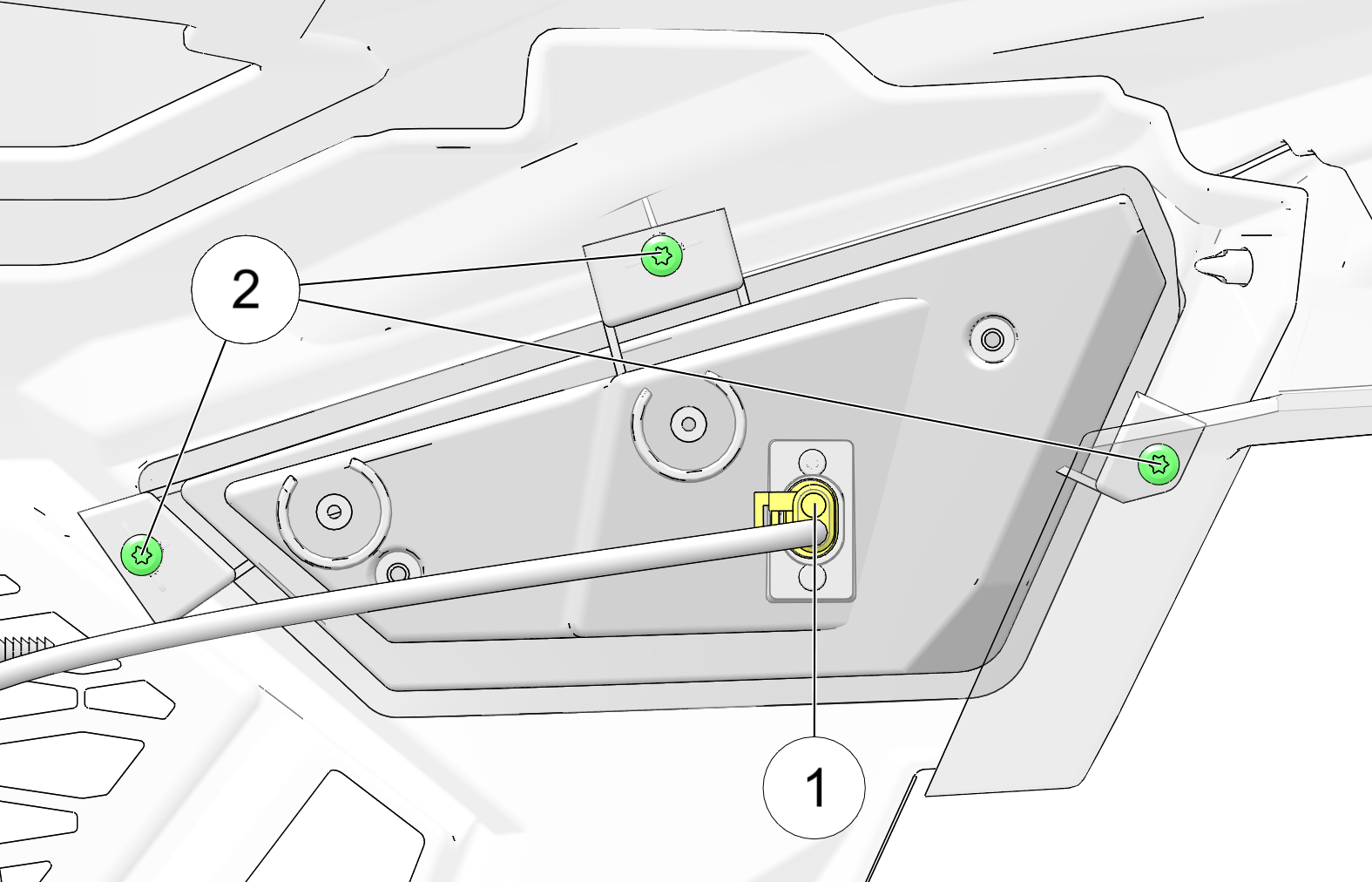
To remove the headlight, do the following:
Disconnect the headlight to harness connection 1.
Remove the three fasteners 2 retaining the headlight.
Remove the headlight from the inside of the front bumper.
Battery electrolyte is poisonous. It contains sulfuric acid. Serious burns can result from contact with skin, eyes or clothing.
Antidote:
External: Flush with water.
Internal: Drink large quantities of water or milk. Follow with milk of magnesia, beaten egg, or vegetable oil. Call physician immediately.
Eyes: Flush with water for 15 minutes and get prompt medical attention.
Batteries produce explosive gases. Keep sparks, flame, cigarettes, etc. away. Ventilate when charging or using in an enclosed space. Always shield eyes when working near batteries. KEEP OUT OF REACH OF CHILDREN.
Your vehicle uses a sealed battery, which requires little maintenance. A sealed battery can be identified by its flat covers on the top of the battery.
Always keep battery terminals and connections free of corrosion. If cleaning is necessary, remove the corrosion with a stiff wire brush. Wash with a solution of one tablespoon baking soda and one cup water. Rinse well with tap water and dry off with clean shop towels. Coat the terminals with dielectric grease or petroleum jelly. Never pry the sealing strip off or add any other fluid to a sealed battery.
Improperly connecting or disconnecting battery cables can result in an explosion and cause serious injury or death. When removing the battery, always disconnect the negative (black) cable first. When reinstalling the battery, always connect the negative (black) cable last.
Access the battery 1 by sliding the driver’s seat ahead. See Driver’s Seat Adjustment.
Disconnect the black (negative) battery cable first.
Disconnect the red (positive) battery cable last.
Lift the battery out of the vehicle.
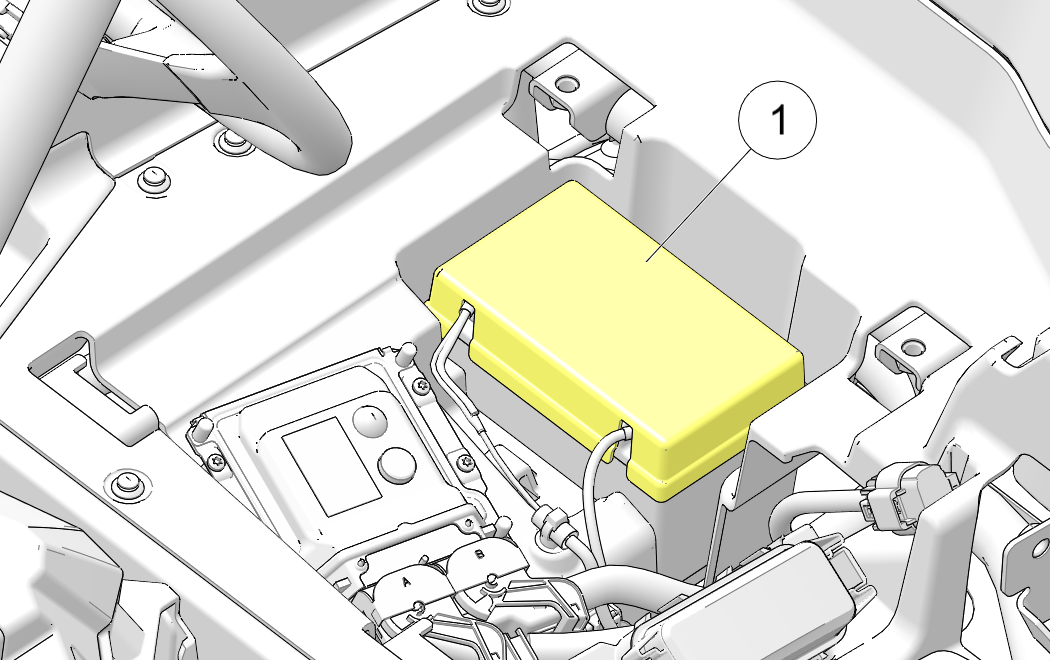
Using a new battery that has not been fully charged can damage the battery and result in a shorter life. It can also hinder vehicle performance. Follow the steps in the Battery Charging section before installing the battery.
Ensure that the battery is fully charged.
Place the battery in the battery holder.
Coat the terminals with dielectric grease or petroleum jelly.
Connect and tighten the red (positive) cable first.
Connect and tighten the black (negative) cable last.
Verify that cables are properly routed.
Sealed batteries are already filled with electrolyte and have been sealed and fully charged at the factory.
Never pry the sealing strip off or add any other fluid to a sealed battery.
For a refresh charge, follow all instructions carefully.
Check the battery voltage with a voltmeter or multimeter. A fully charged battery will register 12.8 V or higher.
If the voltage is less than 12.8 volts, recharge the battery at 1.2 amps or less until battery voltage is 12.8 or greater.
If the voltage falls below 12.5V, charge it immediately, or the battery runs the risk of sulfation and reduced battery life.
The single most important thing about maintaining a sealed battery is to keep it fully charged.
If you do not drive the vehicle for more than TWO WEEKS, Polaris recommends using a BatteryMINDer® 1510 - 1.5 AMP charger (PN 2830404), which can be ordered through your dealer. During charging, place the charger outside of the vehicle and protect it from moisture. The battery charge port 1 is located on the dash.
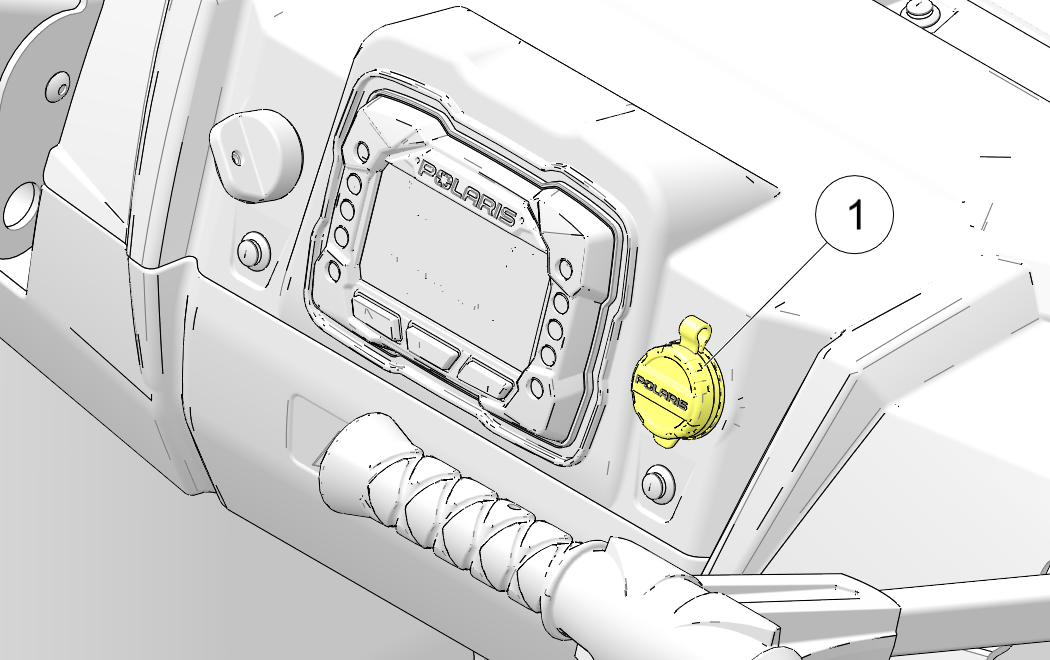
If you plan to store the vehicle for ONE MONTH or longer, remove the battery from the vehicle, then store the battery in a cool and dry location. Continue to maintain the battery with the BatteryMINDer® 1510 - 1.5 AMP charger.
When using an automatic charger other than a BatteryMINDer® 1510 - 1.5 AMP charger, refer to the charger manufacturer's instructions for recharging.
If using a constant current charger (instead of BatteryMINDer® 1510 - 1.5 AMP charger), use the guidelines below. Always verify battery condition before and 1-2 hours after the end of charging.
| State of Charge | Voltage (DC) | Action | Charge Time* |
| 100% | 12.8-13.0 volts | None, check monthly | None required |
| 75%-100% | 12.6-12.8 volts | May need slight charge, if no charge given, check in 2 weeks | 3-6 hours |
| 50%-75% | 12.3-12.6 volts | Needs charge | 5-11 hours |
| 25%-50% | 12.0-12.3 volts | Needs charge | At least 13 hours |
| 0%-25% | 12.0 volts or less | Needs charge | At least 20 hours |
|
* Using AGM specific charger at standard amps specified on top of battery |
|||
Keeping your POLARIS vehicle clean will not only improve its appearance but it can also extend the life of various components.
Certain products, including insect repellents and chemicals, will damage plastic surfaces. Do not allow these types of products to contact the vehicle.
The best way to clean your POLARIS vehicle is with a garden hose and a pail of mild soap and water.
Use a professional-type washing cloth, cleaning the upper body first and the lower parts last.
Rinse with clean water frequently.
Dry surfaces with a chamois to prevent water spots.
Avoid the use of harsh cleaners, which can damage the finish.
Do not use medium to heavy duty compounds on the finish.
Always use clean cloths and pads for cleaning and polishing. Old or reused cloths and pads may contain dirt particles that will scratch the finish.
Do not use high-speed polishers/buffers on body panels, as damage or color fading may occur.
If warning and safety labels are damaged, contact your POLARIS dealer for free replacement.
Grease all zerk fittings immediately after washing. Allow the engine to run for a while to evaporate any water that may have entered the engine or exhaust system.
If a high pressure water system is used for cleaning, exercise extreme caution. The maximum pressure should not exceed 3000 PSI, 2.5 GPM with a 40° pressure washer nozzle. Make sure to keep the pressure washer nozzle 2 ft from the vehicle away from the surface being cleaned. The water may damage components and could remove paint and labels. High water pressure may damage radiator fins and impair a radiator’s effectiveness. High pressure may also damage other vehicle components. Avoid directing the water stream at the following items:
Wheel bearings
Radiator
Transmission seals
Brakes
Cab and body panels
Labels and decals
Electrical components and wiring
Air intake components
Throttle and shift cables and controls
Seat Belts
Seats
Do not use bleach, dye or household detergents.
Never use lubricant on any seat belt component.
Do not use a pressure washer to clean the seat belts.
POLARIS recommends the use of common household aerosol furniture polish for polishing the finish on your POLARIS vehicle. Follow the instructions on the container.
Avoid the use of automotive products, some of which can scratch the finish of your vehicle.
Always use clean cloths and pads for cleaning and polishing. Old or reused cloths and pads may contain dirt particles that will scratch the finish.
Avoid the use of products containing a colorant dye. Test any products on an inconspicuous area of the vehicle before using throughout.
Make any necessary repairs and clean the vehicle as recommended. See the Washing the Vehicle section for details.
Fill the fuel tank.
Add POLARIS Carbon Clean Fuel Treatment or POLARIS Fuel Stabilizer or equivalent fuel treatments or stabilizers. Follow the instructions on the container for the recommended amount. Carbon Clean removes water from fuel systems, stabilizes fuel and removes carbon deposits from pistons, rings, valves and exhaust systems.
Allow the engine to run for 15-20 minutes to allow the stabilizer to disperse through the entire fuel delivery system.
Change the oil and filter. See the Oil and Filter Change section for details.
Replace the air filter. See the Air Filter section for details. Clean the air box.
Inspect the fluid levels. Add or change fluids as recommended in the Periodic Maintenance Chart section.
Demand drive fluid (front gearcase)
Rear gearcase fluid (if equipped)
Transmission fluid
Brake fluid (change every two years and any time the fluid looks dark or contaminated)
Coolant (test strength/fill)
Inspect all cables and lubricate all areas of the vehicle as recommended in the Periodic Maintenance Chart section.
Treat the fuel system with POLARIS Carbon Clean or other equivalent fuel treatment. Follow the instructions on the container. Start the engine. Allow it to idle for several minutes so the Carbon Clean reaches the injectors. Stop the engine.
Remove the spark plugs and add 2-3 tablespoons of engine oil. To access the plug holes, use a section of clear 1/4” hose and a small plastic squeeze bottle filled with the pre-measured amount of oil. Do this carefully! If you miss the plug holes, oil will drain from the spark plug cavities into the hole at the front of the cylinder head, and appear to be an oil leak.
Reinstall the spark plugs. Torque to specification. See the Spark Plug Gap / Torque section for details.
Apply dielectric grease to the inside of each spark plug cap. Do not reinstall the caps onto the plugs at this step.
Turn the engine over several times. Oil will be forced in and around the piston rings and ring lands, coating the cylinder with a protective film of fresh oil.
If POLARIS fuel system additive is not used, fuel tank, fuel lines, and injectors should be completely drained of gasoline.
Reinstall the spark plug caps to the spark plugs.
See Battery section for storage and charging procedures.
Remove the fuse box cover during storage.
Be sure the storage area is well ventilated. Cover the vehicle with a genuine POLARIS cover. Do not use plastic or coated materials. They do not allow enough ventilation to prevent condensation, and may promote corrosion and oxidation.
Charge the battery if necessary.
Make sure the spark plug is tight. Reinstall the fuse box cover if it was removed for storage.
Fill the fuel tank with fuel.
Check all the points listed in the Daily Pre-Ride Inspection section. Tightness of the bolts, nuts and other fasteners should be checked by an authorized POLARIS dealer or other qualified service facility.
Lubricate at the intervals outlined in the Periodic Maintenance Chart section.
The weight distribution of the cargo loaded onto the trailer is important and will have an impact on how the vehicle handles on the road. Ensure the weight of the cargo is distributed properly and the trailer is not rear, front, or side heavy.
Always use a spotter if you are uncomfortable loading the vehicle on your own. A wheel chock or marker can also be used as an indication of how close you will park the vehicle from the front of the trailer.
When loading or unloading a vehicle onto a trailer, always wear the appropriate safety gear, including an approved helmet.
Always secure cargo properly. Improperly securing a load can result in severe injury or death.
Securing devices, such as tie-down straps, are manufactured to support a load that can be applied during normal service. This is known as the Working Load Limit (WLL).
| Vehicle Type | Tie-Down Minimum WLL |
|---|---|
| All Vehicles | 3,300 lb (1497 kg) |
Cargo and other loose vehicle parts may fly off while transporting this vehicle. Secure or remove all cargo, and inspect the unit for loose parts prior to transport.
If transporting the vehicle in a non-enclosed trailer, then the vehicle must FACE FORWARD, or roof, if equipped, must be removed.
Failure to comply may allow airflow, vibration, or other factors to separate the roof from the vehicle and cause an accident, resulting in serious personal injury or death.
Follow these procedures when transporting the vehicle.
Properly load the vehicle onto the trailer or towing vehicle.
If transporting the vehicle in a non-enclosed trailer, the vehicle must FACE FORWARD, or the roof, if equipped, must be removed. Failure to comply may allow airflow, vibration, or other factors to separate the roof from the vehicle and cause an accident, resulting in serious personal injury or death.
Apply the brakes.
Place the transmission in NEUTRAL. Stop the engine.
Set the parking brake.
Slowly release the brake pedal and make sure the vehicle doesn’t move before exiting the vehicle.
Remove the key to prevent loss during transporting.
Ensure that all seats are attached correctly and are not loose.
Secure the fuel cap, and doors (if equipped).
Cargo and other loose vehicle parts may fall off while transporting the vehicle. Secure or remove all cargo, and inspect the unit for loose parts prior to transport.
Using suitable straps, secure the vehicle to the trailer at the designated tie-down points (front and rear). The straps must be secured in a manner that provides support in all directions. Ensure that the straps are not making contact with any other part of the trailer or cargo, and that they are set with enough tension as to compress the suspension and prevent vehicle movement during transport.
Periodically inspect the vehicle and trailer during transit. Adjust cargo and straps as needed to ensure that the cargo cannot shift, or fall from the trailer or towing vehicle.
Do not exceed the towing vehicle's or trailers towing capacity when transporting. Refer to the towing vehicle and trailers specifications.

1 Front tie-down point (only one side shown, use same spot on other side).
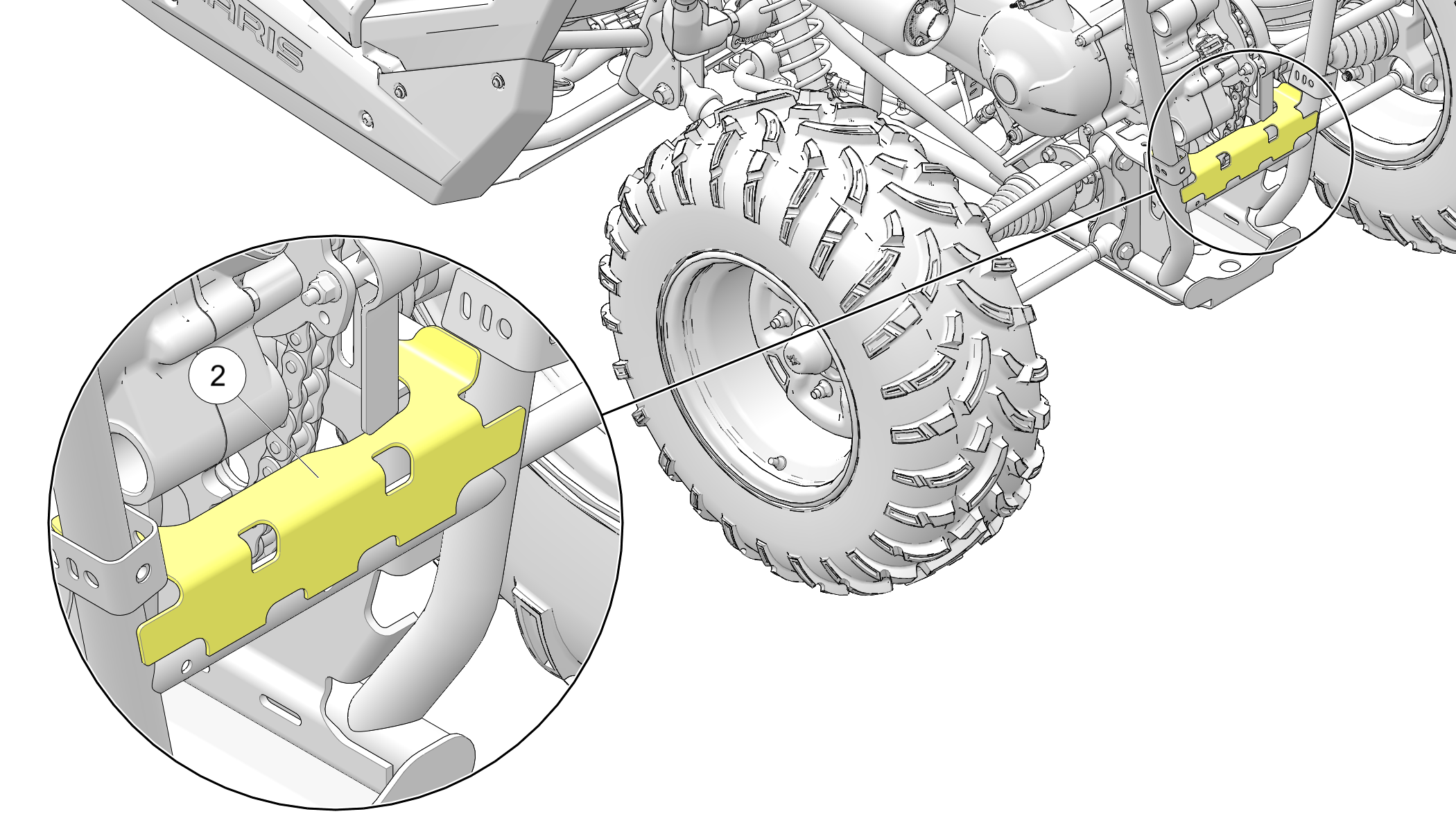
2 Rear tie-down points
| Vehicle Dimensions | |
|---|---|
| Length | 85 in (215.9 cm) |
| Width | 48 in (121.9 cm) |
| Height | 58 in (147.3 cm) |
| Wheel Base | 65 in (165 cm) |
| Ground Clearance | 9 in (22.9 cm) |
| Minimum Turning Radius | 110 in (279.4 cm) |
| Gross Vehicle Weight | 1060 lb (481 kg) |
| Dry Weight | 743 lb (337 kg) |
| Rear Rack/Box Capacity | 50 lb (23 kg) |
| Maximum Rider Weight | 150 lb (68 kg) (each rider) |
| Maximum Weight Capacity |
350 lb
(158 kg)
(Driver + Cargo) |
| Engine | |
|---|---|
| Platform | Single Cylinder, Air/Oil Cooled 4-Stroke |
| Engine Displacement (cc) | 180 cc |
| Number of Cylinders | 1 |
| Bore & Stroke (mm) | 62.0 x 57.8 mm |
| Compression Ratio | 9.6:1 |
| Engine Idle Speed | 1500 RPM |
| Engine Max Engine Speed (Fuel Cutoff) | 8000 RPM |
| Cooling System | Air + Oil |
| Overheat Warning | Instrument Cluster Indicator |
| Lubrication | PS-4 Synthetic 5W-50 4-Cycle Oil |
| Engine Oil Requirement / Capacity | 35.5 oz (1050 ml) |
| Exhaust System | Single Headpipe / Single Silencer |
| Fuel System | |
|---|---|
| Throttle Body / Size | Bosch® / 32 mm |
| Fuel Delivery | Electronic Fuel Pump (in tank) |
| Fuel Pressure | 4 bar / 58 psi (400 kPa) |
| Fuel Capacity | 2.5 gal (9.5 l) |
| Fuel Requirements | 87 Octane (minimum) |
| Electrical | |
|---|---|
| Alternator Output | 11.5 AMP @ 4000 RPM |
| Voltage Regulator | 3 Phase, 35 AMP |
| Daytime Running Lights | 2 - Single Beam Daytime Running Lamps (DRL) |
| Tail / Brake Lights | Single Tail Light |
| Ignition Timing | Non-Adjustable |
| Spark plug / Gap | NGK® CR7HSA (.024 - .028 (0.6 - 0.7 mm)) |
| Battery | 10 AH / 160 CCA |
| Relays (Located in Relay/Fuse Box) |
EFI Fuel Pump |
| Fuses (Located in Relay/Fuse Box) |
Main Fuse:
20 Amp EFI: 15 Amp Lights: 10 Amp Brake LT: 10 Amp Spare: 10 Amp Spare: 15 Amp Spare: 20 Amp Spare: 7.5 Amp Spare: 30 Amp Batt Tend: 10 Amp Fuel Pump: 10 Amp IGN Lights: 7.5 Amp EFI: 10 Amp CHS/STRT: 7.5 Amp |
| Drivetrain | |
|---|---|
| Transmission Type | Automatic CVT F/N/R |
| Transmission Fluid Type / Fluid Capacity |
Polaris AGL 25 oz (750 ml) |
| Drive Chain - Type / # Links | 50 x 55 |
| Steering / Suspension | |
|---|---|
| Toe Out | 0-1/8 in. / 0-3.2mm 0-1/8 in (0-3.2 mm) |
| Front Suspension |
Coil-Over Shocks |
| Front Travel | 7.0 in (17.8 cm) |
| Rear Suspension |
Coil-Over Shocks |
| Rear Travel | 7.0 in (17.8 cm) |
| Shock Preload Adjustment | Cam Adjustable (Factory Setting -Softest) |
| Wheels / Brakes | ||
|---|---|---|
| Front Wheel Size | 12 x 6 Stamped Steel | |
| Front Tire Brand/Size/Load Rating/Speed Rating | CST 24 x 8-12 38B | |
| Rear Wheel Size | 12 x 8 Stamped Steel | |
| Rear Tire Brand/Size/Load Rating/Speed Rating | CST 24 x 10-12 45B | |
| Tire Air Pressure | Front | 5 psi (34,5 kPa) |
| Rear | 5 psi (34,5 kPa) | |
| Brakes | Front Wheel
Hydraulic Disc Rear Axle Hydraulic Disc |
|
| Brake Fluid | Polaris DOT 4 Brake Fluid | |
| Clutch Settings | ||||
|---|---|---|---|---|
| Altitude | Shift Weight | Drive Spring | Driven Spring | |
| Meters (Feet) |
0-3000 (0-10,000) |
No changes for high altitude. |
||
See your POLARIS dealer or qualified person for clutching specifications.
For operation at high elevation, different clutching parts may be needed. See your POLARIS dealer for more information.
| PART NUMBER | DESCRIPTION |
|---|---|
| 2870791 | Fogging Oil (12 oz. Aerosol) |
| 2876244 | PS-4 Synthetic 5W-50 4-Cycle Oil (qt./.95 l) |
| 2876245 | PS-4 Synthetic 5W-50 4-Cycle Oil (gal./3.8 l) |
| PART NUMBER | DESCRIPTION |
|---|---|
| 2878068 | AGL Full Synthetic Gearcase Lubricant & Transmission Fluid (qt./.95 l) |
| 2878069 | AGL Full Synthetic Gearcase Lubricant & Transmission Fluid (gal./3.8 l) |
| 2872348 | Chain Lube, Aerosol |
| PART NUMBER | DESCRIPTION |
|---|---|
| 2871312 | Grease Gun Kit, Premium All Season |
| 2871322 | All Season Grease (3 oz./89 ml cartridge) |
| 2871423 | All Season Grease (14 oz./414 ml cartridge) |
| PART NUMBER | DESCRIPTION |
|---|---|
| 2881413 | Carbon Clean |
| 2881416 | Fuel Stabilizer |
| 2872189 | DOT 4 Brake Fluid |
|
Possible Cause |
Solution |
|---|---|
|
Driving onto a pickup or tall trailer in high range |
Use low range during loading. |
|
Starting out going up a steep incline |
Use low range. |
|
Driving at low RPM or ground speed – 3–7 mph (5 –12 kph) |
Drive at a higher speed or use low range more frequently. |
|
Insufficient warm-up at low ambient temperatures |
Warm the engine at least 5 minutes. With the transmission in neutral, advance the throttle to about 1/8 throttle in short bursts, five to seven times. The belt will become more flexible and prevent belt burning. Always warm up the belt by operating below 30 mph (48 km/h) for 1 mile (1.6 km). When the temperature is below freezing, extend the belt warming time to 5 miles (8 km). |
|
Slow/easy clutch engagement |
Use the throttle quickly and effectively. |
|
Towing/pushing at low RPM/low ground speed |
Use low range only. |
|
Utility use/plowing |
Use low range only. |
|
Stuck in mud or snow |
Shift the transmission to low range and carefully use fast, aggressive throttle application to engage clutch. WARNING: Excessive throttle may cause loss of control and vehicle rollover. |
|
Climbing over large objects from a stopped position |
Shift the transmission to low range and carefully use fast, brief, aggressive throttle application to engage clutch. WARNING: Excessive throttle may cause loss of control and vehicle rollover. |
|
Belt slippage from water or snow ingestion into the PVT system |
Dry out the PVT. See PVT Drying procedure. Prevent water from entering the PVT intake duct. See Intake Pre-Filters for more information. Inspect clutch seals for damage if repeated leaking occurs. |
|
Clutch malfunction |
See your POLARIS dealer or other qualified person |
|
Poor engine performance |
Check for clogged air filter, clogged fuel filter, water in the fuel or foreign material in fuel tank or fuel lines. An authorized dealer can assist. |
|
Wrong belt |
Install the recommended belt. |
|
Improper break-in |
Always break in a new belt and/or clutch. See PVT Break-in procedure. |
| Possible Cause | Solution |
|---|---|
|
Low battery voltage |
Recharge the battery to 12.8 VDC. |
|
Loose battery connections |
Check all connections and tighten. |
|
Loose solenoid connections |
Check all connections and tighten. |
| Possible Cause | Solution |
|---|---|
| Out of fuel | Refuel. |
| Water is present in fuel | Drain the fuel system and refuel. |
| Old or non-recommended fuel | Replace with fresh recommended fuel. |
| Fouled or defective spark plug | Inspect plug and replace if necessary. |
| No spark to spark plug | Inspect plug and replace if necessary. |
| Water or fuel in crankcase | See your POLARIS dealer or other qualified person |
| Clogged Fuel Filter | See your POLARIS dealer or other qualified person |
| Low battery voltage | Recharge the battery to 12.8 VDC. |
| Mechanical failure | See your POLARIS dealer or other qualified person |
| Possible Cause | Solution |
|---|---|
| Weak spark from spark plug | Inspect, clean and/or replace spark plug. |
| Incorrect spark plug gap or heat range | Set gap to specs or replace plug. |
| Old or non-recommended fuel | Replace with fresh recommended fuel. |
| Incorrectly installed spark plug wires | See your POLARIS dealer or other qualified person |
| Mechanical failure | See your POLARIS dealer or other qualified person |
| Loose ignition connections | Check all connections and tighten. |
| Water present in fuel | Replace with fresh recommended fuel. |
| Exhaust system leak | See your POLARIS dealer or other qualified person |
| Possible Cause | Solution |
|---|---|
| Poor quality or low octane fuel | Replace with recommended fuel |
| Incorrect ignition timing | See your POLARIS dealer or other qualified person |
| Incorrect spark plug gap or heat range | Set gap to specs or replace plugs |
| Possible Cause | Solution |
|---|---|
| Fouled or defective spark plug(s) | Inspect, clean and/or replace spark plugs |
| Worn or defective spark plug wires | See your POLARIS dealer or other qualified person |
| Incorrect spark plug gap or heat range | Set gap to specs or replace plugs |
| Loose ignition connections | Check all connections and tighten |
| Water present in fuel | Replace with new fuel |
| Low battery voltage | Recharge battery to 12.8 VDC |
| Kinked or plugged fuel tank vent line | Inspect and replace |
| Incorrect fuel | Replace with recommended fuel |
| Clogged air filter | Inspect and clean or replace |
| Reverse speed limiter malfunction | See your POLARIS dealer or other qualified person |
| Electronic throttle control malfunction | See your POLARIS dealer or other qualified person |
| Other mechanical failure | See your POLARIS dealer or other qualified person |
| Possible Lean Fuel Cause | Solution |
|---|---|
| Low or contaminated fuel | Add or change fuel, clean the fuel system |
| Low octane fuel | Replace with recommended fuel |
| Clogged air filter | See your POLARIS dealer or other qualified person |
| Incorrect fuel | Replace with recommended fuel |
| Possible Rich Fuel Cause | Solution |
|---|---|
| Fuel is very high octane | Replace with lower octane fuel |
| Stopping/starting without adequate warm-up | Allow engine to warm up before operating and/or stopping |
| Incorrect fuel | Replace with recommended fuel |
| Clogged air filter | Inspect and clean or replace |
| Possible Cause | Solution |
|---|---|
| Out of fuel | Refuel, cycle key to ON position three times for 5 seconds each, then start |
| Kinked or plugged fuel vent line | Inspect and replace |
| Water is present in fuel | Replace with new fuel |
| Fouled or defective spark plug(s) | Inspect, clean and/or replace spark plugs |
| Worn or defective spark plug wires | See your POLARIS dealer or other qualified person |
| Incorrect spark plug gap or heat range | Set gap to specs or replace plug |
| Loose ignition connections | Check all connections and tighten |
| Low battery voltage | Recharge the battery to 12.8 VDC |
| Incorrect fuel | Replace with fresh recommended fuel |
| Clogged air filter | Inspect and clean or replace |
| Electronic throttle control malfunction | See your POLARIS dealer or other qualified person |
| Other mechanical failure | See your POLARIS dealer or other qualified person |
| SPN | FMI | COMPONENT | P-CODE | CONDITION |
|---|---|---|---|---|
| Displayed on instrument cluster | Displayed on Digital Wrench diagnostic software | |||
|
29 |
3 |
Accelerator Position 2 |
P1228 |
Voltage Above Normal, Or Shorted To High Source |
|
29 |
4 |
P1227 |
Voltage Below Normal, Or Shorted To Low Source |
|
|
51 |
3 |
Throttle Position Sensor 1 |
P0123 |
Voltage Above Normal, Or Shorted To High Source |
|
51 |
4 |
P0122 |
Voltage Below Normal, Or Shorted To Low Source |
|
|
84 |
2 |
Vehicle Speed Sensor |
P0503 |
Data Erratic, Intermittent Or Incorrect |
|
91 |
3 |
Accelerator Position 1 |
P0228 |
Voltage Above Normal, Or Shorted To High Source |
|
91 |
4 |
P0227 |
Voltage Below Normal, Or Shorted To Low Source |
|
|
96 |
2 |
Fuel Level Signal |
P0461 |
Data Erratic, Intermittent Or Incorrect |
|
96 |
3 |
P0463 |
Voltage Above Normal, Or Shorted To High Source |
|
|
96 |
4 |
P0462 |
Voltage Below Normal, Or Shorted To Low Source |
|
|
96 |
16 |
P1462 |
Data Valid But Above Normal Operating Range - Moderately Severe Level |
|
|
96 |
18 |
P1463 |
Data Valid But Below Normal Operating Range - Moderately Severe Level |
|
|
102 |
3 |
Manifold Absolute Pressure Sensor |
P0108 |
Voltage Above Normal, Or Shorted To High Source |
|
102 |
4 |
P0107 |
Voltage Below Normal, Or Shorted To Low Source |
|
|
105 |
0 |
Intake Air Temperature Sensor |
P1111 |
Data Valid But Above Normal Operational Range - Most Severe Level |
|
105 |
3 |
P0113 |
Voltage Above Normal, Or Shorted To High Source |
|
|
105 |
4 |
P0112 |
Voltage Below Normal, Or Shorted To Low Source |
|
|
108 |
3 |
Barometric Pressure Sensor |
P2229 |
Voltage Above Normal, Or Shorted To High Source |
|
108 |
4 |
P2228 |
Voltage Below Normal, Or Shorted To Low Source |
|
|
110 |
0 |
Engine Temperature Sensor |
P1217 |
Data Valid But Above Normal Operational Range - Most Severe Level |
|
110 |
2 |
P0116 |
Data Erratic, Intermittent Or Incorrect |
|
|
110 |
3 |
P0118 |
Voltage Above Normal, Or Shorted To High Source |
|
|
110 |
4 |
P0117 |
Voltage Below Normal, Or Shorted To Low Source |
|
|
110 |
10 |
P0119 |
Abnormal Rate Of Change |
|
|
110 |
15 |
P1116 |
Data Valid But Above Normal Operating Range - Least Severe Level |
|
|
110 |
16 |
P0217 |
Data Valid But Above Normal Operating Range - Moderately Severe Level |
|
|
110 |
17 |
P0128 |
Data Valid But Below Normal Operating Range - Least Severe Level |
|
|
168 |
0 |
System Power |
P1562 |
Data Valid But Above Normal Operational Range - Most Severe Level |
|
168 |
1 |
P1563 |
Data Valid But Below Normal Operational Range - Most Severe Level |
|
|
168 |
2 |
P0561 |
Data Erratic, Intermittent Or Incorrect |
|
|
168 |
3 |
P0563 |
Voltage Above Normal, Or Shorted To High Source |
|
|
168 |
4 |
P0562 |
Voltage Below Normal, Or Shorted To Low Source |
|
|
190 |
31 |
Engine Speed |
P121C |
Condition Exists |
|
523 |
2 |
Gear Sensor Signal |
P0914 |
Data Erratic, Intermittent Or Incorrect |
|
523 |
4 |
P0916 |
Voltage Below Normal, Or Shorted To Low Source |
|
|
523 |
9 |
P1914 |
Abnormal Update Rate |
|
|
527 |
31 |
Cruise Control Panel Switches |
P153D |
Condition Exists |
|
636 |
2 |
Crankshaft Position Sensor |
P0335 |
Data Erratic, Intermittent Or Incorrect |
|
637 |
8 |
Camshaft Position Sensor |
P0340 |
Abnormal Frequency Or Pulse Width Or Period |
|
651 |
3 |
Injector 1 (Front) (MAG) (SDI Port Injector) |
P0262 |
Voltage Above Normal, Or Shorted To High Source |
|
651 |
4 |
P1262 |
Voltage Below Normal, Or Shorted To Low Source |
|
|
651 |
5 |
P0261 |
Current Below Normal Or Open Circuit |
|
|
652 |
3 |
Injector 2 (Rear) (PTO) (SDI Port Injector) |
P0265 |
Voltage Above Normal, Or Shorted To High Source |
|
652 |
4 |
P1265 |
Voltage Below Normal, Or Shorted To Low Source |
|
|
652 |
5 |
P0264 |
Current Below Normal Or Open Circuit |
|
|
677 |
3 |
Starter Solenoid Driver Circuit |
P0617 |
Voltage Above Normal, Or Shorted To High Source |
|
677 |
4 |
P0616 |
Voltage Below Normal, Or Shorted To Low Source |
|
|
677 |
5 |
P0615 |
Current Below Normal Or Open Circuit |
|
|
731 |
1 |
Knock Sensor 1 |
P0326 |
Data Valid But Below Normal Operational Range - Most Severe Level |
|
746 |
3 |
Rear Differential Output (Turf) |
P1692 |
Voltage Above Normal, Or Shorted To High Source |
|
746 |
4 |
P1693 |
Voltage Below Normal, Or Shorted To Low Source |
|
|
746 |
5 |
P1691 |
Current Below Normal Or Open Circuit |
|
|
876 |
3 |
AC Compressor Clutch Relay |
P0647 |
Voltage Above Normal, Or Shorted To High Source |
|
876 |
4 |
P0646 |
Voltage Below Normal, Or Shorted To Low Source |
|
|
876 |
5 |
P0645 |
Current Below Normal Or Open Circuit |
|
|
1071 |
3 |
Fan Relay Driver Circuit |
P1482 |
Voltage Above Normal, Or Shorted To High Source |
|
1071 |
4 |
P1483 |
Voltage Below Normal, Or Shorted To Low Source |
|
|
1071 |
5 |
P1481 |
Current Below Normal Or Open Circuit |
|
|
1127 |
0 |
Boost Pressure Sensor |
P0234 |
Data Valid But Above Normal Operational Range - Most Severe Level |
|
1127 |
2 |
P0236 |
Data Erratic, Intermittent Or Incorrect |
|
|
1127 |
3 |
P0238 |
Voltage Above Normal, Or Shorted To High Source |
|
|
1127 |
4 |
P0237 |
Voltage Below Normal, Or Shorted To Low Source |
|
|
1127 |
31 |
P1234 |
Condition Exists |
|
|
1213 |
3 |
Malfunction Indicator Lamp |
P1653 |
Voltage Above Normal, Or Shorted To High Source |
|
1213 |
4 |
P1652 |
Voltage Below Normal, Or Shorted To Low Source |
|
|
1213 |
5 |
P1651 |
Current Below Normal Or Open Circuit |
|
|
1268 |
3 |
Ignition Coil Primary Driver 1 (Front) (MAG) |
P1353 |
Voltage Above Normal, Or Shorted To High Source |
|
1269 |
3 |
Ignition Coil Primary Driver 2 (Rear) (PTO) |
P1354 |
Voltage Above Normal, Or Shorted To High Source |
|
1347 |
3 |
Fuel Pump Driver Circuit |
P0232 |
Voltage Above Normal, Or Shorted To High Source |
|
1347 |
4 |
P0231 |
Voltage Below Normal, Or Shorted To Low Source |
|
|
1347 |
5 |
P0230 |
Current Below Normal Or Open Circuit |
|
|
1557 |
3 |
Fan Driver 2 |
P0694 |
Voltage Above Normal, Or Shorted To High Source |
|
1557 |
4 |
P0693 |
Voltage Below Normal, Or Shorted To Low Source |
|
|
1557 |
5 |
P0481 |
Current Below Normal Or Open Circuit |
|
|
1856 |
3 |
Seat Belt Switch |
B1150 |
Voltage Above Normal, Or Shorted To High Source |
|
1856 |
4 |
B1250 |
Voltage Below Normal, Or Shorted To Low Source |
|
|
1856 |
5 |
B1350 |
Current Below Normal Or Open Circuit |
|
|
1856 |
31 |
Condition Exists |
||
|
2629 |
3 |
Engine Turbocharger 1 Compressor Outlet Temperature |
P1235 |
Voltage Above Normal, Or Shorted To High Source |
|
2629 |
4 |
P1236 |
Voltage Below Normal, Or Shorted To Low Source |
|
|
3056 |
2 |
Oxygen Sensor Bank 1 Sensor 1 |
P0130 |
Data Erratic, Intermittent Or Incorrect |
|
3056 |
3 |
P0132 |
Voltage Above Normal, Or Shorted To High Source |
|
|
3056 |
4 |
P0131 |
Voltage Below Normal, Or Shorted To Low Source |
|
|
3056 |
5 |
P1134 |
Current Below Normal Or Open Circuit |
|
|
3056 |
12 |
P113A |
Bad Intelligent Device Or Component |
|
|
3597 |
3 |
ECU Output Supply Voltage 1 |
P16A2 |
Voltage Above Normal, Or Shorted To High Source |
|
3597 |
4 |
P16A1 |
Voltage Below Normal, Or Shorted To Low Source |
|
|
3598 |
3 |
ECU Output Supply Voltage 2 |
P16A9 |
Voltage Above Normal, Or Shorted To High Source |
|
3598 |
4 |
P16A8 |
Voltage Below Normal, Or Shorted To Low Source |
|
|
3599 |
3 |
ECU Output Supply Voltage 3 |
P17AA |
Voltage Above Normal, Or Shorted To High Source |
|
3599 |
4 |
P17AB |
Voltage Below Normal, Or Shorted To Low Source |
|
|
65590 |
7 |
Cylinder Misfire |
P0314 |
Mechanical System Not Responding Or Out Of Adjustment |
|
65591 |
7 |
Cylinder 1 Misfire |
P0301 |
Mechanical System Not Responding Or Out Of Adjustment |
|
65592 |
7 |
Cylinder 2 Misfire |
P0302 |
Mechanical System Not Responding Or Out Of Adjustment |
|
65613 |
2 |
ETC Accelerator Position Sensor Outputs 1 & 2 Correlation |
P1135 |
Data Erratic, Intermittent Or Incorrect |
|
520194 |
2 |
Throttle Release Signal |
P1553 |
Data Erratic, Intermittent Or Incorrect |
|
520194 |
3 |
P1555 |
Voltage Above Normal, Or Shorted To High Source |
|
|
520194 |
4 |
P1554 |
Voltage Below Normal, Or Shorted To Low Source |
|
|
520194 |
7 |
P1552 |
Mechanical System Not Responding Or Out Of Adjustment |
|
|
520198 |
3 |
Throttle Position Sensor 2 |
P0223 |
Voltage Above Normal, Or Shorted To High Source |
|
520198 |
4 |
P0222 |
Voltage Below Normal, Or Shorted To Low Source |
|
|
520200 |
2 |
Rollover Sensor (Tipover) |
P1501 |
Data Erratic, Intermittent Or Incorrect |
|
520200 |
3 |
P1503 |
Voltage Above Normal, Or Shorted To High Source |
|
|
520200 |
4 |
P1502 |
Voltage Below Normal, Or Shorted To Low Source |
|
|
520200 |
14 |
P1504 |
Special Instructions |
|
|
520202 |
3 |
Canister Purge Valve |
Voltage Above Normal, Or Shorted To High Source |
|
|
520202 |
4 |
P0445 |
Voltage Below Normal, Or Shorted To Low Source |
|
|
520202 |
5 |
Current Below Normal Or Open Circuit |
||
|
520203 |
3 |
Front Wheel Back Drive (Active Descent System) |
P1686 |
Voltage Above Normal, Or Shorted To High Source |
|
520203 |
4 |
P1687 |
Voltage Below Normal, Or Shorted To Low Source |
|
|
520203 |
5 |
P1685 |
Current Below Normal Or Open Circuit |
|
|
520204 |
15 |
Fuel Correction Front |
P0172 |
Data Valid But Above Normal Operating Range - Least Severe Level |
|
520204 |
17 |
P0171 |
Data Valid But Below Normal Operating Range - Least Severe Level |
|
|
520205 |
15 |
Fuel Correction Rear |
P0175 |
Data Valid But Above Normal Operating Range - Least Severe Level |
|
520205 |
17 |
P0174 |
Data Valid But Below Normal Operating Range - Least Severe Level |
|
|
520206 |
2 |
Reverse Alarm |
P1684 |
Data Erratic, Intermittent Or Incorrect |
|
520206 |
3 |
P1682 |
Voltage Above Normal, Or Shorted To High Source |
|
|
520206 |
4 |
P1683 |
Voltage Below Normal, Or Shorted To Low Source |
|
|
520206 |
5 |
P1681 |
Current Below Normal Or Open Circuit |
|
|
520207 |
3 |
All Wheel Drive Control Circuit |
P1835 |
Voltage Above Normal, Or Shorted To High Source |
|
520207 |
4 |
P1834 |
Voltage Below Normal, Or Shorted To Low Source |
|
|
520207 |
5 |
P1836 |
Current Below Normal Or Open Circuit |
|
|
520208 |
3 |
Chassis Relay |
P1614 |
Voltage Above Normal, Or Shorted To High Source |
|
520208 |
4 |
P1613 |
Voltage Below Normal, Or Shorted To Low Source |
|
|
520208 |
5 |
P1611 |
Current Below Normal Or Open Circuit |
|
|
520209 |
2 |
Oxygen Sensor Heater 1 |
P0135 |
Data Erratic, Intermittent Or Incorrect |
|
520209 |
3 |
Voltage Above Normal, Or Shorted To High Source |
||
|
520209 |
4 |
P0031 |
Voltage Below Normal, Or Shorted To Low Source |
|
|
520209 |
5 |
Current Below Normal Or Open Circuit |
||
|
520210 |
2 |
Oxygen Sensor Heater 2 |
P0141 |
Data Erratic, Intermittent Or Incorrect |
|
520210 |
3 |
P0038 |
Voltage Above Normal, Or Shorted To High Source |
|
|
520210 |
4 |
P0037 |
Voltage Below Normal, Or Shorted To Low Source |
|
|
520210 |
5 |
P0036 |
Current Below Normal Or Open Circuit |
|
|
520211 |
3 |
Idle Speed |
P0507 |
Voltage Above Normal, Or Shorted To High Source |
|
520211 |
4 |
P0506 |
Voltage Below Normal, Or Shorted To Low Source |
|
|
520211 |
7 |
Mechanical System Not Responding Or Out Of Adjustment |
||
|
520268 |
3 |
Idle Air Control M17 Stepper Pin 3 |
P1519 |
Voltage Above Normal, Or Shorted To High Source |
|
520268 |
4 |
P1518 |
Voltage Below Normal, Or Shorted To Low Source |
|
|
520268 |
5 |
P1515 |
Current Below Normal Or Open Circuit |
|
|
520269 |
3 |
Idle Air Control M17 Stepper Pin 4 |
P1529 |
Voltage Above Normal, Or Shorted To High Source |
|
520269 |
4 |
P1528 |
Voltage Below Normal, Or Shorted To Low Source |
|
|
520269 |
5 |
P1525 |
Current Below Normal Or Open Circuit |
|
|
520270 |
3 |
Idle Air Control M17 Stepper Pin 6 |
P1539 |
Voltage Above Normal, Or Shorted To High Source |
|
520270 |
4 |
P1538 |
Voltage Below Normal, Or Shorted To Low Source |
|
|
520270 |
5 |
P1535 |
Current Below Normal Or Open Circuit |
|
|
520271 |
3 |
Idle Air Control M17 Stepper Pin 1 |
P1509 |
Voltage Above Normal, Or Shorted To High Source |
|
520271 |
4 |
P1508 |
Voltage Below Normal, Or Shorted To Low Source |
|
|
520271 |
5 |
P1505 |
Current Below Normal Or Open Circuit |
|
|
520275 |
31 |
Accelerator Position/Brake Position Interaction |
P150A |
Condition Exists |
|
520276 |
2 |
Throttle Position Sensor (1 or 2 Indeterminable) |
P150C |
Data Erratic, Intermittent Or Incorrect |
|
520276 |
12 |
P150B |
Bad Intelligent Device Or Component |
|
|
520277 |
2 |
Throttle Body Control - Power Stage |
P151A |
Data Erratic, Intermittent Or Incorrect |
|
520277 |
3 |
P150D |
Voltage Above Normal, Or Shorted To High Source |
|
|
520277 |
4 |
P150E |
Voltage Below Normal, Or Shorted To Low Source |
|
|
520277 |
8 |
P151B |
Abnormal Frequency Or Pulse Width Or Period |
|
|
520279 |
31 |
Throttle Body Control - Adaption Aborted |
P151D |
Condition Exists |
|
520280 |
31 |
Throttle Body Control - Limp Home Position Check Failed |
P151E |
Condition Exists |
|
520281 |
31 |
Throttle Body Control - Mechanical Stop Adaptation Failure |
P152A |
Condition Exists |
|
520282 |
31 |
Throttle Body Control - Repeated Adaptation Failed |
P152B |
Condition Exists |
|
520283 |
3 |
Throttle Body Control |
P152C |
Voltage Above Normal, Or Shorted To High Source |
|
520283 |
4 |
P152D |
Voltage Below Normal, Or Shorted To Low Source |
|
|
520284 |
31 |
Throttle Body Control - Position Deviation Fault |
P152E |
Condition Exists |
|
520285 |
2 |
Brake Switch (1 or 2 Indeterminable) |
P153E |
Data Erratic, Intermittent Or Incorrect |
|
520286 |
31 |
ECU Monitoring Error |
P1540 |
Condition Exists |
|
520287 |
31 |
ECU Monitoring Error (Level 3) |
P1541 |
Condition Exists |
|
520288 |
31 |
ECU Monitoring of Injection Cut Off (Level 1) |
P1542 |
Condition Exists |
|
520289 |
31 |
ECU Monitoring of Injection Cut Off (Level 2) |
P1543 |
Condition Exists |
|
520305 |
31 |
Throttle Body Control - Requested Throttle Angle Not Plausible |
P1530 |
Condition Exists |
|
520306 |
31 |
ECU ADC Fault - No Load |
P1531 |
Condition Exists |
|
520307 |
31 |
ECU ADC Fault - Voltage |
P1532 |
Condition Exists |
|
520308 |
31 |
Accelerator Sensor Sync Fault - Sensor Diff Exceeds Limit |
P1533 |
Condition Exists |
|
520309 |
31 |
ECU Fault - ICO |
P1534 |
Condition Exists |
|
520311 |
31 |
ECU Fault - Hardware Disruption |
P1537 |
Condition Exists |
|
520329 |
9 |
Operator Switch Status (pOSS1) |
P1063 |
Abnormal Update Rate |
|
520331 |
3 |
Knock Sensor Positive Line |
P1327 |
Voltage Above Normal, Or Shorted To High Source |
|
520331 |
4 |
P1328 |
Voltage Below Normal, Or Shorted To Low Source |
|
|
520332 |
3 |
Knock Sensor Negative Line |
P132A |
Voltage Above Normal, Or Shorted To High Source |
|
520332 |
4 |
P132B |
Voltage Below Normal, Or Shorted To Low Source |
|
|
520333 |
2 |
Oxygen Sensor Bank 1 Sensor 2(3057 Duplicate) |
P1136 |
Data Erratic, Intermittent Or Incorrect |
|
520333 |
3 |
P1137 |
Voltage Above Normal, Or Shorted To High Source |
|
|
520333 |
4 |
P1138 |
Voltage Below Normal, Or Shorted To Low Source |
|
|
520333 |
5 |
P3136 |
Current Below Normal Or Open Circuit |
|
|
520333 |
12 |
P1139 |
Bad Intelligent Device Or Component |
|
|
520336 |
31 |
ECU Monitoring (Pedal Map Mismatch) |
P1545 |
Condition Exists |
|
520338 |
31 |
Gross Air Leak |
P2279 |
Condition Exists |
|
520341 |
3 |
Wastegate Solenoid Driver |
P0243 |
Voltage Above Normal, Or Shorted To High Source |
|
520341 |
4 |
P0246 |
Voltage Below Normal, Or Shorted To Low Source |
|
|
520341 |
5 |
P0245 |
Current Below Normal Or Open Circuit |
|
|
520342 |
15 |
Idle Fuel Correction Bank 1 |
P116C |
Data Valid But Above Normal Operating Range - Least Severe Level |
|
520342 |
17 |
P116D |
Data Valid But Below Normal Operating Range - Least Severe Level |
|
|
520343 |
15 |
Idle Fuel Correction Bank 2 |
P116E |
Data Valid But Above Normal Operating Range - Least Severe Level |
|
520343 |
17 |
P116F |
Data Valid But Below Normal Operating Range - Least Severe Level |
|
|
520344 |
15 |
Adaptive Fuel Correction Bank 1 |
P0170 |
Data Valid But Above Normal Operating Range - Least Severe Level |
|
520344 |
17 |
P1170 |
Data Valid But Below Normal Operating Range - Least Severe Level |
|
|
520345 |
15 |
Adaptive Fuel Correction Bank 2 |
P0173 |
Data Valid But Above Normal Operating Range - Least Severe Level |
|
520345 |
17 |
P1173 |
Data Valid But Below Normal Operating Range - Least Severe Level |
|
|
520346 |
31 |
Upstream O2 Sensor Signals Swapped |
P1416 |
Condition Exists |
|
520467 |
31 |
Momentary Driveline Left Press |
P071A |
Condition Exists |
|
520468 |
31 |
Momentary Driveline Right Press |
P071D |
Condition Exists |
|
520496 |
3 |
Intercooler Pump Driver Circuit |
P107D |
Voltage Above Normal, Or Shorted To High Source |
|
520496 |
4 |
P107C |
Voltage Below Normal, Or Shorted To Low Source |
|
|
520496 |
5 |
P107E |
Current Below Normal Or Open Circuit |
|
|
520624 |
3 |
AC Condenser Fan Relay |
P15F5 |
Voltage Above Normal, Or Shorted To High Source |
|
520624 |
4 |
P15F4 |
Voltage Below Normal, Or Shorted To Low Source |
|
|
520624 |
5 |
P15F3 |
Current Below Normal Or Open Circuit |
|
|
520625 |
3 |
Alternator Charge Disable Relay |
P1D45 |
Voltage Above Normal, Or Shorted To High Source |
|
520625 |
4 |
P1D44 |
Voltage Below Normal, Or Shorted To Low Source |
|
|
520625 |
5 |
P1D42 |
Current Below Normal Or Open Circuit |
|
|
524067 |
2 |
Drive Mode Select Switch |
P153C |
Data Erratic, Intermittent Or Incorrect |
|
524067 |
3 |
P153A |
Voltage Above Normal, Or Shorted To High Source |
|
|
524067 |
4 |
P153B |
Voltage Below Normal, Or Shorted To Low Source |
|
|
524072 |
31 |
Foot On Cruise Control Switch |
P154D |
Condition Exists |
|
524079 |
31 |
Cruise Control Input Checksum |
U0405 |
Condition Exists |
|
524080 |
31 |
Cruise Control Input Message Counter |
U1405 |
Condition Exists |
|
524081 |
31 |
Foot On Cruise Control Input Message Counter |
U1407 |
Condition Exists |
|
524082 |
31 |
Foot On Cruise Control Input Checksum |
U1406 |
Condition Exists |
|
524145 |
31 |
Reverse Override Switch |
P188C |
Condition Exists |
POLARIS Industries Inc., 2100 Highway 55, Medina, MN 55340 (POLARIS) gives a SIX MONTH LIMITED WARRANTY on all components of your POLARIS vehicle against defects in material or workmanship. Laws and regulations in your jurisdiction may give extra protection. POLARIS further warrants that the spark arrestor in this product will meet the efficiency requirements of USFS standard 5100-1d for at least 1000 hours when subjected to normal use and when maintenance and installation are in accordance with POLARIS recommendations.
This warranty covers parts and labor charges for repair or replacement of defective parts and begins on the date of purchase by the original retail purchaser. The duration of this warranty may vary by international region based upon local laws and regulations.
At the time of sale, the Warranty Registration Form must be completed by your dealer and submitted to POLARIS within ten days of purchase. Upon receipt of this registration, POLARIS will record the registration for warranty. No verification of registration will be sent to the purchaser as the copy of the Warranty Registration Form will be your proof of warranty coverage. If you have not signed the original registration and received the customer copy, please contact your dealer immediately. NO WARRANTY COVERAGE WILL BE ALLOWED UNLESS YOUR VEHICLE IS REGISTERED WITH POLARIS. Initial dealer preparation and set-up of your vehicle is very important in ensuring trouble-free operation. Purchasing a machine in the crate or without proper dealer set-up will void your warranty coverage.
The manufacturer will warrant this product to maintain an acceptable spark arresting effectiveness for a minimum of 1,000 hours, subject to normal use, with maintenance and mounting in accordance with the manufacturing recommendation.
This POLARIS limited warranty excludes any failures that are not caused by a defect in material or workmanship. THIS WARRANTY DOES NOT COVER CLAIMS OF DEFECTIVE DESIGN. This warranty also does not cover acts of God, accidental damage, normal wear and tear, abuse or improper handling. This warranty also does not cover any vehicle, component, or part that has been altered structurally, modified, neglected, improperly maintained or used for racing, competition or purposes other than for which it was designed.
This warranty excludes damages or failures resulting from improper lubrication; improper engine timing; improper fuel; surface imperfections caused by external stress, heat, cold or contamination; operator error or abuse; improper component alignment, tension, adjustment or altitude compensation; snow, water, dirt or other foreign substance ingestion/contamination; improper maintenance; modified components; use of aftermarket or unapproved components, accessories, or attachments; use of unapproved software or calibration; unauthorized repairs; or repairs made after the warranty period expires or by an unauthorized repair center.
This warranty excludes damages or failures caused by abuse, accident, fire, or any other cause other than a defect in materials or workmanship and provides no coverage for consumable components, general wear items, or any parts exposed to friction surfaces, stresses, environmental conditions and/or contamination for which they were not designed or not intended, including but not limited to the following items:
Wheels and tires
Suspension components
Brake components
Seat components
Clutches and components
Steering components
Batteries
Light bulbs/Sealed beam lamps
Filters
Lubricants
Bushings
Finished and unfinished surfaces
Carburetor/Throttle body components
Engine components
Drive belts
Hydraulic components and fluids
Circuit breakers/Fuses
Electronic components
Spark plugs
Sealants
Coolants
Bearings
Mixing oil brands or using non-recommended oil may cause engine damage. We recommend the use of POLARIS engine oil.
Damage or failure resulting from the use of non-recommended lubricants or fluids is not covered by this warranty.
This warranty provides no coverage for personal loss or expense, including mileage, transportation costs, hotels, meals, shipping or handling fees, product pick-up or delivery, replacement rentals, loss of product use, loss of profits, or loss of vacation or personal time.
THE EXCLUSIVE REMEDY FOR BREACH OF THIS WARRANTY SHALL BE, AT POLARIS' OPTION, REPAIR OR REPLACEMENT OF ANY DEFECTIVE MATERIALS, COMPONENTS, OR PRODUCTS. THE REMEDIES SET FORTH IN THIS WARRANTY ARE THE ONLY REMEDIES AVAILABLE TO ANY PERSON FOR BREACH OF THIS WARRANTY. POLARIS SHALL HAVE NO LIABILITY TO ANY PERSON FOR INCIDENTAL, CONSEQUENTIAL OR SPECIAL DAMAGES OF ANY DESCRIPTION, WHETHER ARISING OUT OF EXPRESS OR IMPLIED WARRANTY OR ANY OTHER CONTRACT, NEGLIGENCE, OR OTHER TORT OR OTHERWISE. THIS EXCLUSION OF CONSEQUENTIAL, INCIDENTAL, AND SPECIAL DAMAGES IS INDEPENDENT FROM AND SHALL SURVIVE ANY FINDING THAT THE EXCLUSIVE REMEDY FAILED OF ITS ESSENTIAL PURPOSE.
THE IMPLIED WARRANTY OF FITNESS FOR A PARTICULAR PURPOSE IS EXCLUDED FROM THIS LIMITED WARRANTY. ALL OTHER IMPLIED WARRANTIES (INCLUDING BUT NOT LIMITED TO THE IMPLIED WARRANTY OF MERCHANTABILITY) ARE LIMITED IN DURATION TO THE ABOVE SIX MONTH WARRANTY PERIOD. POLARIS DISCLAIMS ALL EXPRESS WARRANTIES NOT STATED IN THIS WARRANTY. SOME STATES DO NOT PERMIT THE EXCLUSION OR LIMITATION OF INCIDENTAL OR CONSEQUENTIAL DAMAGES OR ALLOW LIMITATIONS ON THE DURATION OF IMPLIED WARRANTIES, SO THE ABOVE LIMITATIONS MAY NOT APPLY TO YOU IF INCONSISTENT WITH CONTROLLING STATE LAW.
If your vehicle requires warranty service, you must take it to a POLARIS Servicing Dealer. When requesting warranty service you must present your copy of the Warranty Registration Form to the dealer. (THE COST OF TRANSPORTATION TO AND FROM THE DEALER IS YOUR RESPONSIBILITY.) POLARIS suggests that you use your original selling dealer; however, you may use any POLARIS Servicing Dealer to perform warranty service.
EXCEPT WHERE SPECIFICALLY REQUIRED BY LAW, THERE IS NO WARRANTY OR SERVICE BULLETIN COVERAGE ON THIS PRODUCT IF IT IS SOLD OUTSIDE THE COUNTRY OF THE SELLING DEALER'S AUTHORIZED LOCATION. This policy does not apply to products that have received authorization for export from POLARIS. Dealers may not give authorization for export. You should consult an authorized dealer to determine this product's warranty or service coverage if you have any questions. This policy does not apply to products registered to government officials or military personnel on assignment outside the country of the selling dealer's authorized location. This policy does not apply to Safety Bulletins.
If your product is registered outside of the country where it was purchased and you have not followed the procedure set above, your product will no longer be eligible for warranty or service bulletin coverage of any kind, other than safety recalls. Products registered to government officials or military personnel on assignment outside of the country where the product was purchased will continue to be covered by the Limited Warranty.
Please work with your dealer to resolve any warranty issues. Dealership contacts can be found via this website, if needed:
www.polaris.com/en-us/contact
Should your dealer require any additional assistance, they will contact the appropriate person at POLARIS.
This warranty gives you specific legal rights, and you may also have other rights which vary from state to state or in different countries. If any of the above terms are void because of federal, state, local law, all other warranty terms will remain in effect.
For questions call POLARIS Owner Connections:
United States & Canada: 1-800-POLARIS (1-800-765-2747)
French: 1-800-268-6334
To report a safety defect to Transport Canada, you may either fill
out an online defect complaint form at their website:
English: http://www.tc.gc.ca/recalls
French: http://www.tc.gc.ca/rappels
Or contact their Defect Investigations and Recalls Division by calling toll-free 1-800-333-0510 (Canada) or 819-994-3328 (Ottawa-Gatineau area / International).
This emissions limited warranty is in addition to the Polaris standard limited warranty for your vehicle. Polaris Industries Inc. warrants that at the time it is first purchased, this emissions-certified vehicle is designed, built and equipped so it conforms with applicable U.S. Environmental Protection Agency emission regulations. Polaris warrants that the vehicle is free from defects in materials and workmanship that would cause it to fail to meet these regulations.
The warranty period for off road vehicles 100cc or greater emissions-certified vehicles starts on the date of purchase by original retail purchaser and continues for a period of 500 hours of engine operation, 5000 kilometers (3100 miles) of vehicle travel, or 30 calendar months from the date of purchase, whichever comes first. The warranty period for ATVs less than 100cc emissions-certified vehicles starts on the date of purchase by original retail purchaser and continues for a period of 250 hours of engine operation, 2500 kilometers (1550 miles) of vehicle travel, or 30 calendar months from the date of purchase, whichever comes first. This EPA emissions warranty period is extended for at least as long as the standard factory warranty that Polaris provides on the vehicle as a whole. The EPA emissions warranty period does not further extend if you purchase additional warranty coverage in the form of a service contract or other paid warranty extension, but emission-related parts may be covered subject to the terms of any such paid service contract or paid warranty extension.
This emissions limited warranty covers components whose failure increases the vehicle's regulated emissions, and it covers components of systems whose only purpose is to control emissions. Repairing or replacing other components not covered by this warranty is the responsibility of the vehicle owner. This emissions limited warranty does not cover components whose failure does not increase the vehicle's regulated emissions.
For exhaust emissions, emission-related components include any engine parts related to the following systems:
Air-induction system
Fuel system
Ignition system
Exhaust gas recirculation systems
The following parts are also considered emission-related components for exhaust emissions:
Aftertreatment devices
Crankcase ventilation valves
Sensors
Electronic control units
The following parts are considered emission-related components for evaporative emissions:
Fuel Tank
Fuel Cap
Fuel Line
Fuel Line Fittings
Clamps*
Pressure Relief Valves*
Control Valves*
Control Solenoids*
Electronic Controls*
Vacuum Control Diaphragms*
Control Cables*
Control Linkages*
Purge Valves
Vapor Hoses
Liquid/Vapor Separator
Carbon Canister
Canister Mounting Brackets
Carburetor Purge Port Connector
*As related to the evaporative emission control system.
Emission-related components also include any other part whose only purpose is to reduce emissions or whose failure will increase emissions without significantly degrading engine/equipment performance. The exclusive remedy for breach of this limited warranty shall be, at the exclusive option of POLARIS, repair or replacement of any defective materials, components or products. THE REMEDIES SET FORTH IN THIS LIMITED WARRANTY ARE THE ONLY REMEDIES AVAILABLE TO ANY PERSON FOR BREACH OF THIS WARRANTY. POLARIS SHALL HAVE NO LIABILITY TO ANY PERSON FOR INCIDENTAL, CONSEQUENTIAL OR SPECIAL DAMAGES OF ANY DESCRIPTION, WHETHER ARISING OUT OF EXPRESS OR IMPLIED WARRANTY OR ANY OTHER CONTRACT, NEGLIGENCE OR OTHER TORT OR OTHERWISE. THIS EXCLUSION OF CONSEQUENTIAL, INCIDENTAL, AND SPECIAL DAMAGES IS INDEPENDENT FROM AND SHALL SURVIVE ANY FINDING THAT THE EXCLUSIVE REMEDY FAILED OF ITS ESSENTIAL PURPOSE.
ALL IMPLIED WARRANTIES (INCLUDING BUT NOT LIMITED TO ANY IMPLIED WARRANTIES OF MERCHANTABILITY AND FITNESS FOR A PARTICULAR PURPOSE) ARE LIMITED IN DURATION TO THE WARRANTY PERIOD DESCRIBED HEREIN. POLARIS DISCLAIMS ALL EXPRESS WARRANTIES NOT STATED IN THIS WARRANTY. Some states do not allow limitations on how long an implied warranty lasts, so the above limitation may not apply if it is inconsistent with the controlling state law.
Noncritical emission-related maintenance generally includes changing spark plugs, re-seating valves, or any other emission-related maintenance on the components we specify in 40 CFR part 1068, Appendix I that is not covered in paragraph (a) of this section. You must state in the owner's manual that these steps are not necessary to keep the emission-related warranty valid.
This limited warranty excludes failures not caused by a defect in material or workmanship. This limited warranty does not cover damage due to accidents, abuse or improper handling, maintenance or use. This limited warranty also does not cover any engine that has been structurally altered, or when the vehicle has been used in racing competition. This limited warranty also does not cover physical damage, corrosion or defects caused by fire, explosions or other similar causes beyond the control of POLARIS.
Owners are responsible for performing the scheduled maintenance identified in the owner's manual. POLARIS may deny warranty claims for failures that have been caused by the owner's or operator's improper maintenance or use, by accidents for which POLARIS has no responsibility, or by acts of God.
Any qualified repair shop or person may maintain, replace, or repair the emission control devices or systems on your vehicle. An authorized POLARIS dealer, or other qualified person, can perform any service that may be necessary for your vehicle. POLARIS also recommends POLARIS parts, however equivalent parts may be used for such service. It is a potential violation of the Clean Air Act if a part supplied by an aftermarket parts manufacturer reduces the effectiveness of the vehicle's emission controls. Tampering with emission controls is prohibited by federal law.
Certain POLARIS Off-Road Vehicles are available in 49-state and 50-state versions. Only the 50-state models are certified for sale in California. The 50-state models available for sale in California are identified by the letter “B” in the ninth position of the model number (e.g., R16RTE87B). The POLARIS 50-state models are designed and built with features such as a reduced cargo box capacity. Any modifications to these features may be a violation of the applicable California regulations and may void this limited emissions warranty offered by the manufacturer.
POLARIS Inc. warrants that at the time it is first purchased, this vehicle is:
Designed, built, and equipped so as to conform, at the time of sale, with all applicable California evaporative emissions regulations.
Free from defects in materials and workmanship that may cause the failure of a warranted part as defined in California evaporative emissions regulations. All replacement parts must be identical in all material respects to that part as described in the OHRV manufacturer's Executive Order of Certification application.
The California evaporative emissions control system limited warranty statement below applies to your Off Highway Recreational Vehicle in California if the vehicle is equipped with an evaporative emission control system and is labeled with a Vehicle Evaporative Emissions Control Information label indicating that the vehicle conforms to California evaporative emissions regulations applicable to new off-road sport vehicles, all-terrain vehicles, or off-road utility vehicles. These vehicles are referred to as “OHRV-EVAP” below.
CALIFORNIA EMISSION CONTROL WARRANTY STATEMENT YOUR WARRANTY RIGHTS AND OBLIGATIONS
The California Air Resources Board and POLARIS Industries Inc. is pleased to explain the emission control system warranty on your model year 2018 and newer Off Highway Recreational Vehicle. In California, new off-highway recreational vehicles must be designed, built and equipped to meet the State's stringent anti-smog standards. POLARIS must warrant the emission control system on your OHRV-EVAP for the periods of time listed below provided there has been no abuse, neglect or improper maintenance of your OHRV-EVAP.
Your emission control system may include parts such as the carburetor or fuel injection system, fuel tank, fuel hoses, carbon canister, engine computer and Evaporative Emissions Control System parts listed in the U.S.A. EPA Emissions Limited Warranty. Also included may be hoses, belts, connectors and other emission-related assemblies. Where a warrantable condition exists, POLARIS will repair your OHRV-EVAP at no cost to you including diagnosis, parts and labor.
MANUFACTURER’S WARRANTY COVERAGE
For model year 2018 and newer OHRV-EVAP models.
For 30 months, or 2500 miles, or 250 hours, whichever comes first, except for evaporative components over the OHRV high-priced warranty value, which is covered for 60 months, or 5000 miles, or 500 hours, whichever comes first. If any emission-related part on your OHRV-EVAP is defective, the part will be repaired or replaced by POLARIS.
OWNER'S WARRANTY RESPONSIBILITIES
As the OHRV-EVAP owner, you are responsible for the performance of the required maintenance listed in your owner's manual. POLARIS recommends that you retain all receipts covering maintenance on your OHRV-EVAP, but POLARIS cannot deny warranty solely for the lack of receipts or for your failure to ensure the performance of a scheduled maintenance.
As an owner you are responsible for presenting your OHRV-EVAP to an authorized POLARIS dealer as soon as a problem exists. The warranty repairs should be completed in a reasonable amount of time, not to exceed 30 days.
As an OHRV-EVAP owner, you should also be aware that POLARIS may deny you warranty coverage if your OHRV-EVAP or a part has failed due to abuse, neglect, improper maintenance or unapproved modifications.
ORV / OHRV
POLARIS must honor the CARB-approved California emission warranty included in the Owner’s Manual.
POLARIS is liable for damages to other vehicle components proximately caused by a failure under warranty of any California emissions-warranted part.
Any add-on or modified part exempted by the California Air Resources Board from the prohibitions of California Vehicle Code section 27156 may be used on a vehicle, engine, or trailer. Such use, in and of itself, shall not be grounds for disallowing a warranty claim made in accordance with California emission warranty requirements. POLARIS shall not be liable under CARB emissions warranty requirements to warranty failures of warranted parts caused by the use of an add-on modified part.
These requirements are based on the following provisions of the California Code of Regulations, which apply as written.
13 CCR §2419.1(d) Subject to the conditions and exclusions of subdivision (i), the warranty on emissions-related parts must function as follows.
— (7) The OHRV manufacturer is liable for damages to other vehicle components proximately caused by a failure, under warranty, of any warranted part.
— (10) Any add-on or modified part exempted by the Air Resources Board from the prohibitions of section 27156 of the California Vehicle Code may be used on an OHRV. Such use, in and of itself, will not be grounds for disallowing a warranty claim made under the provisions of this Article. The OHRV manufacturer is not liable under the provisions of this Article to warranty failures of warranted parts caused by the use of an add-on or modified part(s) unless such part(s) are also warranted.
ADD-ON OR MODIFIED PARTS
An add-on or modified part must be compliant with applicable CARB emission control standards. A violation of this requirement is punishable by civil and/or criminal punishment.
If you have any questions regarding your warranty rights and responsibilities, you should contact POLARIS Owner Connections at 1-800-POLARIS (1-800-765-2747) or the California Air Resources Board at 4001 Iowa Ave, Riverside, CA 92507.
United States & Canada: 1-800-POLARIS (1-800-765-2747)
HOW THE CALIFORNIA EMISSIONS WARRANTY ON EVAPORATIVE EMISSIONS PARTS MUST FUNCTION AS PRESCRIBED IN 13 CCR §2419.1
(1) Any warranted part which is not scheduled for replacement as part of maintenance in the Owner’s Manual must be warranted for the warranty period. If any such part fails during the warranty period, it must be repaired or replaced by POLARIS according to subdivision (4) below. Any such part repaired or replaced under warranty must be fully warranted.
(2) Any warranted part which is scheduled only for regular inspection in the Owner’s Manual must be warranted for the warranty period. A statement in such written instructions to the effect of “repair or replace as necessary” must not reduce the period of warranty coverage. Any such part repaired or replaced under warranty must be warranted for the remaining warranty period.
(3) Any warranted part which is scheduled for replacement as part of maintenance in the Owner’s Manual must be warranted for the period of time prior to the first scheduled replacement point for that part. If the part fails before the first scheduled replacement point, the part must be repaired or replaced by POLARIS according to subdivision (4). Any such part repaired or replaced under warranty must be warranted for the remainder of the period prior to the first scheduled replacement point for the part.
(4) Repair or replacement of any warranted part under the warranty provisions of this Article must be performed at no charge to the OHRV owner, at a warranty station, except in the case of a temporary repair when a warranted part or a warranty station is not reasonably available to the OHRV owner. In the event a temporary repair is permitted according to subdivision (8) below, repairs may be performed at any available service establishment, or by the owner, using any replacement part. POLARIS must reimburse the owner for his or her expenses including diagnostic charges for such temporary repair or replacement, not to exceed POLARIS' suggested retail price for all warranted parts replaced and labor charges based on the POLARIS recommended time allowance for the warranty repair and the geographically appropriate hourly labor rate.
(5) Notwithstanding the provisions of subdivision (4) above, warranty services or repairs must be provided at all POLARIS dealerships that are owned by POLARIS or franchised to service the subject OHRVs.
(6) The OHRV owner must not be charged for diagnostic labor which leads to the determination that a warranted part is, in fact, defective, provided that such diagnostic work is performed at a warranty station.
(7) POLARIS is liable for damages to other vehicle components proximately caused by a failure, under warranty, of any warranted part.
(8) Throughout the OHRV's evaporative emissions warranty period, POLARIS must maintain a supply of warranted parts sufficient to meet the expected demand for such parts. The lack of availability of such parts or the incompleteness of repairs within a reasonable time period, not to exceed 30 days from the time the OHRV is initially presented to the warranty station for repair, will qualify the need for a temporary repair for purposes of subdivision (4).
(9) Any replacement part designated by POLARIS may be used in warranty repairs provided without charge to the OHRV owner. Such use will not reduce the warranty obligations of POLARIS, except that POLARIS will not be liable under the provisions of this Article for repair or replacement of any replacement part which is not a warranted part (except as provided under subdivision (d)(7)).
(10) Any add-on or modified part exempted by the Air Resources Board from the prohibitions of section 27156 of the California Vehicle Code may be used on an OHRV. Such use, in and of itself, will not be grounds for disallowing a warranty claim made under the provisions of this Article. POLARIS is not liable under the provisions of this Article to warrant failures of warranted parts caused by the use of an add-on or modified part(s) unless such part(s) are also warranted.
(11) Upon a request of the Executive Officer, POLARIS must provide any documents that describe the manufacturer's warranty procedures or policies.
(12) Any replacement part must not reduce the effectiveness of the OHRV emission control system. POLARIS must demonstrate that the applicable emission standards are being met when the replacement part(s) are installed on the OHRV. The demonstration of equivalence to applicable emission standards can be achieved through replacing the part(s) with the evaporative emissions control components the OHRV evaporative family was certified with; or, if unavailable, alternative parts may be installed if POLARIS can provide test data to verify the evaporative control system meets, at least, the OHRV EFEL.
EXCLUSION
Notwithstanding the provisions of subdivisions (1) - (12) above, the repair or replacement of any warranted part otherwise eligible for the California Warranty on Evaporative Emission Parts, is excluded from such warranty coverage if POLARIS can provide evidence to the California Air Resources Board Executive Officer, to the Executive Officer's satisfaction, that the OHRV has been abused, neglected, improperly maintained, or had unapproved modifications and that such abuse, neglect, improper maintenance, or unapproved modification, was the direct cause of the need for the repair or replacement of the part.
Use the following chart to record periodic maintenance.
| DATE | MILES (KM) or HOURS |
TECHNICIAN | SERVICE PERFORMED / COMMENTS |
|---|---|---|---|
Was this helpful?